GPT Essay Checker for Students
How to Interpret the Result of AI Detection
To use our GPT checker, you won’t need to do any preparation work!
Take the 3 steps:
- Copy and paste the text you want to be analyzed,
- Click the button,
- Follow the prompts to interpret the result.
Our AI detector doesn’t give a definitive answer. It’s only a free beta test that will be improved later. For now, it provides a preliminary conclusion and analyzes the provided text, implementing the color-coding system that you can see above the analysis.
It is you who decides whether the text is written by a human or AI:
- Your text was likely generated by an AI if it is mostly red with some orange words. This means that the word choice of the whole document is nowhere near unique or unpredictable.
- Your text looks unique and human-made if our GPT essay checker adds plenty of orange, green, and blue to the color palette.
- 🔮 The Tool’s Benefits

🤖 Will AI Replace Human Writers?
✅ ai in essay writing.
- 🕵 How do GPT checkers work?
Chat GPT in Essay Writing – the Shortcomings
- The tool doesn’t know anything about what happened after 2021. Novel history is not its strong side. Sometimes it needs to be corrected about earlier events. For instance, request information about Heathrow Terminal 1 . The program will tell you it is functioning, although it has been closed since 2015.
- The reliability of answers is questionable. AI takes information from the web which abounds in fake news, bias, and conspiracy theories.
- References also need to be checked. The links that the tool generates are sometimes incorrect, and sometimes even fake.
- Two AI generated essays on the same topic can be very similar. Although a plagiarism checker will likely consider the texts original, your teacher will easily see the same structure and arguments.
- Chat GPT essay detectors are being actively developed now. Traditional plagiarism checkers are not good at finding texts made by ChatGPT. But this does not mean that an AI-generated piece cannot be detected at all.
🕵 How Do GPT Checkers Work?
An AI-generated text is too predictable. Its creation is based on the word frequency in each particular case.
Thus, its strong side (being life-like) makes it easily discernible for ChatGPT detectors.
Once again, conventional anti-plagiarism essay checkers won’t work there merely because this writing features originality. Meanwhile, it will be too similar to hundreds of other texts covering the same topic.
Here’s an everyday example. Two people give birth to a baby. When kids become adults, they are very much like their parents. But can we tell this particular human is a child of the other two humans? No, if we cannot make a genetic test. This GPT essay checker is a paternity test for written content.
❓ GPT Essay Checker FAQ
Updated: Oct 25th, 2023
- Abstracts written by ChatGPT fool scientists - Nature
- How to... use ChatGPT to boost your writing
- Will ChatGPT Kill the Student Essay? - The Atlantic
- ChatGPT: how to use the AI chatbot taking over the world
- Overview of ChatGPT - Technology Hits - Medium
- Free Essays
- Writing Tools
- Lit. Guides
- Donate a Paper
- Referencing Guides
- Free Textbooks
- Tongue Twisters
- Job Openings
- Expert Application
- Video Contest
- Writing Scholarship
- Discount Codes
- IvyPanda Shop
- Terms and Conditions
- Privacy Policy
- Cookies Policy
- Copyright Principles
- DMCA Request
- Service Notice
This page contains a free online GPT checker for essays and other academic writing projects. Being based on the brand-new technology, this AI essay detector is much more effective than traditional plagiarism checkers. With this AI checker, you’ll easily find out if an academic writing piece was written by a human or a chatbot. We provide a comprehensive guide on how to interpret the results of analysis. It is up to you to draw your own conclusions.
Ensuring Authenticity: Accurate AI Detector for All
Empowering individuals worldwide, our ai detector brings clarity in a landscape saturated with ai-generated content. our cutting-edge technology sets the benchmark in ai detection, trained to identify a spectrum of models including chatgpt, gpt4, bard, llama, and more..
Try sample text
0/5000 Characters
The most Accurate AI Content Detector
Advanced AI Detection System
Sentence And Phrase Level Analysis for better understanding
Color-coded highlights For easier interpretation
By continuing you agree to our Terms of Service
Streamlined and Reliable AI Detector Solution – Get Started for Free
Join the Thriving Community of Users Relying on our Advanced AI Detector tool. Explore the Unmatched Capabilities Setting Us Apart with our AI text Detector.
Multilingual AI Detection
Our advanced AI detection models, trained on multiple languages, ensure accurate detection of AI generated content.
Report generation
Effortlessly generate detailed reports based on AI detection results, providing comprehensive insights into the integrity of your content.
Text insights
Gain valuable insights into your text content with our AI-powered analysis, enabling you to make informed decisions and enhance your content strategy.
The Most Advanced AI Detection System
Our AI writing detector conducts holistic analysis of text for AI detection, ensuring optimal accuracy across all languages. The Detailed Insights feature highlights AI-influencing factors, allowing you to pinpoint your efforts while making your content AI plagiarism-free.
State-of-the-art
We use an ensemble of state-of-the-art AI systems, including very large language models trained on millions of samples . This, paired with the most sophisticated language understanding algorithms, allows our AI detector to distinguish between AI and human-written content with unprecedented accuracy.
Over 80 languages
At Isgen, we value transparency and equal access for all. Compared to other AI Detectors on the market, which typically only support English or a very limited number of languages with lesser accuracy, our AI Content Detector stands out, supporting over 80 languages.
Detailed Insights
With Detailed Insights, you know exactly which parts, down to the sentence and phrase level, are being perceived as AI-generated and how they are impacting the overall AI Score. This has a huge consequence, allowing you to pinpoint your efforts while making your content AI plagiarism-free.
Deep Insights
Our deep insights pipeline is State-of-the-art in AI Detection and Model Interpretability. This is particularly important for educators and content writers to pinpoint areas of text that are highly plagiarized by AI.
With deep insights, you know precisely which sentences in the whole text are AI, Mixed, or written by a Human.
Phrase-level insights let you explore even further, highlighting which parts of a sentence are likely contributing to a higher AI score.
The above combined provides a granular view of detection results with color-coded highlights. The impact score list lets you easily scroll through the top AI, or Mixed sentences.

Our models can detect text written by any closed or open-source AI model , including GPT-4, Chat-GPT, Claude AI, Gemini, Microsoft Copilot, LLaMa, Grok, and Mistral. isgen boasts an accuracy of 96.4% on a benchmark where the most used AI Detector tool in the market has an accuracy of 81.22%. Our AI Detection tool provides a false positive ratio of nearly 0% , so you can safely rely on the model results and don’t worry about your written content being wrongly labeled as AI. Our multilingual AI Content Detector beats every other detector out there by a huge margin. Our study revealed that the most multilingual AI Detectors in the market are so inadequate and inconsistent that we couldn’t even compare the results directly, as a random model would have performed better than those detectors.

Choose your plan
Choose your ideal plan for effective AI content detection. Tailored for educators, students, and creators, our plans offer precision at great value. Start enhancing your content with global AI content detection today.
$ 0 / month
12000 words per month
50 calls per day
Basic AI detection system
Basic Insights
Single file upload
$ 8 / month
150,000 words per month
200 calls per day
Advanced AI detection system
Detailed Insights (word level)
Batch file upload
$ 14 / month
350,000 words per month
Unlimited calls per day
Priority support
Early access to new/experimental features
$ 23 / month
600,000 words per month
Unlock more of Isgen
Integrate our most powerful AI Text Detector with your own tools and workflow. Get access to Detailed Insights, AI Removal Assistant, and more upcoming features through the API.
The first ever AI-generated video and Deep Fake Detector on the market. Sign up now to get early access.
Use our AI Text Detector Anywhere on the internet. Always be certain of what you are reading, ensuring authenticity and human authorship. Use directly in google docs to see statistics of your writing on the go.
Frequently asked questions
What is Isgen
Isgen is a multilingual-first artificial intelligence company dedicated to promoting transparency by enabling everyone to validate AI-generated content. We provide detailed insights for students, writers, and content developers, highlighting to the word level why a particular piece could be perceived as AI-written, which enables them to evaluate their text, thus ensuring human authorship. As a company, isgen.ai is committed to providing equal access to all, offering the most accurate multi-lingual AI detection solution available in the market today.
How to detect AI generated content
You can assess AI-generated content using our AI Content Detector tool. To do this, simply paste the text directly into the input box, upload a file, or provide a URL to a web page you wish to scan for AI plagiarism. The tool will automatically detect multi-lingual content and use the relevant model for processing.
Can I use Isgen’s AI Detector for free?
Indeed, you may check for AI-generated content using the free AI detector provided by Isgen.ai. This enables you to test out our potent detecting capabilities for free.
Are AI Detectors 100% accurate
Is GPT-4 content detectable?
Absolutely; LLMs or Large Language Models, such as Chat-GPT, tend to write in a certain manner that can be easily distinguished from text written by humans. These models write text with low perplexity and burstiness, always following the same pattern and using the same strategy to present ideas. Consequently, these characteristics make their output easier to identify.
How Does Your AI Generated Text Detector Work?
Our AI-generated text detector uses advanced machine learning algorithms and models trained on millions of samples. To arrive at a conclusion, the software looks at the structure of sentences, word choices, and patterns. It then assigns a probability to each phrase in the input with a confidence level that it was generated by an AI or written by a Human.
Does Isgen only detect Chat-GPT output?
Isgen employs highly complex algorithms and matches the input text with millions of samples. Our AI writing detector has seen outputs from every Large Language Model, i.e., Mistral, Llama, Claude, Gemini/Bard, GPT-3.5, and GPT-4. In addition, we continuously update our algorithm with data from newer models.
Can you detect a combination of human and AI-generated content?
Yes, Isgen's algorithm is developed in such a way that it looks at the input text as a whole, as well as paragraph by paragraph, sentence by sentence and even at the word level. To make a system that has the lowest false positives, we have employed multiple techniques that look at the text from different perspectives, both semantically and syntactically. Thus, any mix of AI and Human text can be easily detected.
I am an educator and have found AI-Generated text in my student's work. Should I penalize the student based on the results?
AI Detectors, including Isgen, are not 100% accurate. There is a possibility of false positives. We have trained our models on millions of pieces of educational content; thus, the possibility of misclassification is very low. However, if a false positive occurs, you can do the following:
- Use our Deep and Detailed Insights tool to get an idea of which parts of the text were detected as AI with the highest impact score. It is likely that only those parts of the text are pushing up the AI Score.
- To assess the student's understanding of their writing, allow them to justify why the piece was not generated by AI. This justification could be in the form of an in-person assessment, a proof of how they came up with the ideas for the writing, or how they compiled the whole piece together. It could also be shown through the version history of the editor they were using.
- There's a possibility that they used AI to develop some ideas or create the first draft. Our models not only detect the written text (syntactically) but also understand how an AI model would structure a certain topic. In such cases, even though the content is largely written by the student and structured according to the AI model's suggestion, it could still be flagged as AI . For such false positives, allow the student to justify their use of AI and if it is within the bounds of the rules permitted by the institution.
Do you store my data?
No, we do not store any data. Input history is maintained for users with a paid plan, but it can be deleted at any time.
Why Use an AI Detector?
The authenticity and uniqueness of published works are guaranteed by an AI detecting tool. Generative AI and Machine Learning make it simple to fabricate text, which can result in plagiarism and harm the author’s reputation in the workplace and school. An open AI detector, such as Isgen, finds originality by examining text to see if it was written by a human or an AI. The software offers advice on how to make text better, which is beneficial to writers and other content producers.
Supported languages
Isgen was developed using a multilingual first approach. as a result, we offer exceptional accuracy in the following languages.
Support for more languages is being added
ai detector for teachers free
ai detector for essays free
best free ai detector
college ai detector
best ai detector
ai generated text detector
open ai detector
detect gpt-4
chatgpt checker
claude ai detector
detect ai written content
detect essay
ai detector pro
ai detector free
ai writing detector
ai checker free
More than an AI detector Preserve What's Human
Since inventing AI detection, GPTZero incorporates the latest research in detecting ChatGPT, GPT4, Google-Gemini, LLaMa, and new AI models, and investigating their sources.

Was this text written by a human or AI ?

Our Commitment as the Leader in AI detection
Internationally recognized as the leader in AI detection, we set the standard for responding to AI-generated content with precision and reliability.
The First in Detection
GPTZero developed the first public open AI detector in 2022. We are first in terms of reliability and first to help when it matters.
Results You Can Trust
AI detection is more than accuracy. GPTZero was the first to invent sentence highlighting for interpretability. Today, our AI report is unique in explaining why AI was flagged.
Best In-Class Benchmarking
GPTZero partners with Penn State for independent benchmarking that continues to show best-in-class accuracy and reliability across AI models.
Cutting Edge Research
Top PHD and AI researchers from Princeton, Caltech, MILA, Vector, and OpenAI work with GPTZero to ensure your solution is the most up to date.
Debiased AI Detection
Our research team worked on Stanford University AI data to address AI biases, launching the first de-biased AI detection model in July 2023.
Military Grade Security
We uphold the highest data security standards with SOC-2 and SOC-3 certifications, meeting rigorous security benchmarks.
Discover our Detection Dashboard
Our dashboard was developed specifically with educator's needs in mind. Access a premium model with highest grade fidelity and interpretability.
Access a deeper scan with unprecedented levels of AI text analysis.
Source scanning
Scan documents for plagiarism and our AI copyright check.
Easily scan dozens of files at once, organize, save, and download reports.
Leading research in AI content detection modeling
Our AI detection model contains 7 components that process text to determine if it was written by AI. We utilize a multi-step approach that aims to produce predictions that reach maximum accuracy, with the least false positives. Our model specializes in detecting content from Chat GPT, GPT 4, Gemini, Claude and LLaMa models.
Quantify AI with Deep Scan

Unlock More of GPTZero
Origin chrome extension.
Use our AI detection tool as you browse the internet for AI content. Create a Writing Report on Google Docs to view statistics about your writing.
writing report
With our writing report, you are able to see behind the scenes of a google doc, including writing statistics, AI content, and a video of your writing process.
AI detection API
We built an easy to use API for organizations to detect AI content. Integrate GPTZero’s AI detection abilities into your own tools and workflow.
AI Text Detection and Analysis Trusted by Leading Organizations
Gptzero reviews.
GPTZero was the only consistent performer, classifying AI-generated text correctly. As for the rest … not so much.
GPTZero has been incomparably more accurate than any of the other AI checkers. For me, it’s the best solution to build trust with my clients.
This tool is a magnifying glass to help teachers get a closer look behind the scenes of a document, ultimately creating a better exchange of ideas that can help kids learn.
The granular detail provided by GPTZero allows administrators to observe AI usage across the institution. This data is helping guide us on what type of education, parameters, and policies need to be in place to promote an innovative and healthy use of AI.
After talking to the class, each student we compiled with GPTZero as possibly using AI ended up telling us they did, which made us extremely confident in GPTZero’s capabilities.
Sign up for GPTZero. Its feedback aligns well with my sense of what is going on in the writing - almost line-for-line.
I'm a huge fan of the writing reports that let me verify my documents are human-written. The writing video, in particular, is a great way to visualize the writing process!
Excellent chrome extension. I ran numerous tests on human written content and the results were 100% accurate.
Outstanding! This is an extraordinary tool to not only assess the end result but to view the real-time process it took to write the document.
GPTZero is the best AI detection tool for teachers and educators.
General FAQs about our AI Detector
Everything you need to know about GPTZero and our chat gpt detector. Can’t find an answer? You can talk to our customer service team .
What is GPTZero?
GPTZero is the leading AI detector for checking whether a document was written by a large language model such as ChatGPT. GPTZero detects AI on sentence, paragraph, and document level. Our model was trained on a large, diverse corpus of human-written and AI-generated text, with a focus on English prose. To date, GPTZero has served over 2.5 million users around the world, and works with over 100 organizations in education, hiring, publishing, legal, and more.
How do I use GPTZero?
Simply paste in the text you want to check, or upload your file, and we'll return an overall detection for your document, as well as sentence-by-sentence highlighting of sentences where we've detected AI. Unlike other detectors, we help you interpret the results with a description of the result, instead of just returning a number.
To get the power of our AI detector for larger texts, or a batch of files, sign up for a free account on our Dashboard .
If you want to run the AI detector as your browse, you can download our Chrome Extension, Origin , which allows you to scan the entire page in one click.
When should I use GPTZero?
Our users have seen the use of AI-generated text proliferate into education, certification, hiring and recruitment, social writing platforms, disinformation, and beyond. We've created GPTZero as a tool to highlight the possible use of AI in writing text. In particular, we focus on classifying AI use in prose.
Overall, our classifier is intended to be used to flag situations in which a conversation can be started (for example, between educators and students) to drive further inquiry and spread awareness of the risks of using AI in written work.
Does GPTZero only detect ChatGPT outputs?
No, GPTZero works robustly across a range of AI language models, including but not limited to ChatGPT, GPT-4, GPT-3, GPT-2, LLaMA, and AI services based on those models.
Why GPTZero over other detection models?
- GPTZero is the most accurate AI detector across use-cases, verified by multiple independent sources, including TechCrunch, which called us the best and most reliable AI detector after testing seven others.
- GPTZero builds and constantly improves our own technology. In our competitor analysis, we found that not only does GPTZero perform better, some competitor services are actually just forwarding the outputs of free, open-source models without additional training.
- In contrast to many other models, GPTZero is finetuned for student writing and academic prose. By doing so, we've seen large improvements in accuracies for this use-case.
What are the limitations of the classifier?
The nature of AI-generated content is changing constantly. As such, these results should not be used to punish students. We recommend educators to use our behind-the-scene Writing Reports as part of a holistic assessment of student work. There always exist edge cases with both instances where AI is classified as human, and human is classified as AI. Instead, we recommend educators take approaches that give students the opportunity to demonstrate their understanding in a controlled environment and craft assignments that cannot be solved with AI .
The accuracy of our model increases as more text is submitted to the model. As such, the accuracy of the model on the document-level classification will be greater than the accuracy on the paragraph-level, which is greater than the accuracy on the sentence level.
The accuracy of our model also increases for text similar in nature to our dataset. While we train on a highly diverse set of human and AI-generated text, the majority of our dataset is in English prose, written by adults.
Our classifier is not trained to identify AI-generated text after it has been heavily modified after generation (although we estimate this is a minority of the uses for AI-generation at the moment).
Currently, our classifier can sometimes flag other machine-generated or highly procedural text as AI-generated, and as such, should be used on more descriptive portions of text.
What can I do as an educator to reduce the risk of AI misuse?
- Help students understand the risks of using AI in their work (to learn more, see this article ), and value of learning to express themselves. For example, in real-life, real-time collaboration, pitching, and debate, how does your class improve their ability to communicate when AI is not available?
- Ask students to write about personal experiences and how they relate to the text, or reflect on their learning experience in your class.
- Ask students to critique the default answer given by Chat GPT to your question.
- Require that students cite real, primary sources of information to back up their specific claims, or ask them to write about recent events.
- Assess students based on a live discussion with their peers, and use peer assessment tools (such as the one provided by our partner, Peerceptiv ).
- Ask students to complete their assignments in class or in an interactive way, and shift lectures to be take-home.
- Ask students to produce multiple drafts of their work that they can revise as peers or through the educator, to help students understand that assignments are meant to teach a learning process.
- Ask students to produce work in a medium that is difficult to generate, such as powerpoint presentations, visual displays, videos, or audio recordings.
- Set expectations for your students that you will be checking the work through an AI detector like GPTZero, to deter misuse of AI.
I'm an educator who has found AI-generated text by my students. What do I do?
Firstly, at GPTZero, we don't believe that any AI detector is perfect. There always exist edge cases with both instances where AI is classified as human, and human is classified as AI. Nonetheless, we recommend that educators can do the following when they get a positive detection:
- Ask students to demonstrate their understanding in a controlled environment, whether that is through an in-person assessment, or through an editor that can track their edit history (for instance, using our Writing Reports through Google Docs). Check out our list of several recommendations on types of assignments that are difficult to solve with AI.
- Ask the student if they can produce artifacts of their writing process, whether it is drafts, revision histories, or brainstorming notes. For example, if the editor they used to write the text has an edit history (such as Google Docs), and it was typed out with several edits over a reasonable period of time, it is likely the student work is authentic. You can use GPTZero's Writing Reports to replay the student's writing process, and view signals that indicate the authenticity of the work.
- See if there is a history of AI-generated text in the student's work. We recommend looking for a long-term pattern of AI use, as opposed to a single instance, in order to determine whether the student is using AI.
What data did you train your model on?
Our model is trained on millions of documents spanning various domains of writing including creating writing, scientific writing, blogs, news articles, and more. We test our models on a never-before-seen set of human and AI articles from a section of our large-scale dataset, in addition to a smaller set of challenging articles that are outside its training distribution.
How do I use and interpret the results from your API?
To see the full schema and try examples yourself, check out our API documentation.
Our API returns a document_classification field which indicates the most likely classification of the document. The possible values are HUMAN_ONLY , MIXED , and AI_ONLY . We also provide a probability for each classification, which is returned in the class_probabilities field. The keys for this field are human , ai or mixed . To get the probability for the most likely classification, the predicted_class field can be used. The class probability corresponding to the predicted class can be interpreted as the chance that the detector is correct in its classification. I.e. 90% means that 90% of the time on similar documents our detector is correct in the prediction it makes. Lastly, each prediction comes with a confidence_category field, which can be high , medium , or low . Confidence categories are tuned such that when the confidence_category field is high 99.1% of human articles are classified as human, and 98.4% of AI articles are classified as AI.
Additionally, we highlight sentences that been detected to be written by AI. API users can access this highlighting through the highlight_sentence_for_ai field. The sentence-level classification should not be solely used to indicate that an essay contains AI (such as ChatGPT plagiarism). Rather, when a document gets a MIXED or AI_ONLY classification, the highlighted sentence will indicate where in the document we believe this occurred.
Are you storing data from API calls?
No. We do not store or collect the documents passed into any calls to our API. We wanted to be overly cautious on the side of storing data from any organizations using our API. However, we do store inputs from calls made from our dashboard. This data is only used in aggregate by GPTZero to further improve the service for our users. You can refer to our privacy policy for more details.
How do I cite GPTZero for an academic paper?
You can use the following bibtex citation:
MIT Technology Review
- Newsletters
How to spot AI-generated text
The internet is increasingly awash with text written by AI software. We need new tools to detect it.
- Melissa Heikkilä archive page
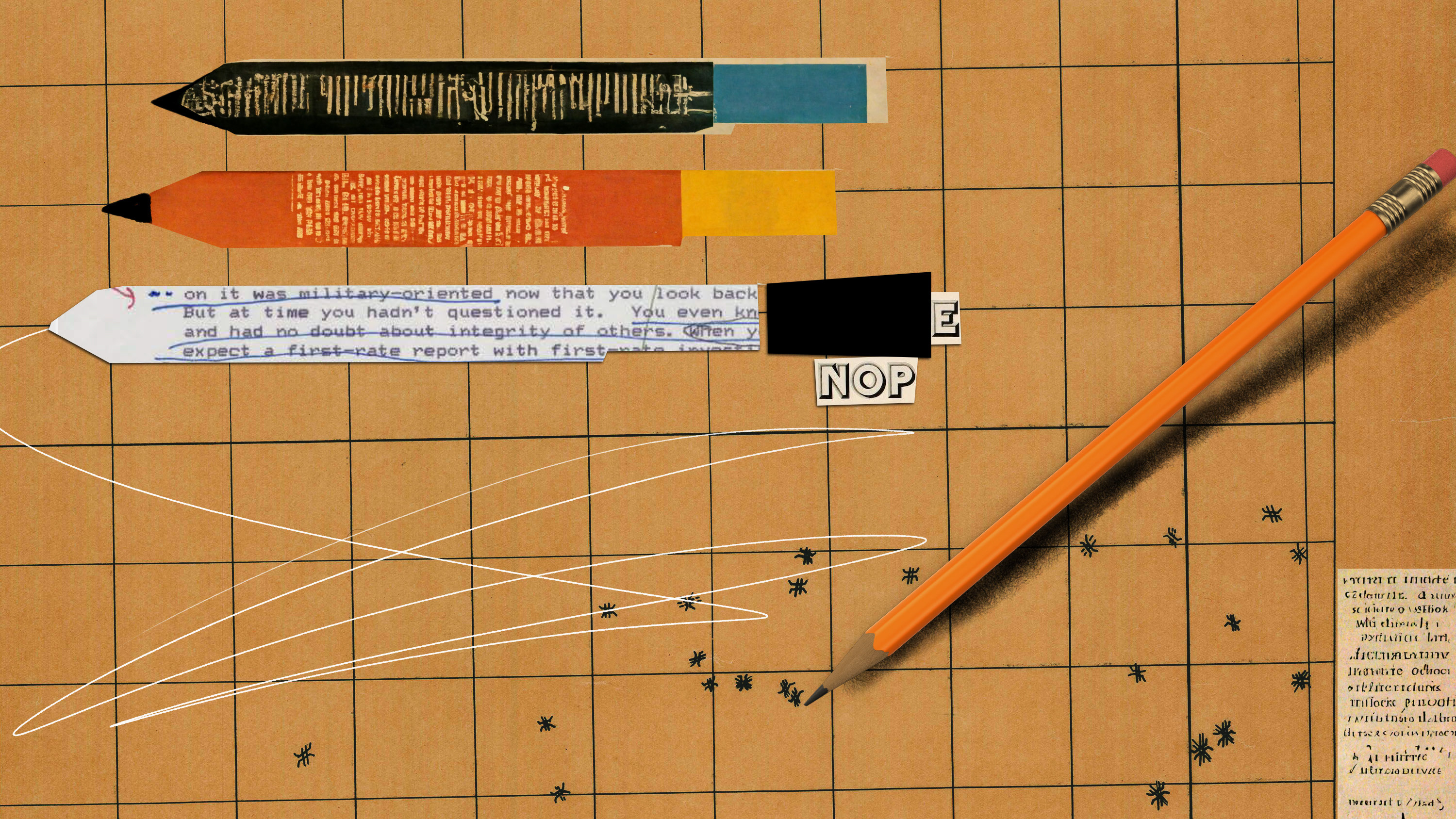
This sentence was written by an AI—or was it? OpenAI’s new chatbot, ChatGPT, presents us with a problem: How will we know whether what we read online is written by a human or a machine?
Since it was released in late November, ChatGPT has been used by over a million people. It has the AI community enthralled, and it is clear the internet is increasingly being flooded with AI-generated text. People are using it to come up with jokes, write children’s stories, and craft better emails.
ChatGPT is OpenAI’s spin-off of its large language model GPT-3 , which generates remarkably human-sounding answers to questions that it’s asked. The magic—and danger—of these large language models lies in the illusion of correctness. The sentences they produce look right—they use the right kinds of words in the correct order. But the AI doesn’t know what any of it means. These models work by predicting the most likely next word in a sentence. They haven’t a clue whether something is correct or false, and they confidently present information as true even when it is not.
In an already polarized, politically fraught online world, these AI tools could further distort the information we consume. If they are rolled out into the real world in real products, the consequences could be devastating.
We’re in desperate need of ways to differentiate between human- and AI-written text in order to counter potential misuses of the technology, says Irene Solaiman, policy director at AI startup Hugging Face, who used to be an AI researcher at OpenAI and studied AI output detection for the release of GPT-3’s predecessor GPT-2.
New tools will also be crucial to enforcing bans on AI-generated text and code, like the one recently announced by Stack Overflow, a website where coders can ask for help. ChatGPT can confidently regurgitate answers to software problems, but it’s not foolproof. Getting code wrong can lead to buggy and broken software, which is expensive and potentially chaotic to fix.
A spokesperson for Stack Overflow says that the company’s moderators are “examining thousands of submitted community member reports via a number of tools including heuristics and detection models” but would not go into more detail.
In reality, it is incredibly difficult, and the ban is likely almost impossible to enforce.
Today’s detection tool kit
There are various ways researchers have tried to detect AI-generated text. One common method is to use software to analyze different features of the text—for example, how fluently it reads, how frequently certain words appear, or whether there are patterns in punctuation or sentence length.
“If you have enough text, a really easy cue is the word ‘the’ occurs too many times,” says Daphne Ippolito, a senior research scientist at Google Brain, the company’s research unit for deep learning.
Because large language models work by predicting the next word in a sentence, they are more likely to use common words like “the,” “it,” or “is” instead of wonky, rare words. This is exactly the kind of text that automated detector systems are good at picking up, Ippolito and a team of researchers at Google found in research they published in 2019.
But Ippolito’s study also showed something interesting: the human participants tended to think this kind of “clean” text looked better and contained fewer mistakes, and thus that it must have been written by a person.
In reality, human-written text is riddled with typos and is incredibly variable, incorporating different styles and slang, while “language models very, very rarely make typos. They’re much better at generating perfect texts,” Ippolito says.
“A typo in the text is actually a really good indicator that it was human written,” she adds.
Large language models themselves can also be used to detect AI-generated text. One of the most successful ways to do this is to retrain the model on some texts written by humans, and others created by machines, so it learns to differentiate between the two, says Muhammad Abdul-Mageed, who is the Canada research chair in natural-language processing and machine learning at the University of British Columbia and has studied detection .
Scott Aaronson, a computer scientist at the University of Texas on secondment as a researcher at OpenAI for a year, meanwhile, has been developing watermarks for longer pieces of text generated by models such as GPT-3—“an otherwise unnoticeable secret signal in its choices of words, which you can use to prove later that, yes, this came from GPT,” he writes in his blog.
A spokesperson for OpenAI confirmed that the company is working on watermarks, and said its policies state that users should clearly indicate text generated by AI “in a way no one could reasonably miss or misunderstand.”
But these technical fixes come with big caveats. Most of them don’t stand a chance against the latest generation of AI language models, as they are built on GPT-2 or other earlier models. Many of these detection tools work best when there is a lot of text available; they will be less efficient in some concrete use cases, like chatbots or email assistants, which rely on shorter conversations and provide less data to analyze. And using large language models for detection also requires powerful computers, and access to the AI model itself, which tech companies don’t allow, Abdul-Mageed says.
The bigger and more powerful the model, the harder it is to build AI models to detect what text is written by a human and what isn’t, says Solaiman.
“What’s so concerning now is that [ChatGPT has] really impressive outputs. Detection models just can’t keep up. You’re playing catch-up this whole time,” she says.
Training the human eye
There is no silver bullet for detecting AI-written text, says Solaiman. “A detection model is not going to be your answer for detecting synthetic text in the same way that a safety filter is not going to be your answer for mitigating biases,” she says.
To have a chance of solving the problem, we’ll need improved technical fixes and more transparency around when humans are interacting with an AI, and people will need to learn to spot the signs of AI-written sentences.
“What would be really nice to have is a plug-in to Chrome or to whatever web browser you’re using that will let you know if any text on your web page is machine generated,” Ippolito says.
Some help is already out there. Researchers at Harvard and IBM developed a tool called Giant Language Model Test Room (GLTR), which supports humans by highlighting passages that might have been generated by a computer program.
But AI is already fooling us. Researchers at Cornell University found that people found fake news articles generated by GPT-2 credible about 66% of the time.
Another study found that untrained humans were able to correctly spot text generated by GPT-3 only at a level consistent with random chance.
The good news is that people can be trained to be better at spotting AI-generated text, Ippolito says. She built a game to test how many sentences a computer can generate before a player catches on that it’s not human, and found that people got gradually better over time.
“If you look at lots of generative texts and you try to figure out what doesn’t make sense about it, you can get better at this task,” she says. One way is to pick up on implausible statements, like the AI saying it takes 60 minutes to make a cup of coffee.
Artificial intelligence
What i learned from the un’s “ai for good” summit.
OpenAI’s CEO Sam Altman was the star speaker of the summit.
An AI startup made a hyperrealistic deepfake of me that’s so good it’s scary
Synthesia's new technology is impressive but raises big questions about a world where we increasingly can’t tell what’s real.
This AI-powered “black box” could make surgery safer
A new smart monitoring system could help doctors avoid mistakes—but it’s also alarming some surgeons and leading to sabotage.
- Simar Bajaj archive page
Is robotics about to have its own ChatGPT moment?
Researchers are using generative AI and other techniques to teach robots new skills—including tasks they could perform in homes.
Stay connected
Get the latest updates from mit technology review.
Discover special offers, top stories, upcoming events, and more.
Thank you for submitting your email!
It looks like something went wrong.
We’re having trouble saving your preferences. Try refreshing this page and updating them one more time. If you continue to get this message, reach out to us at [email protected] with a list of newsletters you’d like to receive.
AI Detector
Paste your content below, and we’ll tell you if any of it has been AI-generated within seconds with exceptional accuracy.
Certain platforms, like Grammarly, use ChatGPT and other genAI models for key functionalities and can be flagged as potential AI content. Learn more

An award-winning enterprise AI detector that has you fully covered.
With over 99% accuracy, model coverage that includes ChatGPT, Gemini, and Claude, and detection in 30 languages, you’re fully covered with the market’s most comprehensive AI detector and checker.
Combined with the award-winning Plagiarism Detector , Codeleaks Source Code Detector , and the all-new Writing Assistant , it’s the only full-spectrum suite dedicated to creating truly original, error-free content.
AI Detection Nearly A Decade In the Making
Since 2015, the Copyleaks AI engine has been learning how humans write by collecting and analyzing trillions of pages from user submitted inputs and more.
We Are Looking For Human Content, Not AI
Our AI engine has been trained to learn the patterns of human writing. Therefore, when the known patterns of human writing are disrupted, our AI flags it as potential AI content.
No one wants to fear false positives that can lead to false accusations. We tested over 20k human-written papers, and the rate of false positives was 0.2%, the lowest false positive rate of any ai detector available.
In addition, we are continually testing our AI Model and retraining it with new data and feedback, helping to improve accuracy.
Get Started Today With the AI Detector
Key features, complete ai model coverage .
AI detection across all AI models, including ChatGPT, Gemini, and Claude. Plus, once newer models are released, we can automatically detect it.
Unprecedented Speed and Accuracy
The AI Detector has over 99% overall accuracy and a 0.2% false positive rate, the lowest of any platform.
Plagiarism and Paraphrased AI Detection
The AI Detector is the only platform with a high confidence rate in detecting AI-generated text that has been potentially plagiarized and/or paraphrased.
AI-generated Source Code Detection
Ensure full transparency with the only AI detector tool that detects AI-generated source code, provides code licensing alerts, and more.
Detect Interspersed AI Content
Have full transparency around the presence of AI-generated content even if the text has been interspersed with human-written content.
Military-Grade Security
All Copyleaks products boast military-grade security along with GDPR compliance and both SOC 2 and SOC 3 certification . For full security details, click here .
AI Detection Across Multiple Languages
- Chinese (Simplified)
- Chinese (Traditional)
- Vietnamese
For a full list of supported languages & accuracy, click here .
AI Detector Use Cases
Ai model training.
Safeguard your AI by ensuring your models are trained exclusively on human-written content, not AI-generated.
Academic Integrity
Verify originality and ensure authenticity within all your academic content, from long-form essays to source code and everything in between.
Mitigate risks, protect your copyright and IP, and establish guardrails for responsible GenAI adoption across your organization.
Publishing & Copywriting
Ensure that what you’re publishing is original and authentic content, avoiding potential search engine penalties and other risks.
Oakland University Case Study
Learn how Oakland University adopted Copyleaks and changed the conversation around AI and plagiarism among their faculty and staff.
Campaign KPIs
Ease of use & Integration, Cost-effectiveness, Customer Support, Security

Lowell Christensen, CEO, SafeSearchKids
AI Detector is even better when paired.
Each of our dynamic product offerings is strong on its own. However, they are truly powerful when you use them together.
Get award-winning plagiarism detection in over 100 languages, identify multiple forms of paraphrasing, and much more.
Proactively mitigate risk and have complete transparency with the only solution that detects AI-generated code and more.
Enforce enterprise-wide policies, ensure responsible generative AI adoption, and proactively mitigate all potential risks.
A revolutionary solution for efficiently and accurately grading tens of thousands of standardized tests at the state, national, and university-wide levels.
Frequently Asked Questions
When a Language Model writes a sentence, it probes all of its pre-training data to output a statistically generated sentence, which is simply not how a human writes. It becomes apparent when analyzed against a vast corpus of human writing.
We can recognize AI text patterns utilizing multiple techniques.
Since 2015, we’ve collected, ingested, and analyzed trillions of crawled and user-sourced content pages from thousands of universities and enterprises worldwide to train our models to understand how humans write as opposed to AI.
Also, utilizing AI technology, our AI detector can accurately recognize the presence of other AI-generated text and the signals it leaves behind, adding an additional layer of accuracy.
There are several significant differences between other AI detector tools and ours.
For example:
• Credible data at scale, coupled with machine learning and widespread adoption, allows us to continually refine and improve our ability to understand complex text patterns, resulting in over 99% accuracy—higher than any other AI detector—and improving daily.
•As an enterprise-based platform, we’re the only solution with seamless API and LMS integrations, allowing you to bring the power of AI Detector directly to your native platform and at scale.
• The AI Detector is the only platform to read source code, including AI-generated. Furthermore, it can detect source code at the function level, helping identify when code has been plagiarized or modified, even if certain variables have been altered or entire portions have been changed
• Our AI Detector does not flag Grammarly’s non-AI features, which include spell check and grammar, as AI. Another AI Detector, in their own analysis, flagged 20% of Grammarly’s non-AI features as AI content, an astounding 20% false positive rate. Read the full analysis .
• Our AI Detector, along with all of Copyleaks’ products, are fully GDPR-compliant and SOC 2 and SOC 3-certified, a global standard audited by KPMG, the leading auditing organization for certification, ensuring the privacy and protection of personal data.
The chance for content written by a human to be falsely labeled as AI-generated content is 0.2%, the lowest of any AI detector available. Nevertheless, we strive to inspire authenticity and digital trust by creating secure environments to share ideas and learn confidently, and that comes with the responsibility to ensure complete accuracy, particularly around false accusations. To address this, we have taken several precautions, including:
- Our detection and the algorithms that power it are designed for detecting human-generated text versus AI-generated text. Detecting AI text tends to give a lower accuracy and increases the likelihood of false positives.
- To help accelerate our learning and refine the models used, we implemented a feedback loop where users can rate the accuracy of the results, which allows us to continually use examples of false positives, rare as they may be, to improve.
- We only introduce new model detection after thorough testing. Once our internal testing reaches a high confidence threshold, we leverage beta testers, giving an additional layer of assurance.
Yes. In July 2023, four researchers from across the globe published a study on the Cornell Tech-owned arXiv, declaring Copyleaks AI Detector the most accurate for checking and detecting Large Language Models (LLM) generated text. Since then, additional independent third-party studies have been released, each one highlighting the accuracy and efficiency of the AI Detector.
Read more about these third-party studies .
Only certain features of writing assistants can cause your content to be flagged by the AI Detector as AI-generated.
For example, Grammarly has a genAI-driven feature that rewrites your content to help improve it, shorten it, etc. As a result, this reworked content could get flagged as AI since it was rewritten by genAI.
However, the Copyleaks Writing Assistant does not get flagged as AI or any content that Grammarly changed to fix grammatical errors, mechanical issues, etc., because it does not use or uses minimal genAI to power these features or functionalities.
Read our analysis about writing assistant tools getting flagged as AI .
At Copyleaks, our products are routinely undergoing independent verification of privacy, security, and compliance control to achieve certifications against global standards to earn and retain the trust of the millions of Copyleaks users worldwide. Our current Copyleaks certifications and compliance standards include SOC2 & SOC3, GDPR, PCI Payment Card Industry Data Security Standard, and NIST Risk Management Framework (RMF). Please visit our Compliance and Certifications and Security Practices pages to learn more.
Yes. Our detection report highlights the specific elements of the text written by a human and those written by AI, even if the text has been interspersed.
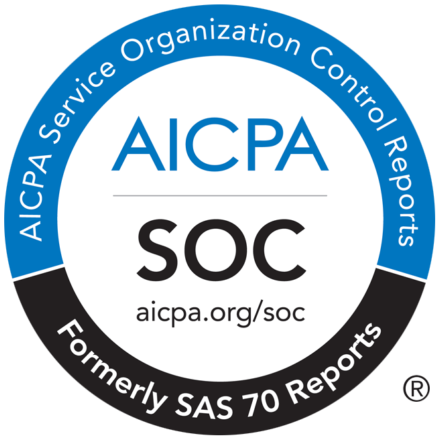
Plagiarism Detector
Writing Assistant
Gen AI Governance
LMS Integration
AI Detector API
AI Detector Extension
Plagiarism Detector API
Writing Assistant API
News & Media
Affiliates
Biden Executive Order on AI
Plagiarism Checker
Help Center
Success Stories
Plagiarism Resources
Accessibility
Security Practices
Terms of Use
Privacy Policy
System Status
All rights reserved. Use of this website signifies your agreement to the Terms of Use .
Detect AI-Generated Text in Seconds for Free!
Have doubts if your content is 100% human-written? Enter your text and find out whether it was developed by real people or created by AI.
Instant Results
No registration is required. Upload the text and get results in seconds.
Detailed Report
Get a report indicating AI-written text along with comprehensive statistics.
100% Data Protection
We do not store your uploads nor do we share any of your information.
What Is AI Detector?
ChatGPT and similar tools are becoming increasingly popular. While they can be handy for specific purposes, it's still vital to understand that AI-created text may result in various penalties.
We have created our ChatGPT finder based on the same language patterns that ChatGPT and other similar AI-writers use, and we have trained our tool to distinguish between patterns of human-written and AI-generated text. You will receive a real-time report on how much of the content is fake.
Using AI-detector.net, you can be sure your texts are completely authentic and contain zero AI-written text.
Best Free AI Text Checker
AI-detector.net will provide you with detailed results within only a few seconds.
No need to pay or register—just paste the text, and you’ll get the result.
We use the same technology as ChatGPT to provide the most precise results.
Our ChatGPT detector can be used for various content types: essays, articles, and more.
Descriptive
You will get a detailed report with highlighted content that was likely written by AI.
Confidentiality
We care about your privacy and do not store any of your texts or personal information.
Who Is AI Detector for?
It is vital to know what content has been written by AI or humans, whether you’re looking at a blog post, browsing the Internet, or reading a college essay. Our free ChatGPT detector can help you to check any type of text.
Marketing and SEO-content
The vast majority of search engines penalize content if they recognize it as AI-generated. Use our AI text checker to verify that you’re posting only human-written content and to detect if your writers used any AI tools in the process.
Academic writing
Find out if your essays or theses include any signs of AI content tools usage. Copy and paste any assignment into the box above and find out within a few seconds whether it is AI-generated or written by a real human.
Business writing
Avoid misleading or inaccurate information in your emails, reports, or other texts, which may occur due to the use of ChatGPT or similar tools. Our AI detector will help you to protect your brand reputation and deliver clear messages to your customers.
How AI Content Checker Works?
Our free AI content detector allows you to assess any text within a few clicks and get the results in seconds.
What Technologies Can AI Checker Detect?
With the rise in popularity of various AI text generation platforms, it is vital to know whether content was written by humans or created by an AI platform. We have incorporated as many technologies as possible into our tool to detect potential issues in any given piece of content.
ChatGPT AI Detector
The first AI chatbot, launched in November 2022, quickly gained users’ attention for its detailed responses. However, it often provides inaccurate facts and false answers.
Our ChatGPT essay checker can easily detect the use of this technology so that you can be sure what was artificially created with the help of this algorithm.
GPT-3 and GPT-4 Detector
Our free service is capable of detecting GPT-4, as well as the earlier version of ChatGPT responses. We have implemented a state-of-art algorithm, which incorporates keyword extraction and sentiment analysis. This helps us to determine texts made with pre-trained language models.
The AI-Detector.net model uses contextual and structural clues to recognize machine-generated texts.
Other AI-Writing Tools
There are many online writing tools that use GPT-3 or similar natural language processing models. We have created our AI Detector with the capability to recognize topic modeling and find flag words and language patterns that are typical for artificial intelligence and uncommon for humans. That’s why it can easily verify whether something was written by AI or real people and show it to you in a detailed report.
Check Our Other Tools for Your Writing!
Make your text unique with our free rephrasing tool.
Main Idea Finder
Summarize a lengthy text into a shorter piece a flash with the help of our free online tool.
Random Topic Generator
Grab the list of ideas and research questions for your writing.
Reword generator
Use our AI-powered online paraphraser to rephrase any text in no time.
Essay Conclusion Generator
Stuck with conclusion? No worries! Make a brief summary for your paper within a click.
Thesis Statement Generator
Create a perfect thesis statement for your paper with our free thesis statement generator.
Text Summarizer
Condense any text into a brief summary within a few clicks.
Sentence Rewriter
Paraphrase any sentence or paragraph within a few seconds with our free sentence rewriter.
Thesis Checker
Make a perfect thesis that fits your paper with only a couple of clicks.
Essay Topic Generator
Grab a bunch of unique essay topic ideas in a flash using our handy online tool.
Thesis Maker
Craft a perfect thesis statement for any paper in three simple steps.
Research Title Generator
Can’t pick up a catchy title for your research paper? Use our title generator to get the list of ideas.
Research Question Generator
Get a list of research questions for your next project in no time with this online tool.
Rewrite My Essay
Rewrite any paper in a few clicks with this free online paraphrasing tool.
Summary Writer
Extract key ideas from any paper or article in seconds with the help of our free tool.
Thesis Statement Finder
Make a strong thesis statement for any paper using our free online thesis generator.
Ready to Check Your Content?
Try our AI detection tool out for free!
Have questions about our AI detector or found an error on our website? Use this form to reach us!
Get in Touch
Student Creates App to Detect Essays Written by AI
In response to the text-generating bot ChatGPT, the new tool measures sentence complexity and variation to predict whether an author was human
/https://tf-cmsv2-smithsonianmag-media.s3.amazonaws.com/accounts/headshot/MargaretOsborne.png)
Margaret Osborne
Daily Correspondent
:focal(1061x707:1062x708)/https://tf-cmsv2-smithsonianmag-media.s3.amazonaws.com/filer_public/47/1e/471e0924-d9c0-40b0-a8b0-61369a6df36f/gettyimages-1346781823.jpg)
In November, artificial intelligence company OpenAI released a powerful new bot called ChatGPT, a free tool that can generate text about a variety of topics based on a user’s prompts. The AI quickly captivated users across the internet, who asked it to write anything from song lyrics in the style of a particular artist to programming code.
But the technology has also sparked concerns of AI plagiarism among teachers, who have seen students use the app to write their assignments and claim the work as their own. Some professors have shifted their curricula because of ChatGPT, replacing take-home essays with in-class assignments, handwritten papers or oral exams, reports Kalley Huang for the New York Times .
“[ChatGPT] is very much coming up with original content,” Kendall Hartley , a professor of educational training at the University of Nevada, Las Vegas, tells Scripps News . “So, when I run it through the services that I use for plagiarism detection, it shows up as a zero.”
Now, a student at Princeton University has created a new tool to combat this form of plagiarism: an app that aims to determine whether text was written by a human or AI. Twenty-two-year-old Edward Tian developed the app, called GPTZero , while on winter break and unveiled it on January 2. Within the first week of its launch, more than 30,000 people used the tool, per NPR ’s Emma Bowman. On Twitter, it has garnered more than 7 million views.
GPTZero uses two variables to determine whether the author of a particular text is human: perplexity, or how complex the writing is, and burstiness, or how variable it is. Text that’s more complex with varied sentence length tends to be human-written, while prose that is more uniform and familiar to GPTZero tends to be written by AI.
But the app, while almost always accurate, isn’t foolproof. Tian tested it out using BBC articles and text generated by AI when prompted with the same headline. He tells BBC News ’ Nadine Yousif that the app determined the difference with a less than 2 percent false positive rate.
“This is at the same time a very useful tool for professors, and on the other hand a very dangerous tool—trusting it too much would lead to exacerbation of the false flags,” writes one GPTZero user, per the Guardian ’s Caitlin Cassidy.
Tian is now working on improving the tool’s accuracy, per NPR. And he’s not alone in his quest to detect plagiarism. OpenAI is also working on ways that ChatGPT’s text can easily be identified.
“We don’t want ChatGPT to be used for misleading purposes in schools or anywhere else,” a spokesperson for the company tells the Washington Post ’s Susan Svrluga in an email, “We’re already developing mitigations to help anyone identify text generated by that system.” One such idea is a watermark , or an unnoticeable signal that accompanies text written by a bot.
Tian says he’s not against artificial intelligence, and he’s even excited about its capabilities, per BBC News. But he wants more transparency surrounding when the technology is used.
“A lot of people are like … ‘You’re trying to shut down a good thing we’ve got going here!’” he tells the Post . “That’s not the case. I am not opposed to students using AI where it makes sense. … It’s just we have to adopt this technology responsibly.”
Get the latest stories in your inbox every weekday.
/https://tf-cmsv2-smithsonianmag-media.s3.amazonaws.com/accounts/headshot/MargaretOsborne.png)
Margaret Osborne | | READ MORE
Margaret Osborne is a freelance journalist based in the southwestern U.S. Her work has appeared in the Sag Harbor Express and has aired on WSHU Public Radio.
Have a language expert improve your writing
Check your paper for plagiarism in 10 minutes, generate your apa citations for free.
- Knowledge Base
Using AI tools
- How Do AI Detectors Work? | Methods & Reliability
How Do AI Detectors Work? | Methods & Reliability
Published on May 1, 2023 by Jack Caulfield . Revised on September 6, 2023.
AI detectors (also called AI writing detectors or AI content detectors ) are tools designed to detect when a text was partially or entirely generated by artificial intelligence (AI) tools such as ChatGPT .
AI detectors may be used to detect when a piece of writing is likely to have been generated by AI. This is useful, for example, to educators who want to check that their students are doing their own writing or moderators trying to remove fake product reviews and other spam content.
However, these tools are quite new and experimental, and they’re generally considered somewhat unreliable for now. Below, we explain how they work, how reliable they really are, and how they’re being used.
Instantly correct all language mistakes in your text
Upload your document to correct all your mistakes in minutes

Table of contents
How do ai detectors work, how reliable are ai detectors, ai detectors vs. plagiarism checkers, what are ai detectors used for, detecting ai writing manually, ai image and video detectors, other interesting articles, frequently asked questions.
AI detectors are usually based on language models similar to those used in the AI writing tools they’re trying to detect. The language model essentially looks at the input and asks “Is this the sort of thing that I would have written?” If the answer is “yes,” it concludes that the text is probably AI-generated.
Specifically, the models look for two things in a text: perplexity and burstiness . The lower these two variables are, the more likely the text is to be AI-generated. But what do these unusual terms mean?
Perplexity is a measure of how unpredictable a text is: how likely it is to perplex (confuse) the average reader (i.e., make no sense or read unnaturally).
- AI language models aim to produce texts with low perplexity , which are more likely to make sense and read smoothly but are also more predictable.
- Human writing tends to have higher perplexity : more creative language choices, but also more typos.
Language models work by predicting what word would naturally come next in a sentence and inserting it. For example, in the sentence “I couldn’t get to sleep last …” there are more and less plausible continuations, as shown in the table below.
| Example continuation | Perplexity |
|---|---|
| I couldn’t get to sleep last | Probably the most likely continuation |
| I couldn’t get to sleep last | Less likely, but it makes grammatical and logical sense |
| I couldn’t get to sleep last | The sentence is coherent but quite unusually structured and long-winded |
| I couldn’t get to sleep last | Grammatically incorrect and illogical |
L ow perplexity is taken as evidence that a text is AI-generated.
Burstiness is a measure of variation in sentence structure and length—something like perplexity, but on the level of sentences rather than words:
- A text with little variation in sentence structure and sentence length has low burstiness .
- A text with greater variation has high burstiness .
AI text tends to be less “bursty” than human text. Because language models predict the most likely word to come next, they tend to produce sentences of average length (say, 10–20 words) and with conventional structures. This is why AI writing can sometimes seem monotonous.
Low burstiness indicates that a text is likely to be AI-generated.
A potential alternative: Watermarks
OpenAI, the company behind ChatGPT, claims to be working on a “watermarking” system where text generated by the tool could be given an invisible watermark that can then be detected by another system to know for sure that a text was AI-generated.
However, this system has not been developed yet, and the details of how it might work are unknown. It’s also not clear whether the proposed watermarks will remain when the generated text is edited. So while this may be a promising method of AI detection in the future, we just don’t know yet.
Check for common mistakes
Use the best grammar checker available to check for common mistakes in your text.
Fix mistakes for free
In our experience, AI detectors normally work well, especially with longer texts, but can easily fail if the AI output was prompted to be less predictable or was edited or paraphrased after being generated. And detectors can easily misidentify human-written text as AI-generated if it happens to match the criteria (low perplexity and burstiness).
Our research into the best AI detectors indicates that no tool can provide complete accuracy; the highest accuracy we found was 84% in a premium tool or 68% in the best free tool.
These tools give a useful indication of how likely it is that a text was AI-generated, but we advise against treating them as evidence on their own. As language models continue to develop, it’s likely that detection tools will always have to race to keep up with them.
Even the more confident providers usually admit that their tools can’t be used as definitive evidence that a text is AI-generated, and universities so far don’t put much faith in them.
AI detectors and plagiarism checkers may both be used by universities to discourage academic dishonesty , but they differ in terms of how they work and what they’re looking for:
- AI detectors try to find text that looks like it was generated by an AI writing tool. They do this by measuring specific characteristics of the text (perplexity and burstiness)—not by comparing it to a database.
- Plagiarism checkers try to find text that is copied from a different source. They do this by comparing the text to a large database of previously published sources, student theses, and so on, and detecting similarities —not by measuring specific characteristics of the text.
However, we’ve found that plagiarism checkers do flag parts of AI-generated texts as plagiarism. This is because AI writing draws on sources that it doesn’t cite. While it usually generates original sentences, it may also include sentences directly copied from existing texts, or at least very similar.
This is most likely to happen with popular or general-knowledge topics and less likely with more specialized topics that have been written about less. Moreover, as more AI-generated text appears online, AI writing may become more likely to be flagged as plagiarism—simply because other similarly worded AI-generated texts already exist on the same topic.
So, while plagiarism checkers aren’t designed to double as AI detectors, they may still flag AI writing as partially plagiarized in many cases . But they’re certainly less effective at finding AI writing than an AI detector.
AI detectors are intended for anyone who wants to check whether a piece of text might have been generated by AI. Potential users include:
- Educators (teachers and university instructors) who want to check that their students’ work is original
- Publishers who want to ensure that they only publish human-written content
- Recruiters who want to ensure that candidates’ cover letters are their own writing
- Web content writers who want to publish AI-generated content but are concerned that it may rank lower in search engines if it is identified as AI writing
- Social media moderators, and others fighting automated misinformation, who want to identify AI-generated spam and fake news
Because of concerns about their reliability, most users are reluctant to fully rely on AI detectors for now, but they are already gaining popularity as an indication that a text was AI-generated when the user already had their suspicions.
As well as using AI detectors, you can also learn to spot the identifying features of AI writing yourself. It’s difficult to do so reliably—human writing can sometimes seem robotic, and AI writing tools are more and more convincingly human—but you can develop a good instinct for it.
The specific criteria that AI detectors use—low perplexity and burstiness—are quite technical, but you can try to spot them manually by looking for text:
- That reads monotonously, with little variation in sentence structure or length
- With predictable, generic word choices and few surprises
You can also use approaches that AI detectors don’t, by watching out for:
- Overly polite language: Chatbots like ChatGPT are designed to play the role of a helpful assistant, so their language is very polite and formal by default—not very conversational.
- Hedging language: Look for a lack of bold, original statements and for a tendency to overuse generic hedging phrases: “It’s important to note that …” “ X is widely regarded as …” “ X is considered …” “Some might say that …”
- Inconsistency in voice: If you know the usual writing style and voice of the person whose writing you’re checking (e.g., a student), then you can usually see when they submit something that reads very differently from how they normally write.
- Unsourced or incorrectly cited claims: In the context of academic writing , it’s important to cite your sources . AI writing tools tend not to do this or to do it incorrectly (e.g., citing nonexistent or irrelevant sources).
- Logical errors: AI writing, although it’s increasingly fluent, may not always be coherent in terms of its actual content. Look for points where the text contradicts itself, makes an implausible statement, or presents disjointed arguments.
In general, just trying out some AI writing tools, seeing what kinds of texts they can generate, and getting used to their style of writing are good ways to improve your ability to spot text that may be AI-generated.
AI image and video generators such as DALL-E, Midjourney, and Synthesia are also gaining popularity, and it’s increasingly important to be able to detect AI images and videos (also called “deepfakes”) to prevent them from being used to spread misinformation.
Due to the technology’s current limitations, there are some obvious giveaways in a lot of AI-generated images and videos: anatomical errors like hands with too many fingers; unnatural movements; inclusion of nonsensical text; and unconvincing faces.
But as these AI images and videos become more advanced, they may become harder to detect manually. Some AI image and video detectors are already out there: for example, Deepware, Intel’s FakeCatcher, and Illuminarty. We haven’t tested the reliability of these tools.
If you want more tips on using AI tools , understanding plagiarism , and citing sources , make sure to check out some of our other articles with explanations, examples, and formats.
- Citing ChatGPT
- Best grammar checker
- Best paraphrasing tool
- ChatGPT in your studies
- Deep learning
- Types of plagiarism
- Self-plagiarism
- Avoiding plagiarism
- Academic integrity
- Best plagiarism checker
Citing sources
- Citation styles
- In-text citation
- Citation examples
- Annotated bibliography
AI detectors aim to identify the presence of AI-generated text (e.g., from ChatGPT ) in a piece of writing, but they can’t do so with complete accuracy. In our comparison of the best AI detectors , we found that the 10 tools we tested had an average accuracy of 60%. The best free tool had 68% accuracy, the best premium tool 84%.
Because of how AI detectors work , they can never guarantee 100% accuracy, and there is always at least a small risk of false positives (human text being marked as AI-generated). Therefore, these tools should not be relied upon to provide absolute proof that a text is or isn’t AI-generated. Rather, they can provide a good indication in combination with other evidence.
Tools called AI detectors are designed to label text as AI-generated or human. AI detectors work by looking for specific characteristics in the text, such as a low level of randomness in word choice and sentence length. These characteristics are typical of AI writing, allowing the detector to make a good guess at when text is AI-generated.
But these tools can’t guarantee 100% accuracy. Check out our comparison of the best AI detectors to learn more.
You can also manually watch for clues that a text is AI-generated—for example, a very different style from the writer’s usual voice or a generic, overly polite tone.
Yes, in some contexts it may be appropriate to cite ChatGPT in your work, especially if you use it as a primary source (e.g., you’re studying the abilities of AI language models).
Some universities may also require you to cite or acknowledge it if you used it to help you in the research or writing process (e.g., to help you develop research questions ). Check your institution’s guidelines.
Since ChatGPT isn’t always trustworthy and isn’t a credible source , you should not cite it as a source of factual information.
In APA Style , you can cite a ChatGPT response as a personal communication, since the answers it gave you are not retrievable for other users. Cite it like this in the text: (ChatGPT, personal communication, February 11, 2023).
You can access ChatGPT by signing up for a free account:
- Follow this link to the ChatGPT website.
- Click on “Sign up” and fill in the necessary details (or use your Google account). It’s free to sign up and use the tool.
- Type a prompt into the chat box to get started!
A ChatGPT app is also available for iOS, and an Android app is planned for the future. The app works similarly to the website, and you log in with the same account for both.
It’s not clear whether ChatGPT will stop being available for free in the future—and if so, when. The tool was originally released in November 2022 as a “research preview.” It was released for free so that the model could be tested on a very large user base.
The framing of the tool as a “preview” suggests that it may not be available for free in the long run, but so far, no plans have been announced to end free access to the tool.
A premium version, ChatGPT Plus, is available for $20 a month and provides access to features like GPT-4, a more advanced version of the model. It may be that this is the only way OpenAI (the publisher of ChatGPT) plans to monetize it and that the basic version will remain free. Or it may be that the high costs of running the tool’s servers lead them to end the free version in the future. We don’t know yet.
Cite this Scribbr article
If you want to cite this source, you can copy and paste the citation or click the “Cite this Scribbr article” button to automatically add the citation to our free Citation Generator.
Caulfield, J. (2023, September 06). How Do AI Detectors Work? | Methods & Reliability. Scribbr. Retrieved June 7, 2024, from https://www.scribbr.com/ai-tools/how-do-ai-detectors-work/
Is this article helpful?

Jack Caulfield
Other students also liked, best ai detector | free & premium tools tested, university policies on ai writing tools | overview & list, best plagiarism checkers compared.
Jack Caulfield (Scribbr Team)
Thanks for reading! Hope you found this article helpful. If anything is still unclear, or if you didn’t find what you were looking for here, leave a comment and we’ll see if we can help.
Still have questions?
"i thought ai proofreading was useless but..".
I've been using Scribbr for years now and I know it's a service that won't disappoint. It does a good job spotting mistakes”
- Skip to main content
- Keyboard shortcuts for audio player
A new tool helps teachers detect if AI wrote an assignment

Janet W. Lee
Several big school districts such as New York and Los Angeles have blocked access to a new chatbot that uses artificial intelligence to produce essays. One student has a new tool to help.
Copyright © 2023 NPR. All rights reserved. Visit our website terms of use and permissions pages at www.npr.org for further information.
NPR transcripts are created on a rush deadline by an NPR contractor. This text may not be in its final form and may be updated or revised in the future. Accuracy and availability may vary. The authoritative record of NPR’s programming is the audio record.
AI content detector
Use our free AI detector to check up to 5,000 words, and decide if you want to make adjustments before you publish. Read the disclaimer first.
AI content detection is only available in the Writer app as an API . Find out more in our help center article .
Turnitin's AI writing detection available now
Turnitin’s ai writing detection helps educators, publishers and researchers identify when ai writing tools such as chatgpt may have been used in submitted work..
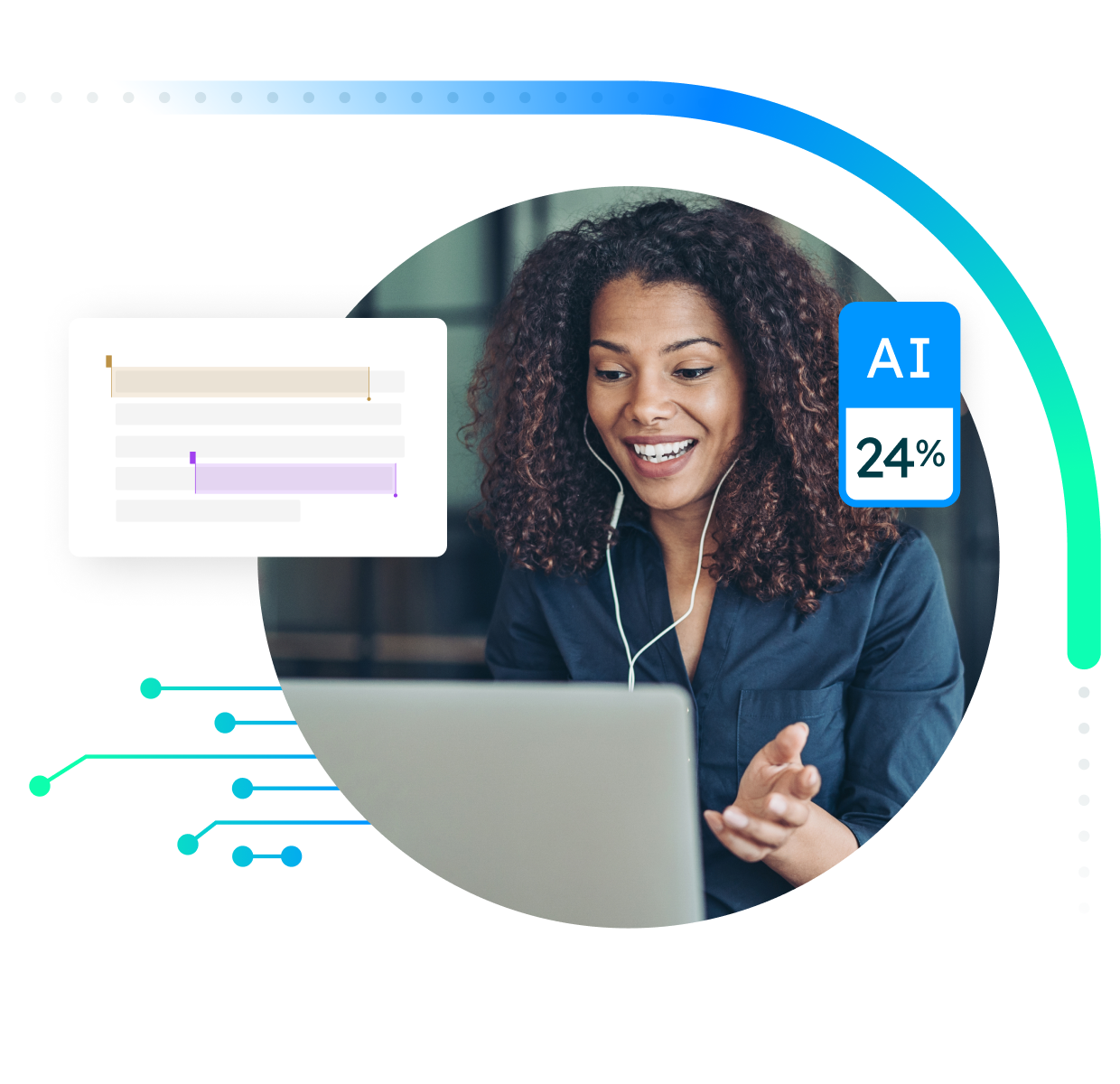
Academic integrity in the age of AI writing
Over the years, academic integrity has been both supported and tested by technology. Today, educators are facing a new frontier with AI writing and ChatGPT.
Here at Turnitin, we believe that AI can be a positive force that, when used responsibly, has the potential to support and enhance the learning process. We also believe that equitable access to AI tools is vital, which is why we’re working with students and educators to develop technology that can support and enhance the learning process. However, it is important to acknowledge new challenges alongside the opportunities.
We recognize that for educators, there is an immediate need to know when and where AI and AI writing tools have been used by students. This is why we are now offering AI detection capabilities for educators in our products.
Gain insights on how much of a student’s submission is authentic, human writing versus AI-generated from ChatGPT or other tools.
Reporting identifies likely AI-written text and provides information educators need to determine their next course of action. We’ve designed our solution with educators, for educators.
AI writing detection complements Turnitin’s similarity checking workflow and is integrated with your LMS, providing a seamless, familiar experience.
Turnitin’s AI writing detection capability available with Originality, helps educators identify AI-generated content in student work while safeguarding the interests of students.
Turnitin ai innovation lab.
Welcome to the Turnitin AI Innovation Lab, a hub for new and upcoming product developments in the area of AI writing. You can follow our progress on detection initiatives for AI writing, ChatGPT, and AI-paraphrasing.

Understanding the false positive rate for sentences of our AI writing detection capability
We’d like to share more insight on our sentence level false positive rate and tips on how to use our AI writing detection metrics.
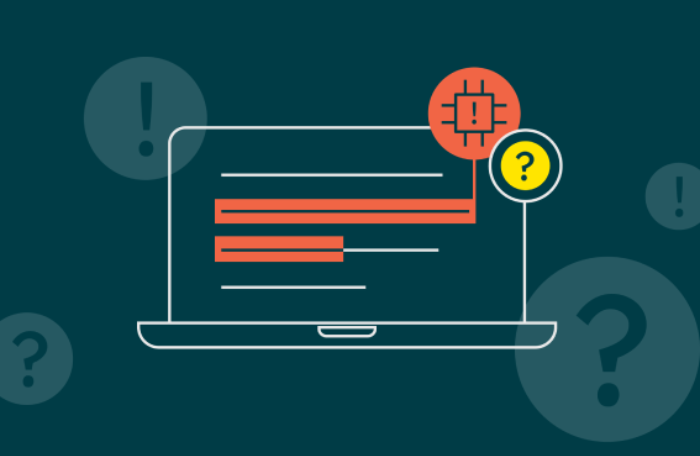
Understanding false positives within our AI writing detection capabilities
We’d like to share some insight on how our AI detection model deals with false positives and what constitutes a false positive.
Have questions? Read these FAQs on Turnitin’s AI writing detection capabilities
Helping solve the ai writing puzzle one piece at a time.
AI-generated writing has transformed every aspect of our lives, including the classroom. However, identifying AI writing in students’ submissions is just one piece in the broader, complex, ever-evolving AI writing puzzle.
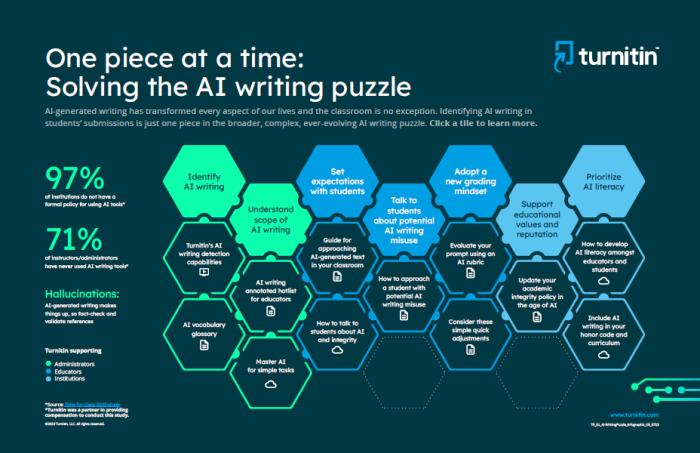
Research corner
We regularly undertake internal research to ensure our AI writing detector stays accurate and up-to-date. If you are interested in what external testing has revealed about Turnitin's AI-writing detection capabilities, check out the links below. Notably, these studies position Turnitin among the foremost solutions in identifying AI-generated content within academia.
Research shows Turnitin's AI detector shows no statistically significant bias against English Language Learners
- In response to feedback from customers and papers claiming that AI writing detection tools are biased against writers whose first language is not English, Turnitin expanded its false positive evaluation to include writing samples of English Language Learners (ELL) and tested another nearly 2,000 writing samples of ELL writers.
- What Turnitin found was that in documents meeting the 300 word count requirement, ELL writers received a 0.014 false positive rate and native English writers received a 0.013.
- This means that there is no statistically significant bias against non-native English speakers.
Turnitin’s AI writing detector identified as the most accurate out of 16 detectors tested
- Two of the 16 detectors, Turnitin and Copyleaks, correctly identified the AI- or human-generated status of all 126 documents, with no incorrect or uncertain responses.
- Three AI text detectors – Turnitin, Originality, and Copyleaks, – have very high accuracy with all three sets of documents examined for this study: GPT-3.5 papers, GPT-4 papers, and human-generated papers.
- Of the top three detectors identified in this investigation, Turnitin achieved very high accuracy in all five previous evaluations. Copyleaks, included in four earlier analyses, performed well in three of them.
Teaching in the age of AI writing
As AI text generators like ChatGPT quickly evolve, our educator resources will, too. Curated and created by our team of veteran educators, our resources help educators meet these new challenges. They are built for professional learning and outline steps educators can take immediately to guide students in maintaining academic integrity when faced with AI writing tools.
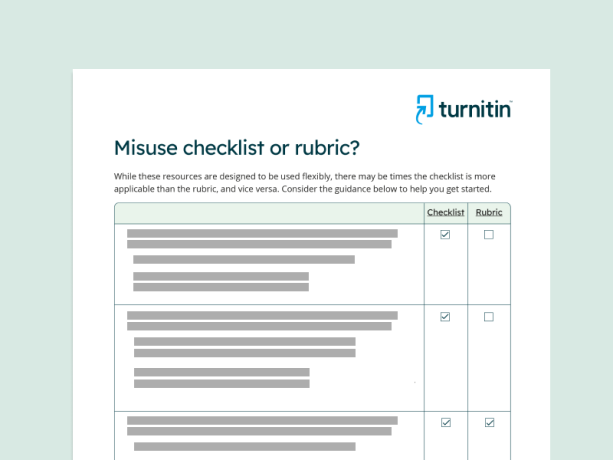
A guide to help educators determine which resource is more applicable to their instructional situation: the AI misuse checklist or the AI misuse rubric.
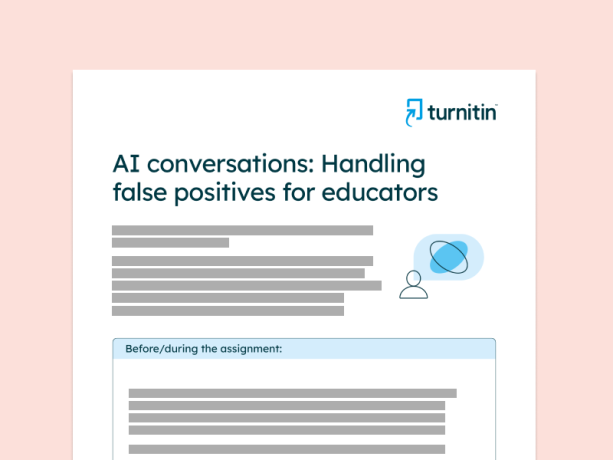
A guide sharing strategies educators can consider to help when confronted with a false positive.
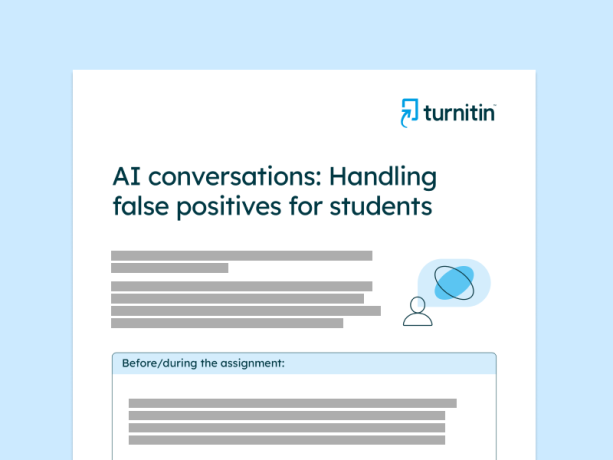
A guide sharing strategies students can consider to help when confronted with a false positive.
The Turnitin Educator Network is a space to meet, discuss and share best practices on academic integrity in the age of AI.
Learn more about ai writing in our blog.
Written by experts in the field, educators, and Turnitin professionals, our blog offers resources and thought leadership in support of students, instructors, and administrators. Dive into articles on a variety of important topics, including academic integrity, assessment, and instruction in a world with artificial intelligence.

In this blog post, we’re going to address frequently asked questions about AI writing tool misuse for students. Specifically, what does AI writing tool misuse look like? How can you self-check to make sure you’re using AI writing tools properly?

Stay up to date with the latest blog posts delivered directly to your inbox.
Turnitin ai tools in the news.
Never miss an update or announcement. Visit our media center for recent news coverage and press releases.
Cheat GPT? Turnitin CEO Chris Caren weighs in on combating A.I. plagiarism | CNBC Squawk Box
Since the inception of AI-generated writing, educators and institutions are learning how to navigate it in the classroom. Turnitin’s CEO Chris Caren joins ‘Squawk Box’ to discuss how it is being used in the classroom and how educators can identify AI writing in student submissions.

Trouble viewing? View the video on YouTube or adjust your cookie preferences .
Some U.S. schools banning AI technology while others embrace it | NBC Nightly News
ChatGPT, an artificial intelligence program, can write college-level essays in seconds. While some school districts are banning it due to cheating concerns, NBC News’ Jacob Ward has details on why some teachers are embracing the technology.

BestColleges
Artificial intelligence, it seems, is taking over the world. At least that's what alarmists would have you believe . The line between fact and fiction continues to blur, and recognizing what is real versus what some bot concocted grows increasingly difficult with each passing week.
ThriveinEDU Podcast
On this episode of the ThriveinEDU podcast, host Rachelle Dené Poth speaks with Turnitin’s Chief Product Officer Annie Chechitelli about her role in the organization, her experience as a parent with school-age children learning to navigate AI writing, and the future of education and original thought.
District Administration
Following the one year anniversary of the public launch of ChatGPT, Chief Product Officer Annie Chechitelli sits down with the publication to discuss Turnitin’s AI writing detection feature and what the educational community has learned.
For press and media inquiries, contact us at [email protected]
Awards & recognition.

Let’s innovate together

Free AI Detector
Detect AI-generated content like ChatGPT3.5, GPT4 and Gemini in seconds
Get AI Detection with a Premium Plagiarism Check
- Checked for AI and plagiarism
- Plagiarism Check in partnership with Turnitin
- Works with English, Spanish, German, and more
Why use Scribbr’s AI Detector
Authority on ai and plagiarism.
Our plagiarism and AI detection tools and helpful content are used by millions of users every month.
Unlimited free AI checks
Perform an unlimited number of AI content checks for free, ensuring all of your work is authentic.
No sign-up required
Start detecting AI-generated content instantly, without having to create an account.
Confidentiality guaranteed
Rest easy knowing your submissions remain private; we do not store or share your data.

AI Detector for ChatGPT, GPT4, Gemini, and more
Scribbr’s AI and ChatGPT Detector confidently detects texts generated by the most popular tools, like ChatGPT, Gemini, and Copilot.
GPT2, GPT3, and GPT3.5 are detected with high accuracy, while the detection of GPT4 is supported on an experimental basis.
Note that no AI Detector can provide complete accuracy ( see our research ). As language models continue to develop, detection tools will always have to race to keep up with them.
The AI Detector is perfect for...

Confidently submit your papers
Scribbr’s AI Detector helps ensure that your essays and papers adhere to your university guidelines.
- Verify the authenticity of your sources ensuring that you only present trustworthy information.
- Identify any AI-generated content, like ChatGPT, that might need proper attribution.

Check the authenticity of your students’ work
More and more students are using AI tools, like ChatGPT in their writing process.
- Analyze the content submitted by your students, ensuring that their work is actually written by them.
- Promote a culture of honesty and originality among your students.

Prevent search algorithm penalties
Ensure that your content is indexed by publishing high-quality and original content.
- Analyze the authenticity of articles written by external contributors or agencies before publishing them.
- Deliver unique content that engages your audience and drives traffic to your website.
AI Detectors vs. Plagiarism Checkers
AI detectors and plagiarism checkers are both used to verify the originality and authenticity of a text, but they differ in terms of how they work and what they’re looking for.
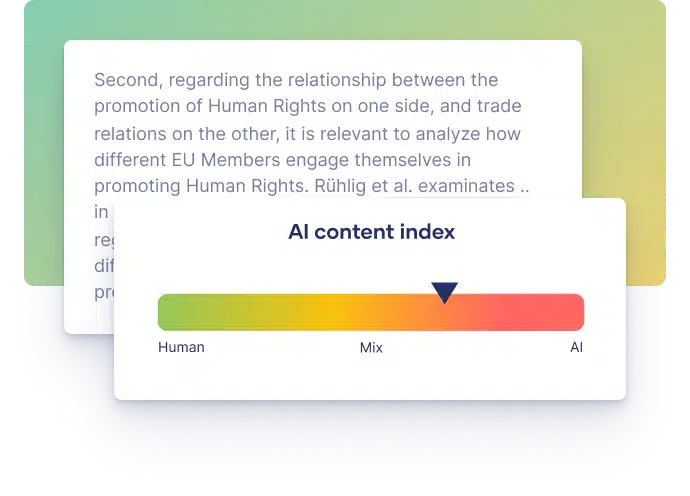

AI Detector or ChatGPT Detector
AI detectors try to find text that looks like it was generated by an AI writing tool, like ChatGPT. They do this by measuring specific characteristics of the text like sentence structure and length, word choice, and predictability — not by comparing it to a database of content.
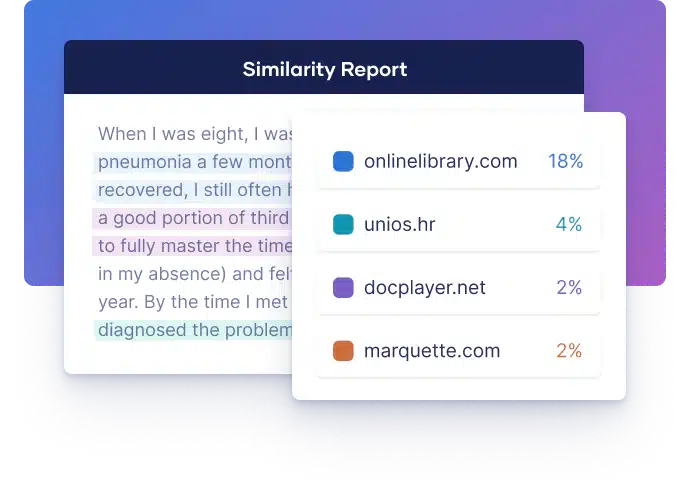
Plagiarism Checker
Plagiarism checkers try to find text that is copied from a different source. They do this by comparing the text to a large database of web pages, news articles, journals, and so on, and detecting similarities — not by measuring specific characteristics of the text.
Scribbr & academic integrity
Scribbr is committed to protecting academic integrity. Our tools, like the AI Detector , Plagiarism Checker , and Citation Generator are designed to help students produce quality academic papers and prevent academic misconduct.
We make every effort to prevent our software from being used for fraudulent or manipulative purposes.
Your questions, answered
Scribbr’s AI Detectors can confidently detect most English texts generated by popular tools like ChatGPT, Gemini, and Copilot.
Our free AI detector can detect GPT2, GPT3, and GPT3.5 with average accuracy, while the Premium AI Detector has high accuracy and the ability to detect GPT4.
Our AI Detector can detect most texts generated by popular tools like ChatGPT and Bard. Unfortunately, we can’t guarantee 100% accuracy. The software works especially well with longer texts but can make mistakes if the AI output was prompted to be less predictable or was edited or paraphrased after being generated.
Our research into the best AI detectors indicates that no tool can provide complete accuracy; the highest accuracy we found was 84% in a premium tool or 68% in the best free tool.
The AI score is a percentage between 0% and 100%, indicating the likelihood that a text has been generated by AI.
Detect ChatGPT3.5, GPT4 and Gemini in seconds
Get in touch with questions.
We answer your questions quickly and personally from 9:00 to 23:00 CET

- Start live chat
- Email [email protected]
- Call +44 (0)20 3917 4242
- WhatsApp +31 20 261 6040
Learn how to use AI tools responsibly
How to cite chatgpt, how to write a paper with chatgpt, how do ai detectors work, university policies on ai writing tools.
A Princeton student built an app which can detect if ChatGPT wrote an essay to combat AI-based plagiarism
- A Princeton student built an app that aims to tell if essays were written by AIs like ChatGPT.
- The app analyzes text to see how randomly it is written, allowing it to detect if it was written by AI.
- The website hosting the app, built by Edward Tian, crashed due to high traffic.

A new app can detect whether your essay was written by ChatGPT, as researchers look to combat AI plagiarism.
Edward Tian, a computer science student at Princeton, said he spent the holiday period building GPTZero.
He shared two videos comparing the app's analysis of a New Yorker article and a letter written by ChatGPT. It correctly identified that they were respectively written by a human and AI.
Related stories
—Edward Tian (@edward_the6) January 3, 2023
GPTZero scores text on its "perplexity and burstiness" – referring to how complicated it is and how randomly it is written.
The app was so popular that it crashed "due to unexpectedly high web traffic," and currently displays a beta-signup page . GPTZero is still available to use on Tian's Streamlit page, after the website hosts stepped in to increase its capacity.
Tian, a former data journalist with the BBC, said that he was motivated to build GPTZero after seeing increased instances of AI plagiarism.
"Are high school teachers going to want students using ChatGPT to write their history essays? Likely not," he tweeted.
The Guardian recently reported that ChatGPT is introducing its own system to combat plagiarism by making it easier to identify, and watermarking the bot's output.
That follows The New York Times' report that Google issued a "code red" alert over the AI's popularity.
Insider's Beatrice Nolan also tested ChatGPT to write cover letters for job applications , with one hiring manager saying she'd have got an interview, though another said the letter lacked personality.
Tian added that he's planning to publish a paper with accuracy stats using student journalism articles as data, alongside Princeton's Natural Language Processing group.
OpenAI and Tian didn't immediately respond to Insider's request for comment, sent outside US working hours.
- Main content
AI Writing Detection
Turnitin's AI writing detection capability is designed to help educators identify text that might be prepared by a generative AI tool. Our AI writing detection model may not always be accurate (it may misidentify both human and AI-generated text) so it should not be used as the sole basis for adverse actions against a student. It takes further scrutiny and human judgment in conjunction with an organization's application of its specific academic policies to determine whether any academic misconduct has occurred.
This feature is only available for certain Turnitin licenses. Contact your account administrator to find out more
The AI writing indicator
When you open a Similarity Report, the AI writing indicator is in the side panel. After a short period of processing, the indicator will display one of three potential states:
| Blue with a percentage between 0 and 100: The submission has processed successfully. The displayed percentage indicates the amount of qualifying text within the submission that Turnitin’s AI writing detection model determines was generated by AI. As noted previously, this percentage is not necessarily the percentage of the entire submission. If text within the submission was not considered long-form prose text, it will not be included. Our testing has found that there is a higher incidence of false positives when the percentage is between 1 and 20. In order to reduce the likelihood of misinterpretation, the AI indicator will display an asterisk (*) for percentages between 1 and 20 to call attention to the fact that the score is less reliable. To explore the results of the AI writing detection capabilities, select the indicator to open the AI writing report. The AI writing report opens in a new tab of the window used to launch the Similarity Report. If you have a pop-up blocker installed, ensure it allows Turnitin pop-ups.
| |
| Gray with no percentage displayed (- -): The AI writing detection indicator is unable to process this submission. This state means that the AI writing report cannot be opened. This can be due to one, or several, of the following reasons: | |
|
Error ( ): This error means that Turnitin has failed to process the submission. This state means that the AI writing report cannot be opened. Turnitin is constantly working to improve its service, but unfortunately, events like this can occur. Please try again later. If the file meets all the file requirements stated above, and this error state still shows, so we can investigate for you. |
The AI writing report
The AI writing report contains the overall percentage of prose sentences contained in a long-form writing format within the submitted document that Turnitin’s AI writing detection model determines was generated by AI. These sentences are highlighted in blue on the submission text in the AI writing report.
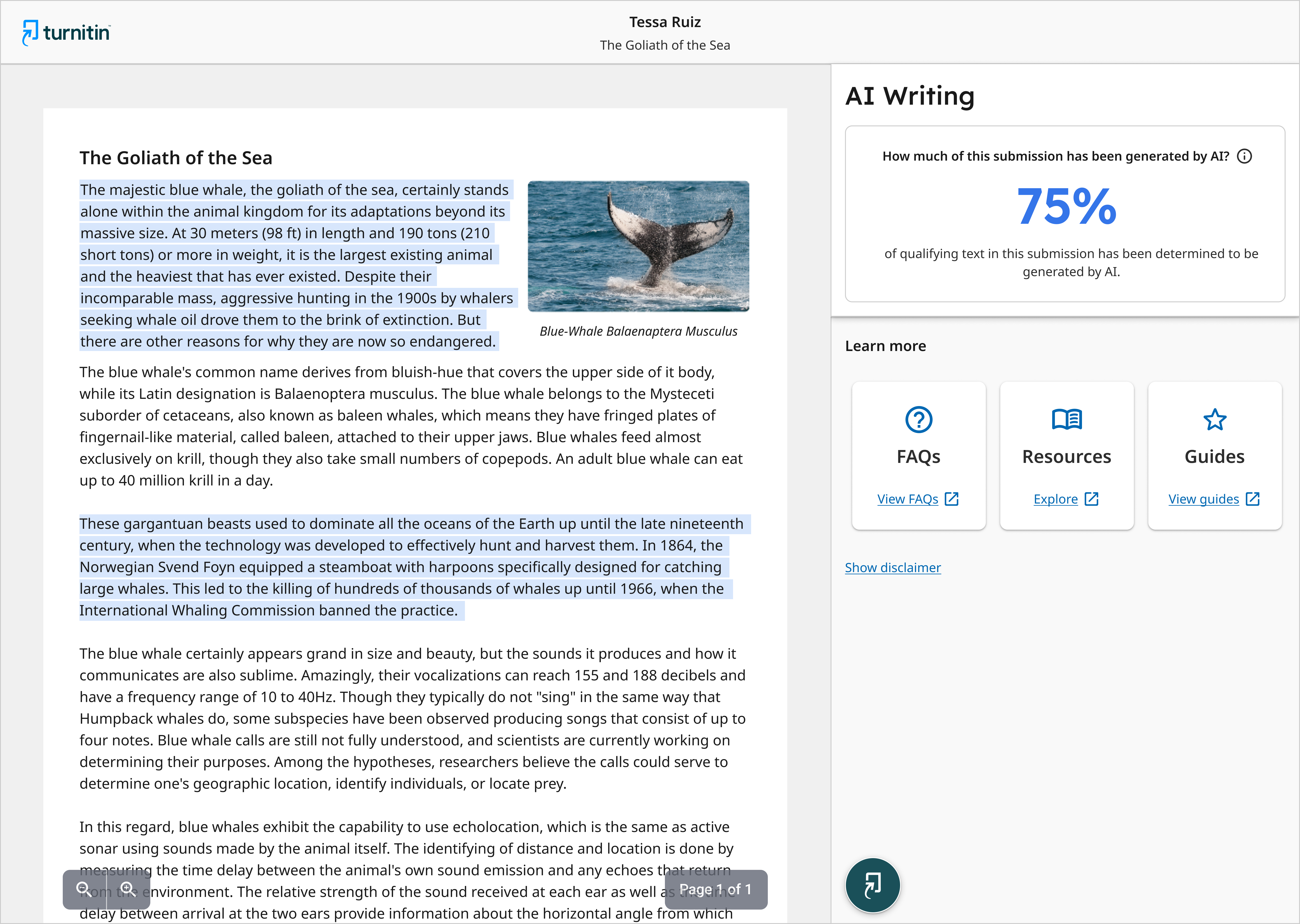
Prose text contained in long-form writing means individual sentences contained in paragraphs that make up a longer piece of written work, such as an essay, a dissertation, or an article, etc. The model does not reliably detect AI-generated text in the form of non-prose, such as poetry, scripts, or code, nor does it detect short-form/unconventional writing such as bullet points, tables, or annotated bibliographies.
This means that a document containing several different writing types would result in a disparity between the percentage and the highlights.
The percentage, generated by Turnitin’s AI writing detection model, is different and independent from the similarity score, and the AI writing highlights are not visible in the Similarity Report.
How do we detect AI-generated writing?
How Turnitin has made this determination is complex. To help our users understand Turnitin’s method of detecting AI writing text, we have created an extensive FAQ. Learn more about Turnitin’s AI writing detection tool .
AI detection will only work for content submitted in English. It will not process any non-English submissions. As we continue to iterate, we will keep you updated on developments around non-English language support.
- Copyright © 2023 Turnitin, LLC. All rights reserved.
- Turnitin.com
- Release Notes
- Known Issues
- Privacy and Security
- System Status
10 Ways to Detect AI Writing Without Technology
As more of my students have submitted AI-generated work, I’ve gotten better at recognizing it.

AI-generated papers have become regular but unwelcome guests in the undergraduate college courses I teach. I first noticed an AI paper submitted last summer, and in the months since I’ve come to expect to see several per assignment, at least in 100-level classes.
I’m far from the only teacher dealing with this. Turnitin recently announced that in the year since it debuted its AI detection tool, about 3 percent of papers it reviewed were at least 80 percent AI-generated.
Just as AI has improved and grown more sophisticated over the past 9 months, so have teachers. AI often has a distinct writing style with several tells that have become more and more apparent to me the more frequently I encounter any.
Before we get to these strategies, however, it’s important to remember that suspected AI use isn’t immediate grounds for disciplinary action. These cases should be used as conversation starters with students and even – forgive the cliché – as a teachable moment to explain the problems with using AI-generated work.
To that end, I’ve written previously about how I handled these suspected AI cases , the troubling limitations and discriminatory tendencies of existing AI detectors , and about what happens when educators incorrectly accuse students of using AI .
With those caveats firmly in place, here are the signs I look for to detect AI use from my students.
1. How to Detect AI Writing: The Submission is Too Long
When an assignment asks students for one paragraph and a student turns in more than a page, my spidey sense goes off.
Tech & Learning Newsletter
Tools and ideas to transform education. Sign up below.
Almost every class does have one overachieving student who will do this without AI, but that student usually sends 14 emails the first week and submits every assignment early, and most importantly, while too long, their assignment is often truly well written. A student who suddenly overproduces raises a red flag.
2. The Answer Misses The Mark While Also Being Too Long
Being long in and of itself isn’t enough to identify AI use, but it's often overlong assignments that have additional strange features that can make it suspicious.
For instance, the assignment might be four times the required length yet doesn’t include the required citations or cover page. Or it goes on and on about something related to the topic but doesn’t quite get at the specifics of the actual question asked.
3. AI Writing is Emotionless Even When Describing Emotions
If ChatGPT was a musician it would be Kenny G or Muzak. As it stands now, AI writing is the equivalent of verbal smooth jazz or grey noise. ChatGPT, for instance, has this very peppy positive vibe that somehow doesn’t convey actual emotion.
One assignment I have asks students to reflect on important memories or favorite hobbies. You immediately sense the hollowness of ChatGPT's response to this kind of prompt. For example, I just told ChatGPT I loved skateboarding as a kid and asked it for an essay describing that. Here’s how ChatGPT started:
As a kid, there was nothing more exhilarating than the feeling of cruising on my skateboard. The rhythmic sound of wheels against pavement, the wind rushing through my hair, and the freedom to explore the world on four wheels – skateboarding was not just a hobby; it was a source of unbridled joy.
You get the point. It’s like an extended elevator jazz sax solo but with words.
4. Cliché Overuse
Part of the reason AI writing is so emotionless is that its cliché use is, well, on steroids.
Take the skateboarding example in the previous entry. Even in the short sample, we see lines such as “the wind rushing through my hair, and the freedom to explore the world on four wheels.” Students, regardless of their writing abilities, always have more original thoughts and ways of seeing the world than that. If a student actually wrote something like that, we’d encourage them to be more authentic and truly descriptive.
Of course, with more prompt adjustments, ChatGPT and other AI’s tools can do better, but the students using AI for assignments rarely put in this extra time.
5. The Assignment Is Submitted Early
I don’t want to cast aspersions on those true overachievers who get their suitcases packed a week before vacation starts, finish winter holiday shopping in July, and have already started saving for retirement, but an early submission may be the first signal that I’m about to read some robot writing.
For example, several students this semester submitted an assignment the moment it became available. That is unusual, and in all of these cases, their writing also exhibited other stylistic points consistent with AI writing.
Warning: Use this tip with caution as it is also true that many of my best students have submitted assignments early over the years.
6. The Setting Is Out of Time
AI image generators frequently have little tells that signal the AI model that created it doesn’t understand what the world actually looks like — think extra fingers on human hands or buildings that don’t really follow the laws of physics.
When AI is asked to write fiction or describe something from a student’s life, similar mistakes often occur. Recently, a short story assignment in one of my classes resulted in several stories that took place in a nebulous time frame that jumped between modern times and the past with no clear purpose.
If done intentionally this could actually be pretty cool and give the stories a kind of magical realism vibe, but in these instances, it was just wonky and out-of-left-field, and felt kind of alien and strange. Or, you know, like a robot had written it.
7. Excessive Use of Lists and Bullet Points
Here are some reasons that I suspect students are using AI if their papers have many lists or bullet points:
1. ChatGPT and other AI generators frequently present information in list form even though human authors generally know that’s not an effective way to write an essay.
2. Most human writers will not inherently write this way, especially new writers who often struggle with organizing information.
3. While lists can be a good way to organize information, presenting more complex ideas in this manner can be .…
4 … annoying.
5. Do you see what I mean?
6. (Yes, I know, it's ironic that I'm complaining about this here given that this story is also a list.)
8. It’s Mistake-Free
I’ve criticized ChatGPT’s writing here yet in fairness it does produce very clean prose that is, on average, more error-free than what is submitted by many of my students. Even experienced writers miss commas, have long and awkward sentences, and make little mistakes – which is why we have editors. ChatGPT’s writing isn’t too “perfect” but it’s too clean.
9. The Writing Doesn’t Match The Student’s Other Work
Writing instructors know this inherently and have long been on the lookout for changes in voice that could be an indicator that a student is plagiarizing work.
AI writing doesn't really change that. When a student submits new work that is wildly different from previous work, or when their discussion board comments are riddled with errors not found in their formal assignments, it's time to take a closer look.
10. Something Is Just . . . Off
The boundaries between these different AI writing tells blur together and sometimes it's a combination of a few things that gets me to suspect a piece of writing. Other times it’s harder to tell what is off about the writing, and I just get the sense that a human didn’t do the work in front of me.
I’ve learned to trust these gut instincts to a point. When confronted with these more subtle cases, I will often ask a fellow instructor or my department chair to take a quick look (I eliminate identifying student information when necessary). Getting a second opinion helps ensure I’ve not gone down a paranoid “my students are all robots and nothing I read is real” rabbit hole. Once a colleague agrees something is likely up, I’m comfortable going forward with my AI hypothesis based on suspicion alone, in part, because as mentioned previously, I use suspected cases of AI as conversation starters rather than to make accusations.
Again, it is difficult to prove students are using AI and accusing them of doing so is problematic. Even ChatGPT knows that. When I asked it why it is bad to accuse students of using AI to write papers, the chatbot answered: “Accusing students of using AI without proper evidence or understanding can be problematic for several reasons.”
Then it launched into a list.
- Best Free AI Detection Sites
- My Student Was Submitting AI Papers. Here's What I Did
- She Wrote A Book About AI in Education. Here’s How AI Helped
Erik Ofgang is a Tech & Learning contributor. A journalist, author and educator, his work has appeared in The New York Times, the Washington Post, the Smithsonian, The Atlantic, and Associated Press. He currently teaches at Western Connecticut State University’s MFA program. While a staff writer at Connecticut Magazine he won a Society of Professional Journalism Award for his education reporting. He is interested in how humans learn and how technology can make that more effective.
Science Buddies: How to Use It to Teach Science
IXL Lesson Plan
Designing AI-Enhanced Assignments for Deeper Learning
Most Popular
AI Content Detector
Does your content sound to be written by an AI bot? Get to know the truth and check whether a piece of text is AI-generated with DupliChecker’s online AI Detector for free!
Other Tools:
Human Content Score
AI Detector – How to Get Started?
The usage of the AI content detector is quite simple. You can get started on this journey to authenticate the creator of content by following the easy steps shared below.
Direct Access - No Signup
You don’t need to worry about following any convoluted procedures to access this AI detection tool, as you can start using it on the go.
Paste Your Content
Simply paste your content in the given box. The AI checker also allows you to upload content by selecting the file directly from your device. After the text is entered, you just need to click the “Detect AI” button to initiate the process.
View Results
Within no time, the Chat GPT detector will analyze your content and let you know whether it’s written by humans or AI. If some portions of your text reflect AI-written content, it will highlight and let you know about them.
Process of AI Content Detection
AI content detection is based on an advanced mechanism that possesses the capability to differentiate between text generated through automated techniques and words written by humans. Here is the process followed by DupliChecker’s AI detector.
Data Analysis
The AI detection process starts when you submit your text in the given box. As your text gets here, the process begins with analyzing the data contained in it. This tool uses NLP to analyze data that further assist in the detection of AI-written text.
Comparing Languages
After that, the AI checker utilizes machine learning techniques to make a detailed comparison of your entered text. This part of the process allows the tool to figure out any suspiciousness, like in AI text, existing in your content.
Operating Tests
The next stage in this AI detection process is conducting syntax and semantic analysis. With these series of tests, different features in your text are evaluated, such as sentence structure, layout, vocabulary, etc., to understand whether it’s written by AI.
Generate Results
Lastly, the AI content detector concludes the outcomes of the previous steps by displaying the percentage score of your text that’s either written by a person or an AI-based tool like ChatGPT. It offers ease to the users in scanning results and knowing the truth about the originality of any type of content.
| GPT3 & GPT4 | |
| No Signup | |
| Academia, Agencies, Content Moderation |
DupliChecker AI Detector
DupliChecker ’s AI detector is probably the best online tool you can get your hands on for the detection of text generated through AI. We understand that the widespread usage of AI, ever since it arrived, has hurt people working in various domains. Hence, to reclaim integrity and make sure no one makes a fool through AI content, our Chat GPT detector is readily available for your assistance.
Our aim is to promote creative minds and help you catch those who are manipulating work by simply using an AI chatbot. That’s the reason behind offering this AI detector for free. You don’t need to pay charges or purchase any credits to use this free online ChatGPT detector. In addition, you can access it from anywhere through any device due to its super compatibility with all kinds of devices.
AI Writing Detector Use Cases
The usage of an AI checker isn’t limited to a certain group of people, just like the creation of content. No matter whether you’re a blogger, marketer, or teacher, it’s essential for you to know where the content is coming from. The most prominent use cases of this AI writing detector include the following:
GPT Detector for Schools
Teachers have never been worried about the academic integrity of students as they have become since the arrival of ChatGPT and other AI content generators. If you wish to deal with this nuisance, you can choose this GPT detector for schools.This tool makes sure to flag the instances in text that seem to be written through an automated technique. So, whenever your students submit their homework, make sure to check it through this AI detection just like you check for plagiarism .
ChatGPT Detector for Marketing Agencies
Content marketing is an integral part of a digital marketing strategy, which is being applied quite popularly by businesses operating in this online spectrum. Marketing agencies are heavily reliant on freelance writers to produce content, and they cannot afford to deliver AI-generated content to their clients. Therefore, to keep an eye on the work delivered by writers, our ChatGPT detector for marketing agencies can come in as a handy solution. With this tool, marketing agencies can be sure of delivering their clients the best and not losing their trust.
GPT Detector for Content Moderation
Content moderation companies are hired by brands and businesses working online to review and monitor user-generated content. Their job is to save the online reputation of businesses, and AI-generated content can surely put that at stake. Hence, the easy way out for content moderators is to use this GPT detector. It allows them to examine content originality without investing any time or effort.
Frequently Asked Questions
How accurate is duplichecker’s ai detector, how does the ai content detector indicate results, can this gpt detector detect gpt 4, do i need to buy any credit to use the ai detection tool, how can ai detectors be improved.
AI Content Type
User Friendliness
Speed and Efficiency
Overall Satisfaction
Tell us About Your Experience

The DupliChecker.com team comprises of experts in different fields, all with the same primary focus: helping our clients generate greater business by use of online services.
For more: Free Tools
© 2024 Dupli Checker. All Right Reserved.
Our Accurate AI Checker , Plagiarism Checker and Fact Checker Lets You Publish with Integrity
At originality.ai we provide a complete toolset that helps website owners, content marketers, writers and publishers hit publish with integrity in the world of generative ai , trusted by industry leaders.

AI Content Detection and More For Serious Web Publishers
Our team at originality.ai was founded by content marketing and ai experts who deeply understand your needs. by focusing our solution on the world of web publishers we are able to build the most accurate ai detector and additional features that will allow you and your organization to hit publish with integrity… ai plagiarism checker , fact checker and readability checker ., web publisher - be in control of the generative ai content impact.
Do you need a reliable tool to make sure your content is Original, meaning: plagiarism free, fact checked and written by a human writer and not AI generated?
- Future Proof Your Site on Google - Future proof your site from the potential for Google penalizing AI content and only publish content you know the true Originality of that is factually correct.
- Systematic Fact Checking Aid - Systematically reduce the chance that you publish a Factual Error or AI generated Hallucination with our Fact Checking solution.
- Detect if content was AI generated and/or plagiarized with all data housed and saved in one place. You will no longer need to rely on anyone's promise that it is plagiarism-free or waste time scanning it yourself.
- Understand AI Usage on Your Entire Site - Scan your entire site to understand the risk of your site being included in future potential AI updates from Google.
Content Marketing Agency - Prove To Your Clients That Your Content is Original
Do you need to manage a big team and verify large volumes of content are NOT AI generated, factually incorrect or plagiarized?
- Manage both client and writer expectations regarding the use of AI writing platforms. How much AI created content, if any, is acceptable to use?
- Prove False Positives are wrong with Originality.ai’s free AI content detection chrome extension and its “watch a writer write” feature.
- Demonstrate you have a process that reduces Factual Errors and/or AI Hallucinations.
- Gain firm control over your organization’s editorial process with team management and report sharing
- Enhance the likelihood of creating rank worthy content for your clients with our Readability checker
Writer - No More False Positives
As a writer generative AI models like Chat GPT are both a blessing and a curse. At Originality.ai we believe in the transparent use of both AI writing tools and AI content detectors. The use of an AI content detector needs to be balanced with tools that can help ensure everyone (including writers, editors, agencies and clients) avoid AI content detector false positives .
- Prove False Positives are Wrong - With our free Google Chrome extension you can prove (with no extra effort) that you truly wrote the article by allowing clients to visualize the creation process.
- Shared Confidence With Clients - Originality.ai is the most accurate AI detector and you can easily share (via a link) the results of an AI content detection scan.
- More Time Writing and Less Time Arguing - All of the features of Originality.ai are geared to ensuring there is trust (accurate AI content detection, report sharing, visualize the creation process) with you and your clients getting you paid faster.
- Use the results of our in depth readability study to optimize every piece of content you create to the ideal readability score .
- Fact Checking Aid to make your fact checking process quicker and more accurate. See more benefits of our AI detector and try it for free here .
Benefits of Originality.ai
With originality.ai you can add unlimited team members, complete unlimited scans and share reports of you checking if ai writing tools were used, content was plagiarized, if the content has the ideal readability score and if fact checking was completed...
Accurate AI Detection
The most accurate AI detection tool Chat GPT Checker including 99% accuracy on GPT-4, 83% on ChatGPT (GPT-4 powered) and ~2% false positives. AI Detection Accuracy Study
- Plagiarism Checking
With best-in-class plagiarism checks, you can easily identify if content was copied from another source. Originality.ai is the only AI Content Detector or Plagiarism Checker that is accurate at identifying Paraphrase Plagiarism (when a paraphrasing tool is used on either human or AI text). Sign Up
Fact Checking Aid
With our Fact Checking Aid you can reduce the chance of publishing factually incorrect information. Try Fact Checking Aid
- Team Management
You can add and remove unlimited team members, manage their access level, and see a complete record of all their activity including AI written content vs Human written content scan scores. Sign Up
AI Content Detector API
Integrate the industry-leading AI detection capabilities into your own tools or workflow. Use the well-documented AI Content Detector API REST API to detect AI-generated content within your current process.
Readability Score
See the readability score of your content. Originality.ai completed a 20k result study identifying the target readability score for the top results on Google. See Readability Score Study.
Key Features of Originality.ai
Having the most accurate ai content detector is the core feature of originality.ai originality.ai is not just an ai-written text detector but a complete content creation quality control tool. it provides an easy-to-use fact checking aid, ai plagiarism checker and a readability score checker that provides the ideal scores to help you rank in google. think of originality.ai as an overall quality tool helping ensure you have well-written content and avoid the pain associated with low-quality content. , most accurate ai content detector.
Originality.ai is the most accurate AI checker . It is effective on AI-written text created by popular large language models such as ChatGPT, GPT-4, Claude, Llama and Gemini. One of the reasons that it outperforms other AI detection tools is that the AI algorithms at Originality.ai use natural language processing techniques which require a lot more compute power. This is also the reason we do not offer a free or ad-supported option. See the full AI Detection Accuracy Study .
- Selected as the Most Accurate - In independent tests Originality.ai has been consistently selected for its superior accuracy score. “The most accurate technology” according to WriterAccess. See other similar Testimonials .
- Paraphrase Detection - The most popular way to bypass other AI or Plagiarism detection tools is to use a paraphrasing tool like Quillbot (often referred to as paraphrase plagiarism ). Originality.ai is the only tool to accurately detect if the content has been paraphrased.
- Full Site Scan - Get an accurate understanding on the risk of AI-generated content being published across an entire website with a single scan.
- Key Features that Serious Content Creators Need - Built for people who need to manage a lot of content creation complexity. You are able to Add Team Members, See Scan History, Share Scan Results, No Character Limit, Add Tags and utilize a fully featured AI Content Detection API .
- False Positive Management - With an industry low ~2.5% false positive rate it is unlikely human-written text will be identified as AI-generated content. However, when a false positive happens we provide a free AI detector and a free Chrome Extension to allow you to visualize the entire human writing process.

Automated Fact Checking Aid
We know one of the most important and time intensive tasks for publishing content is fact checking. This has only become more true in the age of Generative AI where a hallucination or incorrect fact can easily ruin the reputation of a writer, editor and publisher. AI has made it easier than ever to create content, and accidentally publishing false facts has never been more likely. Our automated Fact Checking aid provides lets you…
- Save Time - Our fact checking aid provides both context and links for all facts letting you verify facts quicker than ever before.
- Real Time Fact Checking - Our fact checking AI is not limited to a training date cutoff. Verify facts in real-time.
- Organization Wide Verification - Ensure your editors are fact checking everything and save a record of all articles that were checked.
- More Accurate then GPT-4 - Our Fact Checking Aid is not perfect but outperformed all existing LLM’s in our fact checking accuracy study .
- Try Fact Checking Aid - Here
User-Friendly Plagiarism Detection
Originality.ai was initially conceived because heavy users of plagiarism detectors like professional writers or editors needed a better tool. Writing platforms had evolved but plagiarism detectors were still outdated detection tools. Our easy-to-use and feature-rich plagiarism detector is what serious content publishing operations need to be confident they are publishing high-quality content that is Original!
- Easy to Understand Percentage Score - Get a score showing the percentage of your content that contains plagiarism.
- Easy to Identify Text - With the text highlighting in the app and linking to the suspected source site(s), it makes identifying suspected plagiarized online content easy.
- Shareable Report - You can now verify that writing is free from Plagiarism by sharing a link.
- All The Features You Need - Add team members, see scan history, shareable reports, auto-billing, paste text, upload files, URL import and tag scans.

The Right Readability Test and Scores
Not all readability scores are created equal and the prevailing wisdom about what test to use and score to aim for is WRONG. We completed an in-depth study to identify the ideal Readability Tests and corresponding Scores to aim for if you want to have an article rank well in Google. Our Readability Checker uses these scores. See the complete Readability study here .
- Free Readability Test - The readability test is included when you run a plagiarism scan. We have also made a completely free text readability checker.
- Commonly Recommended Readability Targets Are WRONG - The often quoted “aim for Grade 8 readability” target and tests that are used are simply wrong. They are not what you want to be aiming for to have the best chance of your article ranking in Google.
- The Right Test and Target Ranges for Google - Our tool uses the most reliable 4 readability tests and a recommended range that ~70% of the top results in Google have.
Seamless Multilanguage AI Detection
Originality.ai’s cutting-edge Multilanguage AI Detection capabilities removes language barriers globally while supporting 15 languages in total. Our advanced AI Detector is your ultimate content QA tool, ensuring that your content is accurately analyzed and understood, no matter where it originates.
- Accurate and Reliable Results - Breaking down language barriers impacting your content analysis, our Multilanguage AI Detection provides consistent and reliable results across 15 different languages
- Cultural Nuance Recognition - With an understanding of cultural context and linguistic differences, our AI has been trained on content with cultural contexts providing insights that go beyond literal translation
- Seamless Integration - With no change to your workflow and no action required by the user, Originality.ai’s Multilanguage AI Detection automatically detects the language being used to deliver a seamless user experience
Customers Love Originality.ai
We deeply understand your needs when it comes to identifying original content and we are building features around our accurate ai detection and plagiarism checking that users love.
After testing a number of AI content detection tools, I have found Originality.ai to be one of the best on the market . And now with the ability to detect paraphrased AI content, Orignality.ai is even more powerful. It’s basically my go-to detection tool at this point.
SEO Consultant, GSQI.com
At Clicking Publish, producing original, high-quality content is essential to our success. To maintain these standards, it's important that we verify the work from freelancers and outsourced writers. Originality.ai makes this process easy for us by providing a simple and efficient tool that ensures the content we receive meets our expectations.
Kityo Martin
Clicking Publish
I love the tool. Not only does it detect ACTUAL Al written content, but also writers who write just like Al. Great way to weed out Al and poor writing. Just because content was written by a human doesn't mean they did any better than an Al tool. We had a lot of our writers test positive for Al and they didn't use Al. What was common in all their writing was the lack of original thoughts. It was all regurgitation.
Ryan Cunningham
After doing some serious testing with Originality (which caters for the newerAl tech), I can't fool it (yet).
Founder, FatJoe
So what can we learn from this? In many cases, the tool tells the right story, even when it's nuanced, like in the case of AI content edited by humans.
Gael Breton
Founder, Authority Hacker
I realize that AI content isn't going away and with human editing, it can save time/make blog content better. That said, I've also had writers submit content that was 100% AI and never told me. A BIG no-no. This tool (Originality.ai) is what I'm using to stop that.
Ron Stefanski
OneHourProfessor.com
In The Press
Originality.ai has been featured for its accurate ability to detect gpt-3, chat gpt and gpt-4 generated content. see some of the coverage below…, featured by leading publications.
Originality.ai did a fantastic job on all three prompts, precisely detecting them as AI-written. Additionally, after I checked with actual human-written textual content, it did determine it as 100% human-generated, which is important.

Vahan Petrosyan
searchenginejournal.com
I use this tool most frequently to check for AI content personally. My most frequent use-case is checking content submitted by freelance writers we work with for AI and plagiarism.
searchengineland.com
After extensive research and testing, we determined Originality.ai to be the most accurate technology.

Rock Content Team
rockcontent.com
Jon Gillham, Founder of Originality.ai came up with a tool to detect whether the content is written by humans or AI tools. It’s built on such technology that can specifically detect content by ChatGPT-3 — by giving you a spam score of 0-100, with an accuracy of 94%.

Felix Rose-Collins
ranktracker.com
ChatGPT lacks empathy and originality. It’s also recognized as AI-generated content most of the time by plagiarism and AI detectors like Originality.ai

Ashley Stahl
Originality.ai Do give them a shot!

Sri Krishna
venturebeat.com
For web publishers, Originality.ai will enable you to scan your content seamlessly , see who has checked it previously, and detect if an AI-powered tool was implored.

Industry Trends
analyticsinsight.net
Flexible Pricing
Protect your reputation & improve your content quality by accurately detecting plagiarised content and artificially generated text..
Founder, Workaguide.com
Pay As You Go
If you have a one time need to scan documents.
- 3,000 Credits 1 Credit Scans 100 Words for Plagiarism and AI Checking 1 Credit Scans 10 Words for Fact Checking Additional Credits $0.01/credit 2 Year Expiry
- Plagiarism Scan
- Readability Scan
- 30 Day Scan History
- Shareable Reports
- Standard Support
- No File Upload docx, doc, pdf
- No Full Site Scans
- No Scan from URL
- No Team Management
- No Tag Scans
- No Access To Future Features
Best solution for most peaple.
- 2,000 Credits per Month 1 Credit Scans 100 Words for Plagiarism and AI Checking 1 Credit Scans 10 Words for Fact Checking Additional Credits $0.01/credit 1 Month Expiry - renews each month
- File Upload docx, doc, pdf
- Full Site Scans
- Scan from URL
- Access To Future Features
per month • save $29.90 per year
Access the API, more credits, and priority support.
- Everything Included in Pro..
- 15,000 Credits per Month 1 Credit Scans 100 Words for Plagiarism and AI Checking 1 Credit Scans 10 Words for Fact Checking Additional Credits $0.01/credit 1 Month Expiry - renews each month
- Priority Support
- 365 Day Scan History
per month • save $509 per year
Frequently Asked Questions
Yes, you can get 50 credits by installing the free AI detection Chrome Extension to test Originality.ai’s detection capabilities. 1 credit can scan 100 words.
Yes, all scans are stored for later retrieval or sharing. Complete removal of your account and data is available upon request.
Originality.ai’s AI detection is currently only trained and tested against English language. Plagiarism checking works across multiple languages.
Yes, Originality.ai can detect ChatGPT content.
We completed a correlation study of 20,000 web pages and identified a small correlation between Originality score and Google search result ranking. Potentially indicating that AI content performs worse in Google than Original content.

Google has said that the appropriate use of AI to make content more useful is not against their guidelines.
However, they have cotninued to be clear that the use of AI in an effort to game search results is against their guidelines. “Using automation—including AI—to generate content with the primary purpose of manipulating ranking in search results is a violation of our spam policies .” https://developers.google.com/search/blog/2023/02/google-search-and-ai-content
Or worded another way from John Mueller…

https://mastodon.social/@johnmu/110128231319270162
At Originality.ai we are not against AI content but believe that the decision to accept the Google risk of publishing AI generated content should be the decision of the website owner and not the writer.
Yes, per our Terms and Conditions credits expire in 2 years from the date of purchase.
Yes, we have a robust API and have integrated it into the content operations platforms for some of the largest publishers / writing agencies and marketplaces in the world.
Full documentation is in the backend. If you have a unique use case or are wondering about capabilities to handle your volume please reach out and we will be happy to discuss your needs.
Our internally built artificial intelligence uses supervised learning with multiple models including a modified BERT model to predict if content is AI or Original. Our AI has been provided with millions of records both AI and Original content then trained to tell the difference between the two. After each training session a large test data set is used to evaluate if the new model is an improvement or not.
AI detection scores are a prediction on the chance that the text submitted was AI generated or Original. They are not a measure on the amount of AI vs amount of Original content in a given text.
We recommend not applying a similar “hard” rule when it comes to working with AI scores and writers. If a writer consistently has high Originality scores but then on one article has a higher AI score, this could very likely be a false positive and further investigation should occur.
Here is our guidance on how to interpret the AI scores for writers.
Yes, Originality.ai’s AI is the only available AI that has been trained to detect if content has been paraphrased with a tool like Quillbot. If a piece of text, regardless of whether it started as AI or Human, is run through a paraphrasing tool like Quillbot Originality.ai will identify the content as AI generated 95% of the time.
Read more about Paraphrase Plagiarism Checker
See a quick live test: https://youtu.be/OK5JnBtbbRo
The image below shows the detection accuracy for our Paraphrase Checker:

False positives in AI detection do occur and we are sorry if Originality.ai identified your content as AI. It is different for every tool and a specific reason on what the AI identified as causing it to predict the con
Here are 7 tips for minimizing false positives…
- A detection score of 60% Original and 40% AI is not a false positive. It correctly predicted with 60% confidence that your content was Original. The meaning of the score is not that 60% was Original and 40% was AI it means it is 60% confident the content is Original.
- Editing AI-written content is not a false positive - it is a true positive
- Having AI edit your work is not a false positive - it is a true positive
- When any amount of AI touches the content it can cause the entire article to be flagged as AI
- “Cyborg” writing where a lot of AI tools are used to create an outline, suggest edits, optimize the content can increase the chance of a higher AI score. (For this reason we created a free content optimizer tool similar to SurferSEO or MarketMuse but 100% free that does not use AI to reduce the chance of a false positive occurring.)
- Strange formatting can reduce the accuracy of the detector tools causing an increase in false positives or false negatives.
- The shorter the text the less accurate the detection score. We recommend at least 100 words being checked.
We apologize if our tool has incorrectly identified your writing as AI!
- See our in depth guide on avoiding and managing AI detector false positives
- Students - Make sure your teacher is educated on the current AI detection accuracy . Provide any details you have on the creation process. Using a Google Document and providing a screen recording. An AI detection score alone should not be used for academic integrity discipline.
- Writers - Create your content in a Google Document and share the free Originality.ai chrome extension with your clients so that if there is any False Positive you can prove you created the document. Share how we recommend people use the AI detection score . AI detection is not the same as plagiarism checking and should have a more nuanced approach to what is and is not acceptable.
- Agencies - The first thing any content agency needs to be doing is to define if it is acceptable for writers to use AI and if it is not then develop a process for checking. If you are choosing to use AI in producing content then make sure to communicate that transparently with clients. If you have clients that have accused your agency of having content produced by AI rather than human than refer to your company's policy/procedure for checking work and show the scan history of the writers work.
A false positive is when human-written content is identified as AI-written text by an AI detector. False positives do occur and can cause a lot of pain. Across hundreds of thousands of tests we currently see false positives occurring about 2% of the time that human work is submitted.
2% false positives, despite being the lowest in the industry based on our accuracy test , is too high.
The AI researchers and machine learning engineers at Originality are working constantly to both improve detection accuracy and reduce false positives.
We are heavily focused on equipping writers with tools to help them prove their contents Originality.
It was for the purpose of helping writers prove that their work was original that we developed a free Chrome Extension that allows anyone to visualise the creation process of a Google Document
Free AI Detection Chrome Extension
Originality.ai is the most accurate AI content detector producing the fewest false positives while also the only tool that accurately identifies a piece of content (human or AI) that has been paraphrased.
See the complete study analyzing how Originality.ai matches up in detection capabilities to other AI detectors here - See Case Study .
The image below shows the results of a test of 1200 text samples, 600 AI generated and 600 human generated tested across multiple AI detectors:

The table below shows the features Originality.ai has including…
- AI Detection
- Paraphrase Detection (only tool to offer this)

Originality.ai is more than an AI detector. We are an innovative organization building out a comprehensive suite of content QA tools that will help you gain control over the quality of your content. Readability scores will be added in the near future.
On the last OpenAI GPT-4 model we tested Originality.ai and the results were it was 99.37% accurate with 1.56% false positives on the known human text. AI detection is different for every model. Below are the detection rates when testing Originality.ai:
- GPT-3.5 Detection Accuracy: 99.9% accurate
- ChatGPT GPT4 Detection Accuracy: 83.29% accurate
- GPT-4 Detection Accuracy: 99.5% accurate
- Paraphrased (quillbot) Detection Accruacy: 94.7% accurate
See our complete AI Detection Accuracy study to see how Originality.ai compares to other AI detectors.
For all tests we include various human datasets to know what our false positive rate is. It can range from 1.56% to 2.7% in our tests.
The image below is what is called a “confusion matrix” that is used to assess the accuracy of a AI prediction machine. Each prediction our AI makes on a test data set is grouped into one of four buckets…
- True Positive - AI detector correctly identified AI content as AI
- False Negative - AI detector incorrectly identified AI content as Human
- False Positive - AI detector incorrectly identified Human content as AI
- True Negative - AI detector correctly identified Human content as Human
The image below shows the confusion matrix for Originality tested on GPT-4 generated content.

AI-generated text is words that have been written by Artificial Intelligence (AI) specifically using Large Language Models (LLMs). The most common example is OpenAI’s ChatGPT which is an AI using OpenAI’s NLP Models (GPT-3, GPT-3.5 and GPT-4) to understand a users prompt and provide a written response.
For the purposes of AI text detection we aim to flag any content that has been meaningfully changed by AI. We try and take an approach consistent when defining what is Plagiarism “Presenting work or ideas from another source as your own.” when training our AI detection model.
Slight editing with Grammarly or similar is NOT considered AI generated.
For reference here is what we aim to identify as AI or Original…
- AI Generated and Not Edited = AI Generated Text
- AI Generated and Human Edited = AI Generated Text
- AI Outline, Human Written and heavily AI Edited = AI Generated Text
- AI Research and Human Written = Original Human-Generated
- Human Written and Edited with Grammarly = Original Human-Generated
- Human Written and Edited = Original Human-Generated
AI Content Detector & Plagiarism Checker for Serious Content Publishers
Improve your content quality by accurately detecting duplicate content and artificially generated text..
AI & Plagiarism Detector for Serious Content Publishers
KNOWLEDGE BASE
© 0000 Originality.ai
clock This article was published more than 1 year ago
We tested a new ChatGPT-detector for teachers. It flagged an innocent student.
Five high school students helped our tech columnist test a ChatGPT detector coming from Turnitin to 2.1 million teachers. It missed enough to get someone in trouble.

High school senior Lucy Goetz got the highest possible grade on an original essay she wrote about socialism. So imagine her surprise when I told her that a new kind of educational software I’ve been testing claimed she got help from artificial intelligence.
A new AI-writing detector from Turnitin — whose software is already used by 2.1 million teachers to spot plagiarism — flagged the end of her essay as likely being generated by ChatGPT .
“Say what?” says Goetz, who swears she didn’t use the AI writing tool to cheat. “I’m glad I have good relationships with my teachers.”
After months of sounding the alarm about students using AI apps that can churn out essays and assignments, teachers are getting AI technology of their own. On April 4, Turnitin is activating the software I tested for some 10,700 secondary and higher-educational institutions, assigning “generated by AI” scores and sentence-by-sentence analysis to student work. It joins a handful of other free detectors already online. For many teachers I’ve been hearing from, AI detection offers a weapon to deter a 21st-century form of cheating.
But AI alone won’t solve the problem AI created. The flag on a portion of Goetz’s essay was an outlier, but shows detectors can sometimes get it wrong — with potentially disastrous consequences for students. Detectors are being introduced before they’ve been widely vetted, yet AI tech is moving so fast, any tool is likely already out of date.
It’s a pivotal moment for educators: Ignore AI and cheating could go rampant. Yet even Turnitin’s executives tell me that treating AI purely as the enemy of education makes about as much sense in the long run as trying to ban calculators.
GET CAUGHT UP Summarized stories to quickly stay informed

A punishing heat dome will test Phoenix’s strategy to reduce heat-related deaths

Trump plans to claim sweeping powers to cancel federal spending

North Korea sent trash balloons. Activists in the South sent K-pop.

U.S. notches historic upset of Pakistan at cricket World Cup

Has tipping gone too far? Here’s a guide on when to tip.
Ahead of Turnitin’s launch this week, the company says 2 percent of customers have asked it not to display the AI writing score on student work. That includes a "significant majority” of universities in the United Kingdom, according to UCISA , a professional body for digital educators.
To see what’s at stake, I asked Turnitin for early access to its software. Five high school students, including Goetz, volunteered to help me test it by creating 16 samples of real, AI-fabricated and mixed-source essays to run past Turnitin’s detector.
The result? It got over half of them at least partly wrong. Turnitin accurately identified six of the 16 — but failed on three, including a flag on 8 percent of Goetz’s original essay. And I’d give it only partial credit on the remaining seven, where it was directionally correct but misidentified some portion of ChatGPT-generated or mixed-source writing.
Turnitin claims its detector is 98 percent accurate overall. And it says situations such as what happened with Goetz’s essay, known as a false positive, happen less than 1 percent of the time, according to its own tests.
Turnitin also says its scores should be treated as an indication, not an accusation . Still, will millions of teachers understand they should treat AI scores as anything other than fact? After my conversations with the company, it added a caution flag to its score that reads, “Percentage may not indicate cheating. Review required.”
“Our job is to create directionally correct information for the teacher to prompt a conversation,” Turnitin chief product officer Annie Chechitelli tells me. “I’m confident enough to put it out in the market, as long as we’re continuing to educate educators on how to use the data.” She says the company will keep adjusting its software based on feedback and new AI advancements.
The question is whether that will be enough. “The fact that the Turnitin system for flagging AI text doesn’t work all the time is concerning,” says Rebecca Dell, who teaches Goetz’s AP English class in Concord, Calif. “I’m not sure how schools will be able to definitively use the checker as ‘evidence’ of students using unoriginal work.”
Unlike accusations of plagiarism, AI cheating has no source document to reference as proof. “This leaves the door open for teacher bias to creep in,” says Dell.
For students, that makes the prospect of being accused of AI cheating especially scary. “There is no way to prove that you didn’t cheat unless your teacher knows your writing style, or trusts you as a student,” says Goetz.
Why detecting AI is so hard
Spotting AI writing sounds deceptively simple. When a colleague recently asked me if I could detect the difference between real and ChatGPT-generated emails, I didn’t perform very well.
Detecting AI writing with software involves statistics. And statistically speaking, the thing that makes AI distinct from humans is that it’s “extremely consistently average,” says Eric Wang, Turnitin’s vice president of AI.
Systems such as ChatGPT work like a sophisticated version of auto-complete, looking for the most probable word to write next. “That’s actually the reason why it reads so naturally: AI writing is the most probable subset of human writing,” he says.
Turnitin’s detector “identifies when writing is too consistently average,” Wang says.
The challenge is that sometimes a human writer may actually look consistently average.
On economics, math and lab reports, students tend to hew to set styles, meaning they’re more likely to be misidentified as AI writing, says Wang. That’s likely why Turnitin erroneously flagged Goetz’s essay, which veered into economics. (“My teachers have always been fairly impressed with my writing,” says Goetz.)
Wang says Turnitin worked to tune its systems to err on the side of requiring higher confidence before flagging a sentence as AI. I saw that develop in real time: I first tested Goetz’s essay in late January, and the software identified much more of it — about 50 percent — as being AI generated. Turnitin ran my samples through its system again in late March, and that time only flagged 8 percent of Goetz’s essay as AI-generated.
But tightening up the software’s tolerance came with a cost: Across the second test of my samples, Turnitin missed more actual AI writing. “We’re really emphasizing student safety,” says Chechitelli.
Say hello to your new tutor: It’s ChatGPT
Turnitin does perform better than other public AI detectors I tested. One introduced in February by OpenAI, the company that invented ChatGPT, got eight of our 16 test samples wrong. (Independent tests of other detectors have declared they “ fail spectacularly .”)
Turnitin’s detector faces other important technical limitations, too. In the six samples it got completely right, they were all clearly 100 percent student work or produced by ChatGPT. But when I tested it with essays from mixed AI and human sources, it often misidentified the individual sentences or missed the human part entirely. And it couldn’t spot the ChatGPT in papers we ran through Quillbot, a paraphrasing program that remixes sentences.
What’s more, Turnitin’s detector may already be behind the state of the AI art. My student helpers created samples with ChatGPT, but since they did the writing, the app has gotten a software update called GPT-4 with more creative and stylistic capabilities. Google also introduced a new AI bot called Bard . Wang says addressing them is on his road map.
Some AI experts say any detection efforts are at best setting up an arms race between cheaters and detectors. “I don’t think a detector is long-term reliable,” says Jim Fan, an AI scientist at Nvidia who used to work at OpenAI and Google.
“The AI will get better, and will write in ways more and more like humans. It is pretty safe to say that all of these little quirks of language models will be reduced over time,” he says.
Is detecting AI a good idea?
Given the potential — even at 1 percent — of being wrong, why release an AI detector into software that will touch so many students?
“Teachers want deterrence,” says Chechitelli. They’re extremely worried about AI and helping them see the scale of the actual problem will “bring down the temperature.”
Some educators worry it will actually raise the temperature.
Mitchel Sollenberger, the associate provost for digital education at the University of Michigan-Dearborn, is among the officials who asked Turnitin not to activate AI detection for his campus at its initial launch.
He has specific concerns about how false positives on the roughly 20,000 student papers his faculty run through Turnitin each semester could lead to baseless academic-integrity investigations. “Faculty shouldn’t have to be expert in a third-party software system — they shouldn’t necessarily have to understand every nuance,” he says.
Ian Linkletter, who serves as emerging technology and open-education librarian at the British Columbia Institute of Technology, says the push for AI detectors reminds him of the debate about AI exam proctoring during pandemic virtual learning.
“I am worried they’re marketing it as a precision product, but they’re using dodgy language about how it shouldn’t be used to make decisions,” he says. “They’re working at an accelerated pace not because there is any desperation to get the product out but because they’re terrified their existing product is becoming obsolete.”
Said Chechitelli: “We are committed to transparency with the community and have been clear about the need to continue iterating on the user experience as we learn more from students and educators.
Deborah Green, CEO of UCISA in the U.K., tells me she understands and appreciates Turnitin’s motives for the detector. “What we need is time to satisfy ourselves as to the accuracy, the reliability and particularly the suitability of any tool of this nature.”
It’s not clear how the idea of an AI detector fits into where AI is headed in education . “In some academic disciplines, AI tools are already being used in the classroom and in assessment,” says Green. “The emerging view in many U.K. universities is that with AI already being used in many professions and areas of business, students actually need to develop the critical thinking skills and competencies to use and apply AI well.”
There’s a lot more subtlety to how students might use AI than a detector can flag today.
My student tests included a sample of an original student essay written in Spanish, then translated into English with ChatGPT. In that case, what should count: the ideas or the words? What if the student was struggling with English as a second language? (In our test, Turnitin’s detector appeared to miss the AI writing, and flagged none of it.)
Would it be more or less acceptable if a student asked ChatGPT to outline all the ideas for an assignment, and then wrote the actual words themselves?
“That’s the most interesting and most important conversation to be having in the next six months to a year — and one we’ve been having with instructors ourselves,” says Chechitelli.
“We really feel strongly that visibility, transparency and integrity are the foundations of the conversations we want to have next around how this technology is going to be used,” says Wang.
For Dell, the California teacher, the foundation of AI in the classroom is an open conversation with her students.
When ChatGPT first started making headlines in December, Dell focused an entire lesson with Goetz’s English class on what ChatGPT is, and isn’t good for. She asked it to write an essay for an English prompt her students had already completed themselves, and then the class analyzed the AI’s performance.
The AI wasn’t very good.
“Part of convincing kids not to cheat is making them understand what we ask them to do is important for them,” said Dell.
Help Desk: Making tech work for you
Help Desk is a destination built for readers looking to better understand and take control of the technology used in everyday life.
Take control: Sign up for The Tech Friend newsletter to get straight talk and advice on how to make your tech a force for good.
Tech tips to make your life easier: 10 tips and tricks to customize iOS 16 | 5 tips to make your gadget batteries last longer | How to get back control of a hacked social media account | How to avoid falling for and spreading misinformation online
Data and Privacy: A guide to every privacy setting you should change now . We have gone through the settings for the most popular (and problematic) services to give you recommendations. Google | Amazon | Facebook | Venmo | Apple | Android
Ask a question: Send the Help Desk your personal technology questions .

QuillBot AI Review: Everything You Need to Know (2024)
Artificial intelligence (AI) is evolving quickly, and new AI tools and platforms are constantly appearing. In an era where clear, concise writing is highly coveted, AI writing tools are becoming increasingly crucial. One such impressive technology is QuillBot AI . Starting as a simple paraphrasing tool, QuillBot has become a robust AI writing assistant that symbolizes a significant stride in AI content optimization. This review thoroughly explores QuillBot AI, focusing on its key features, pricing structure, and strengths and weaknesses.
- 1 What is QuillBot AI?
- 2 How Quillbot AI Works
- 3.1 1. The Paraphraser
- 3.2 2. The Grammar Checker
- 3.3 3. Summarizer
- 3.4 4. Citation Generator
- 3.5 5. QuillBot Plagiarism Checker
- 3.6 6. The Translator
- 3.7 7. Quillbot Extensions
- 4 QuillBot AI Pricing and Plans Review
- 5.1 Pros of Using QuillBot AI
- 5.2 Cons of Using QuillBot AI
- 6 How QuillBot Compares to Other Similar Tools
- 7 Should You Use QuillBot? (The Verdict)
- 8 Frequently Asked Questions (FAQs)
What is QuillBot AI?
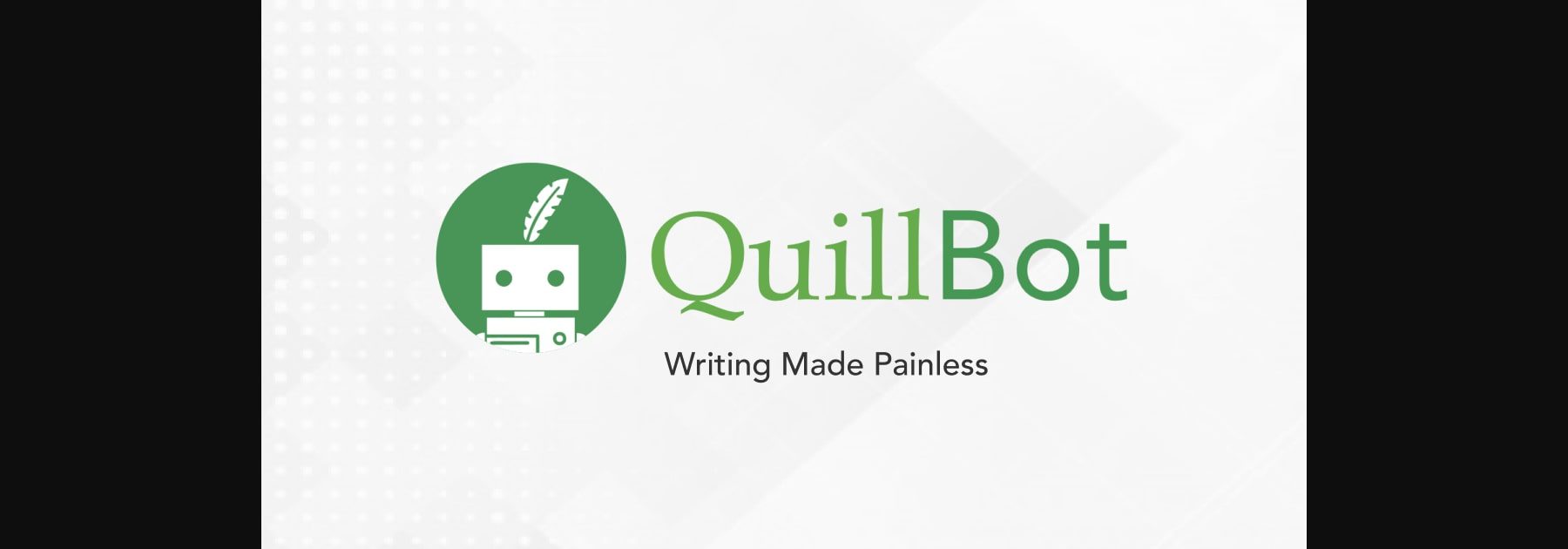
QuillBot AI is a leading AI writing companion and paraphrasing software designed to help anyone elevate the quality of their writing. At its core, it functions as one of the best AI rewriter tools to edit, rephrase, and enhance content like a professional.
It presents various features, including grammar checking, plagiarism detection, and content summarization. As such, QuillBot AI delivers substantial benefits for academics, essayists, and writers. Creating high-quality professional content can be time-consuming, and Quillbot streamlines the process using AI to improve your writing quickly, offering real-time suggestions and one-click solutions. Plus, it is an all-in-one solution that replaces the need to invest in multiple tools, making it cost-effective.
The versatility of the software caters to a diverse audience. While students can utilize its various writing tools, professional writers can efficiently collaborate and summarize lengthy text. If you want to improve your writing process, whether writing an email, an essay, or a long-form blog article, you will find Quillbot AI to be a valuable addition to your writing toolkit. It can revolutionize your writing process to produce surprising results.
How Quillbot AI Works
You can access QuillBot by visiting their online platform on their website . You don’t need to create an account; you can use a free version of QuillBot with limitations. Once you are there, you will see the available tools in the left sidebar. Click any of the tools to launch the user interface for each.
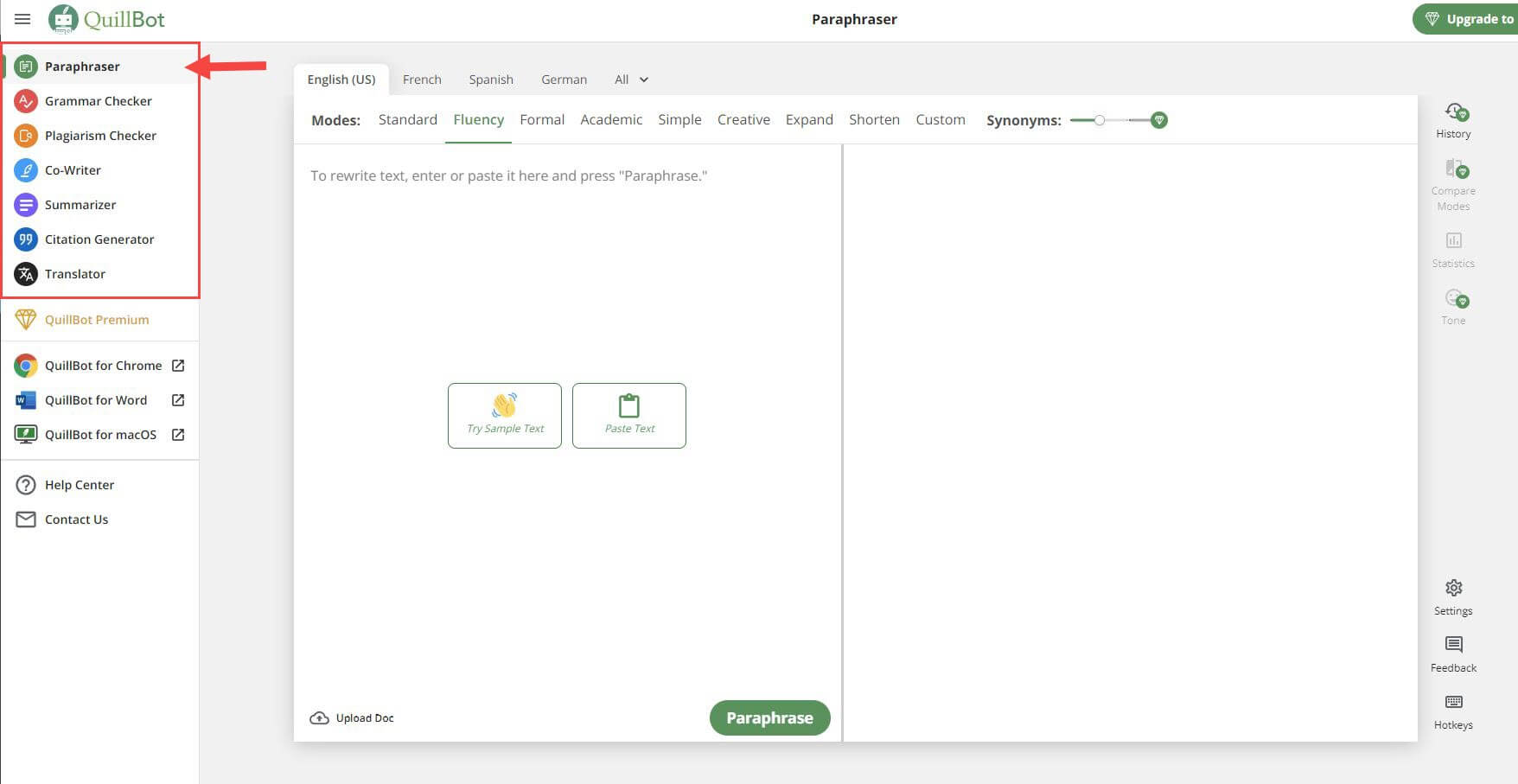
Each tool will have a consistent layout with different features that you can use to start refining your content. For example, when using the Grammar Checker, you can copy and paste your content into the user interface. QuillBot will readily analyze your text, pinpointing broken sentences and grammatical errors you can fix with a single click.
And the other other tools share the same easy-to-use interface and functionality. For instance, the Summarizer makes condensing long-form content or essays easy. Paste your text to generate a summary of key points. Additionally, it features a plagiarism checker, which helps identify and fix plagiarized content to ensure the originality of your content.
QuillBot’s AI functions by learning from datasets. Comprehending grammar, spelling, punctuation, tone, sentence structure, and readability, these datasets serve as knowledge accumulations. So, when users regularly disregard a specific suggestion, the AI adjusts to present more contextually relevant alternatives.
Breaking Down QuillBot AI Features
QuillBot AI offers several features for easy and effective content organization. We’ll delve into these features now.
1. The Paraphraser
QuillBot AI includes a paraphrasing tool. It empowers writers to rephrase text while preserving its central message. It’s an ideal tool for students and aspiring authors, requiring no account signup. Options for ‘Fewer Changes’ or ‘More Changes’ are available, with premium users getting maximum adjustments.
Paraphrase Modes
QuillBot AI assists users in paraphrasing and refining text. It employs seven unique modes, each tailored to specific objectives, to enhance the quality and readability of written content. Whether striving for clarity, professionalism, creativity, or conciseness, QuillBot AI offers a mode to suit your needs.
Here is an example sentence I added to the paraphraser text input area:
“It was a tough match. After three hours of immense struggle, I was able to get the job done.”
1. Standard Mode
Standard Mode serves as the default setting. It balances modifying the text for clarity and fluency while preserving the original meaning. The result is a refined text that maintains its natural flow and readability.
After clicking the Rephrase button, QuillBot swiftly provided a paraphrased output in Standard Mode. It merits noting that the level of paraphrasing hinges on the level of synonyms you set in the Synonyms bar at the right of the Modes bar above the content. The higher the level, the more liberty you give QuillBot to change the words of the original content.
The ensuing result was generated with a low Synonyms bar:
“It was a challenging game. I had to struggle for three hours before I was able to finish the task.”
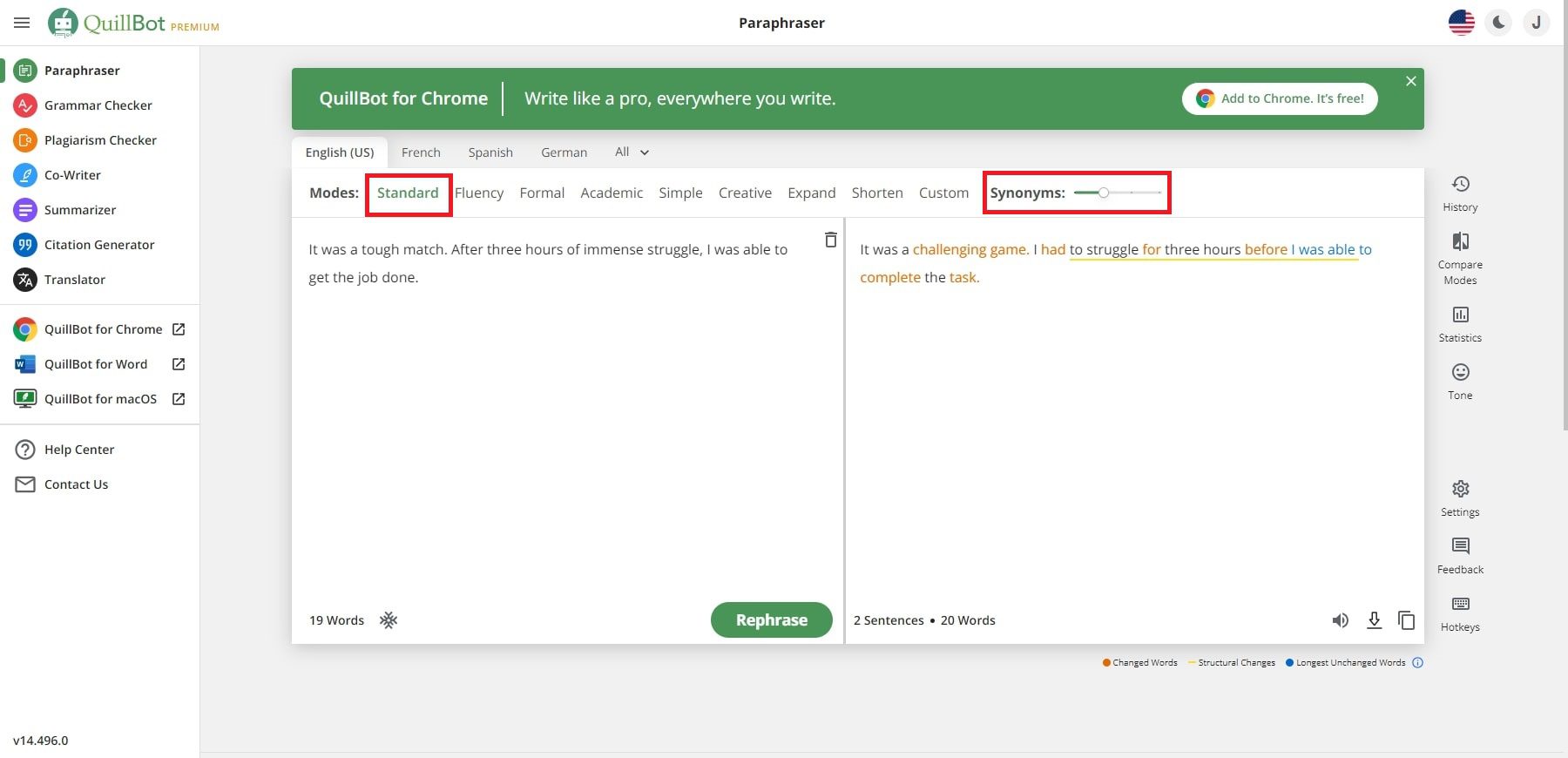
The following result was generated with a maximum level of Synonyms:
“It was a challenging game. I had to battle for three hours before I was able to finish the task.”
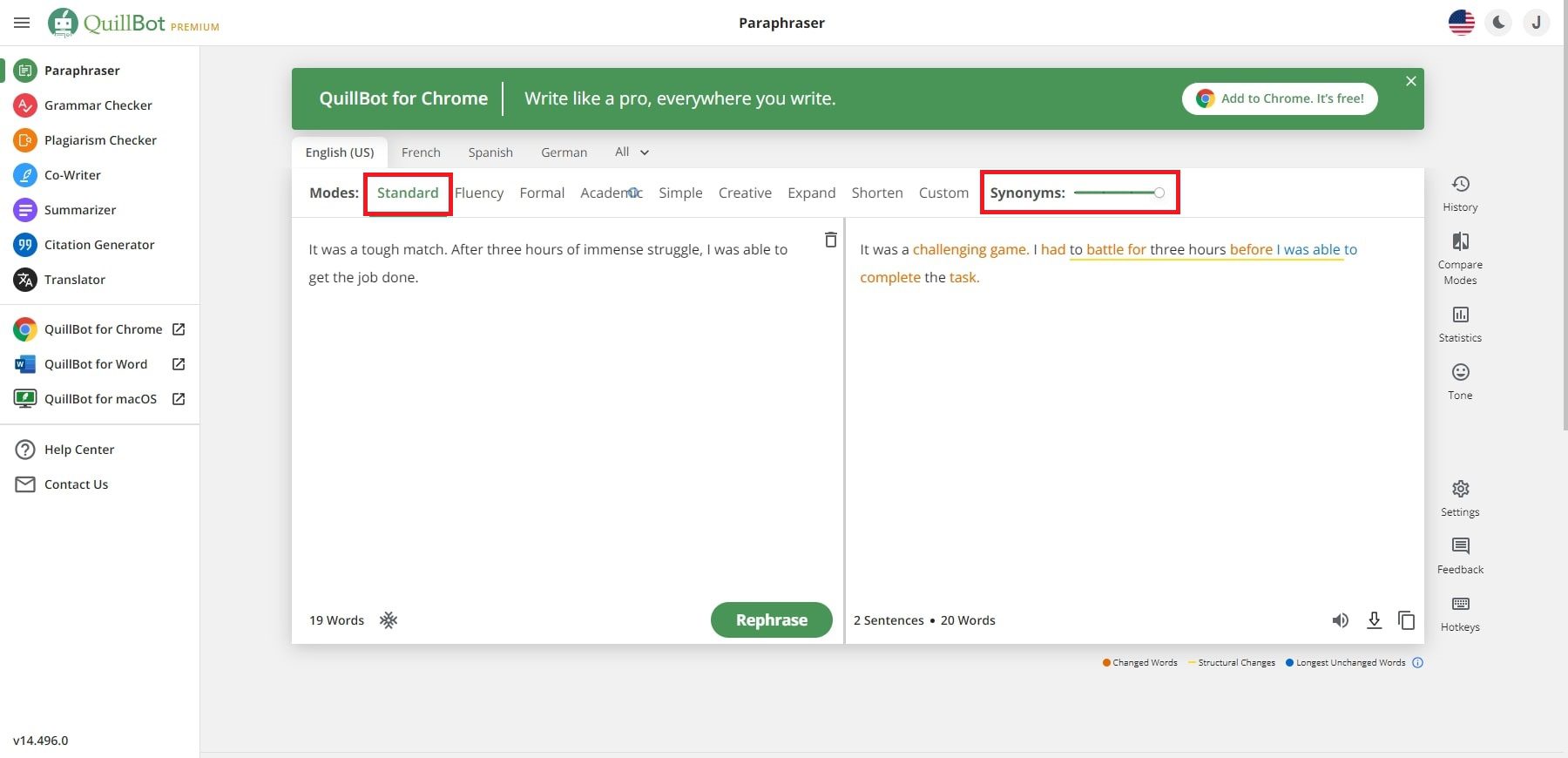
With just one sentence, you can see that only one word changed, but with larger blocks of content, you will see that QuillBot will make more word changes with a higher level of synonyms.
2. Fluency Mode
In Fluency Mode, QuillBot AI ensures that the text is grammatically sound and genuinely readable. It makes minimal changes, primarily correcting grammar and providing the text sounds natural. Synonym substitutions are kept to a minimum, preserving the original meaning.
We paraphrased the same content in Fluency mode . It generated the following output:
“It was a difficult match. I completed the task after three hours of intense effort.”
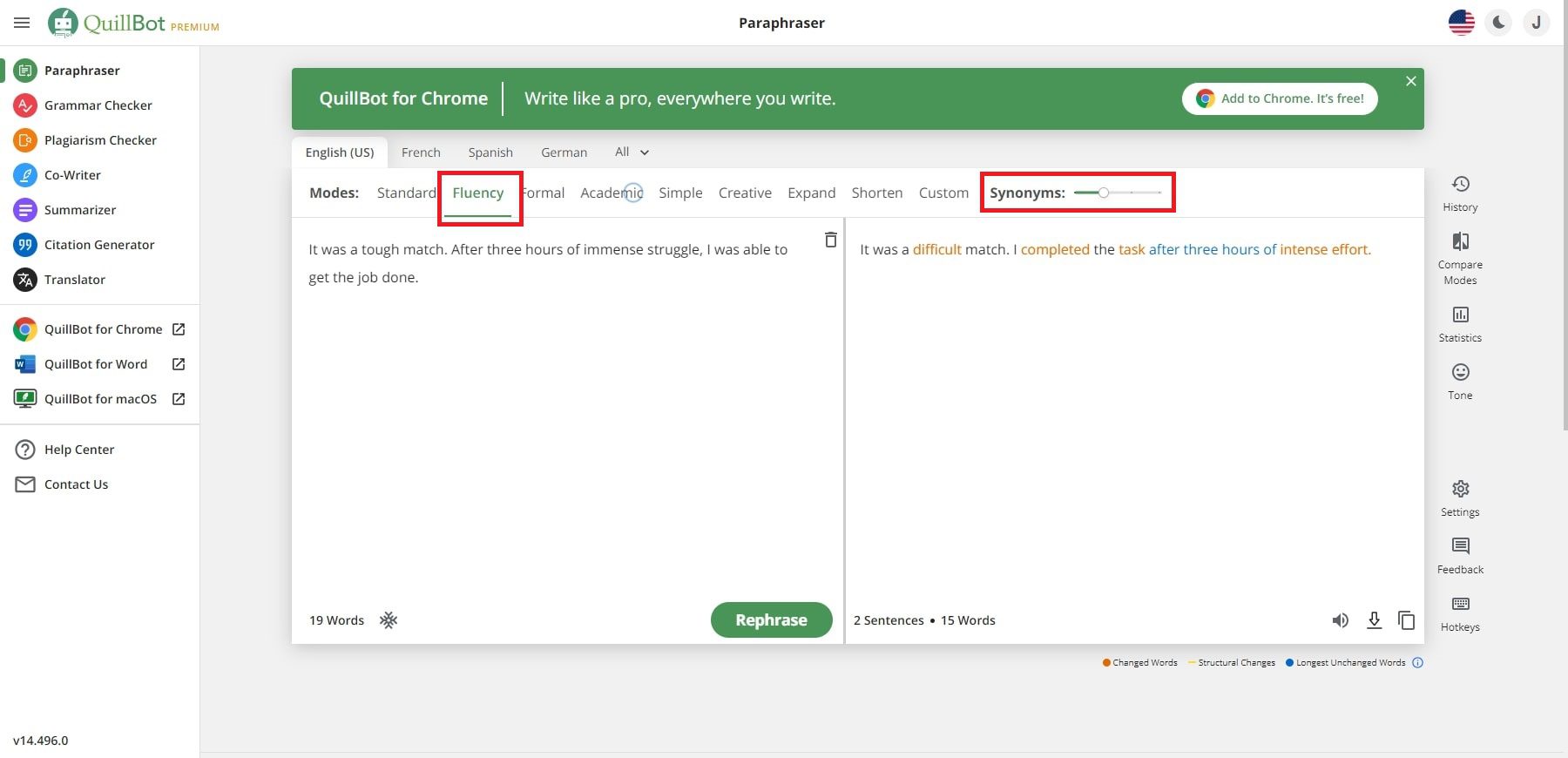
3. Formal Mode
Formal Mode is the ideal choice for those working in academic or professional contexts. It transforms the text to sound more polished and professional, making it suitable for business reports, academic papers, and formal documents.
We paraphrased the same content in Formal Mode . It generated the following output:
“ It was a difficult match. After three hours of arduous effort, I was able to complete the task. ”
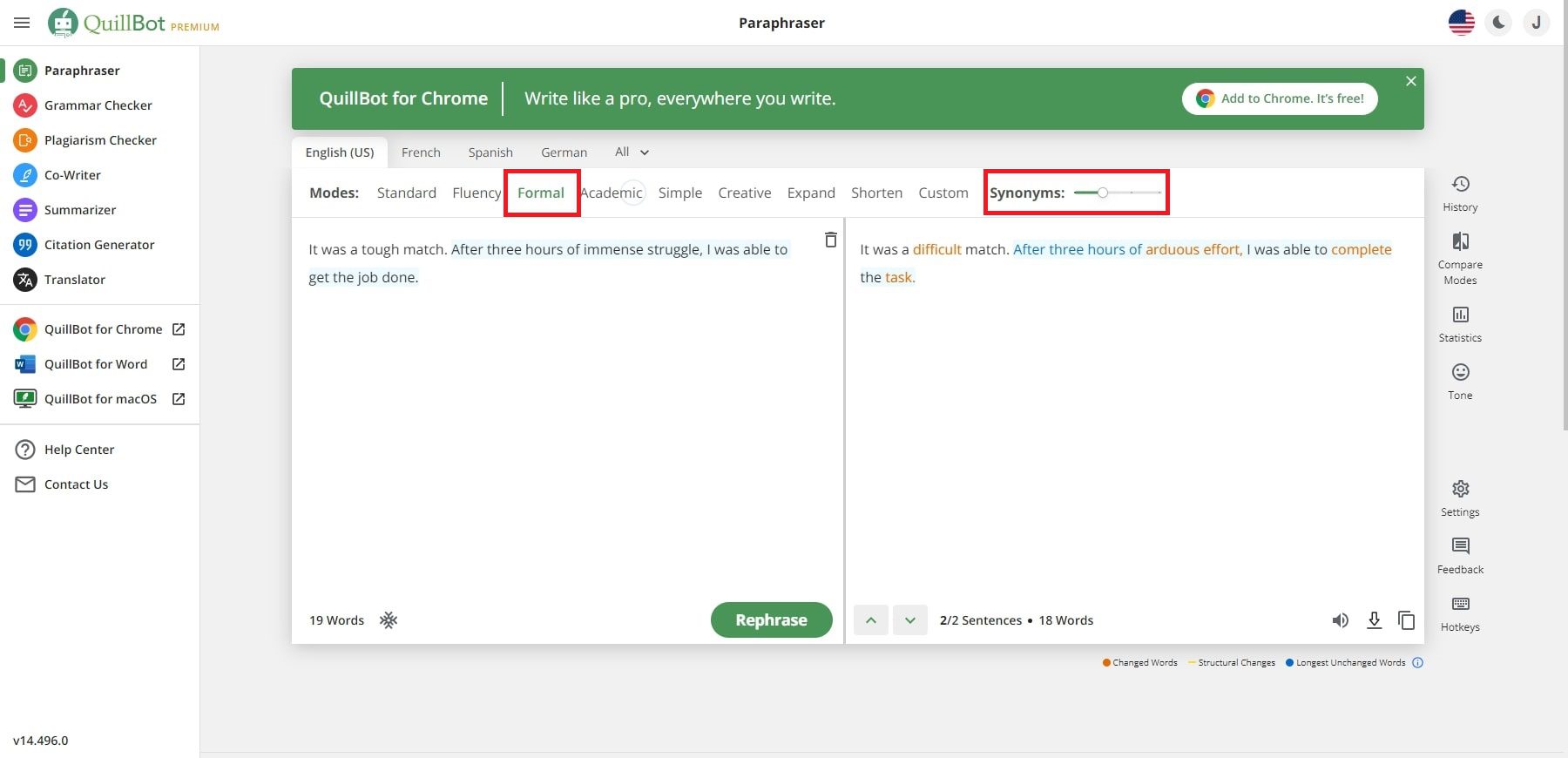
4. Academic Mode
Then, we paraphrased the same content in Academic Mode . Unlike the other modes, it doesn’t have any Synonyms bar. Instead, it seemed to give the content more details and wording suitable for academia. It generated the following output:
“ The contest was challenging. Following a prolonged period of three hours, characterized by significant exertion and effort, I successfully completed the task at hand. ”
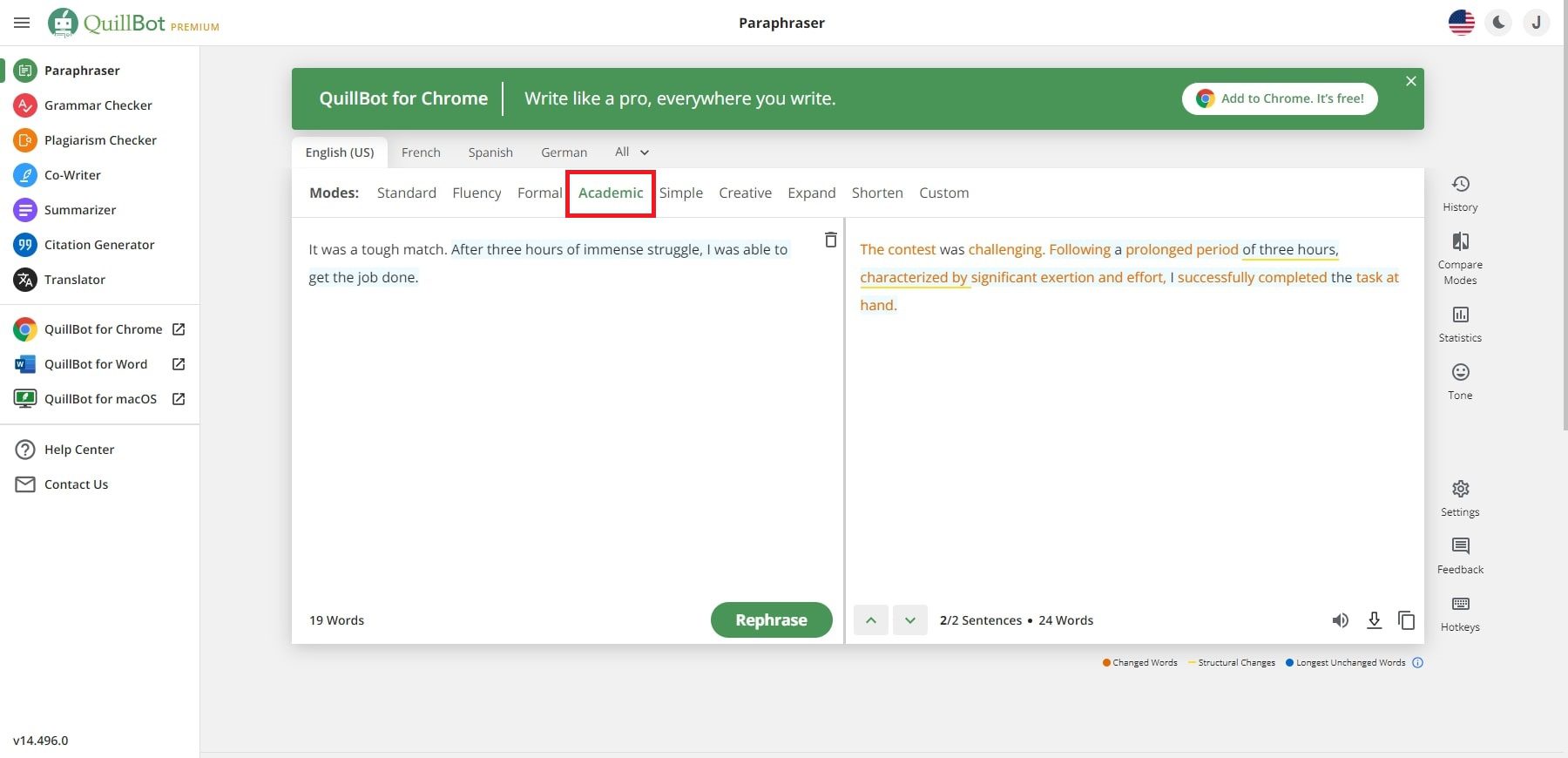
5. Simple Mode
Simple Mode simplifies the text, making it easier to understand and more accessible to a broader audience. It is an excellent choice when clarity and straightforward communication are essential.
We paraphrased the same content in Simple Mode . It generated the following output:
“ It was a hard game. I was able to finish the job after three hours of hard work. ”
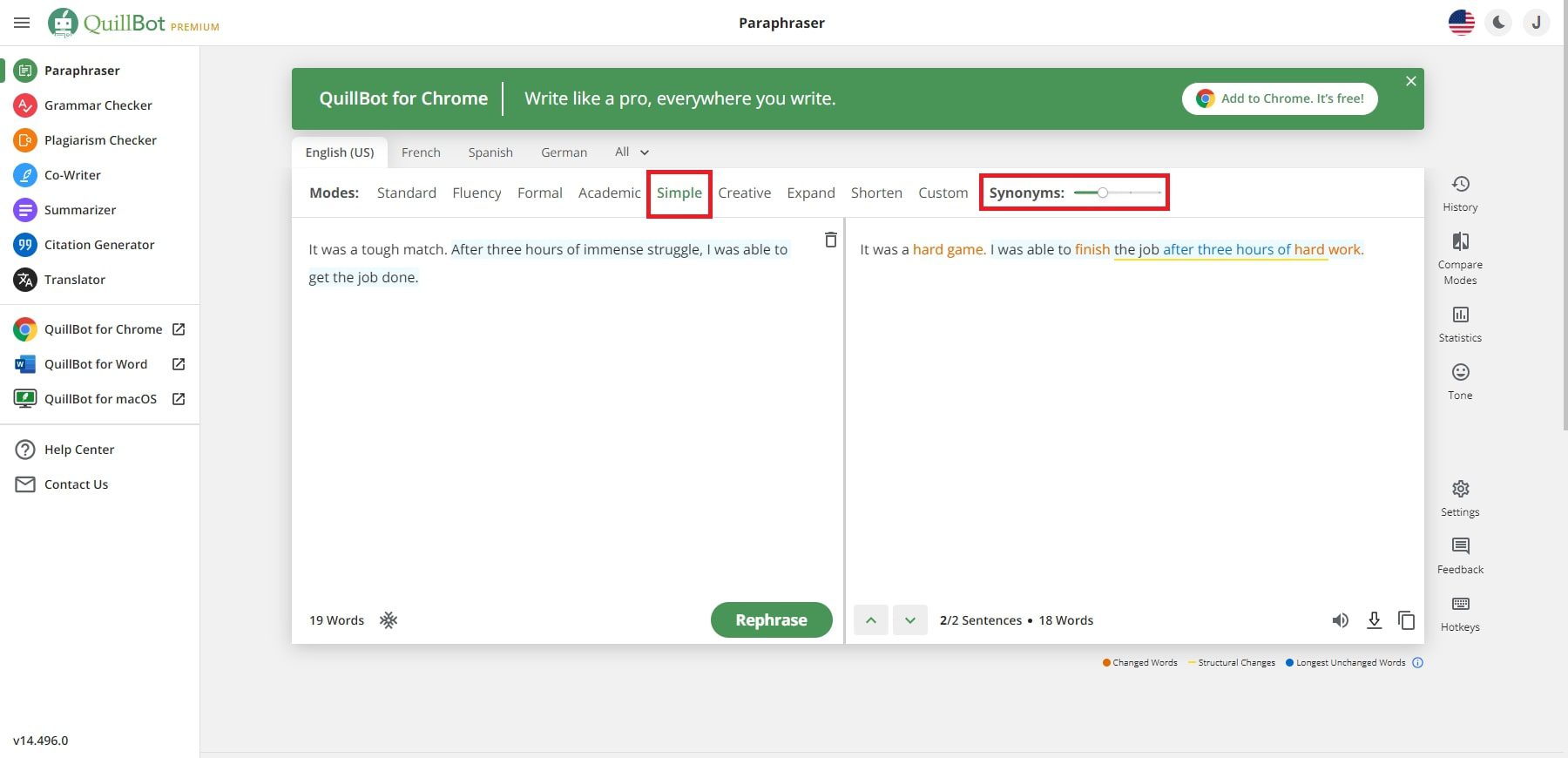
6. Creative Mode
Creative Mode is the way to go if you’re looking to unleash your creativity and generate entirely unique content. This Mode substantially changes the text, potentially altering the original meaning. It’s a valuable tool for content creators seeking a fresh spin on their writing.
We paraphrased the same content in Creative Mode . It generated the following output:
“ That was one intense contest. It took me three hours of relentless effort, but I finally completed the task at hand. ”
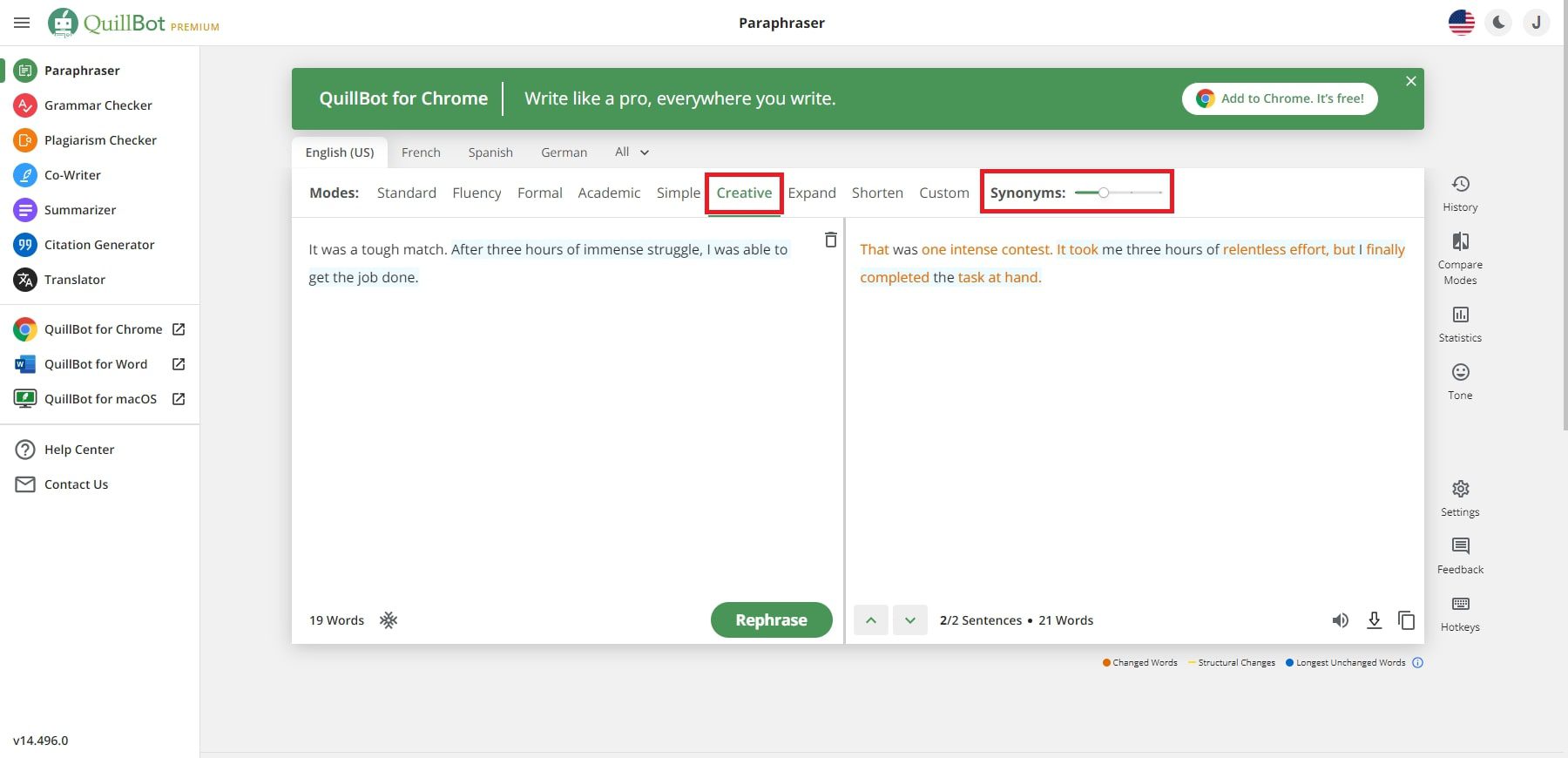
7. Expand Mode
Expand Mode is perfect for those aiming to increase the length of their text. It adds words and details while retaining the original meaning, making it valuable for projects requiring a higher word count.
We paraphrased the same content in Expand Mode . It generated the following output:
“ It was a difficult match to watch. I had to put in a lot of effort for three hours before I was finally successful in completing the task. ”
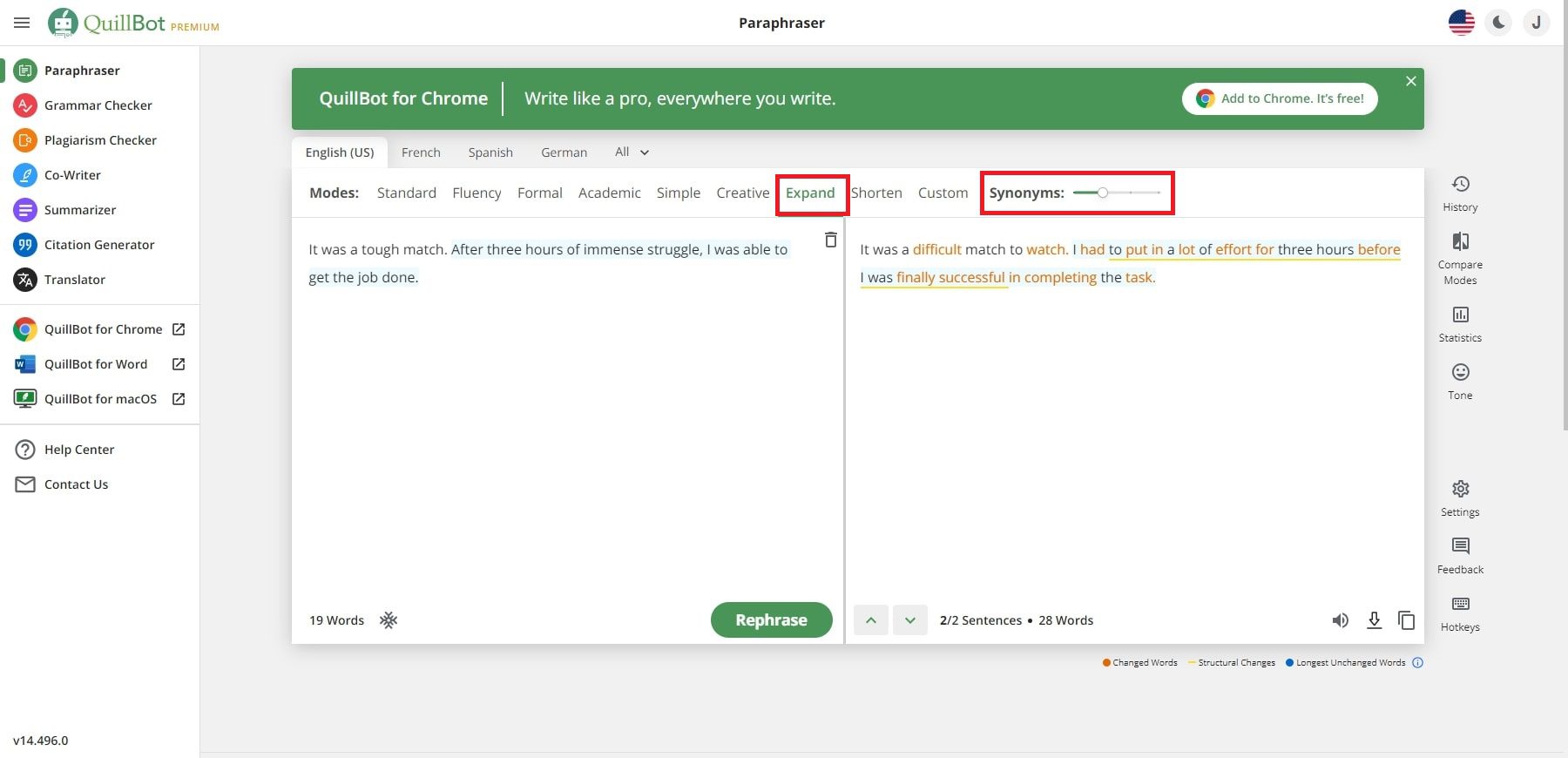
Then, we produced an output with a high level of Synonyms as follows:
“The contest was a challenging one. I was able to finish the work, despite the fact that it took me three hours of intense effort.”
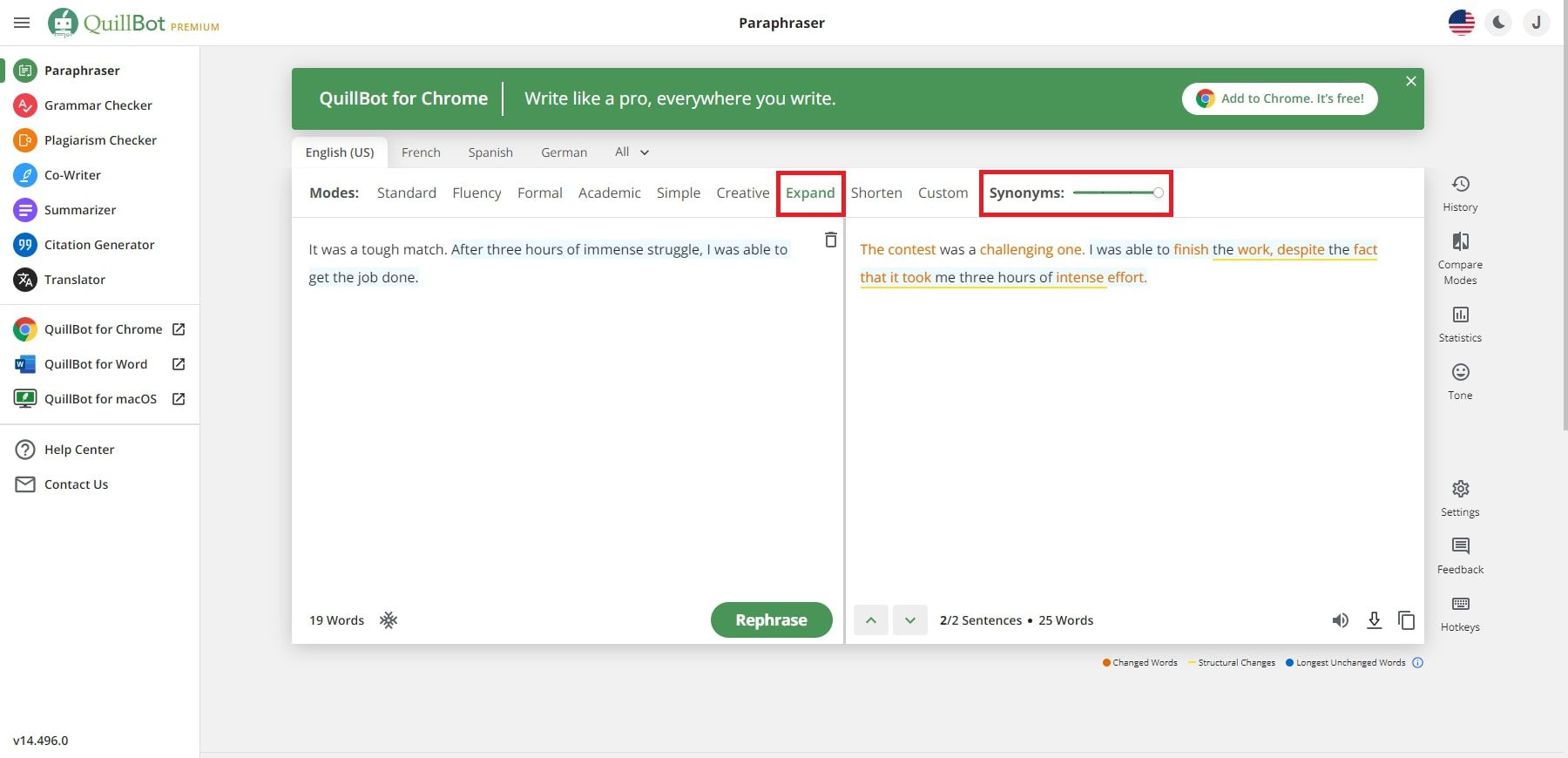
8. Shorten Mode
Shorten Mode comes to the rescue when you need to reduce the overall word count while maintaining the essence of your text. It trims unnecessary words and phrases, delivering a concise version of your content.
Lastly, we paraphrased the same content in Shorten Mode. It generated the following output:
“ The match was hard. I finished after three hours of intense struggle. ”
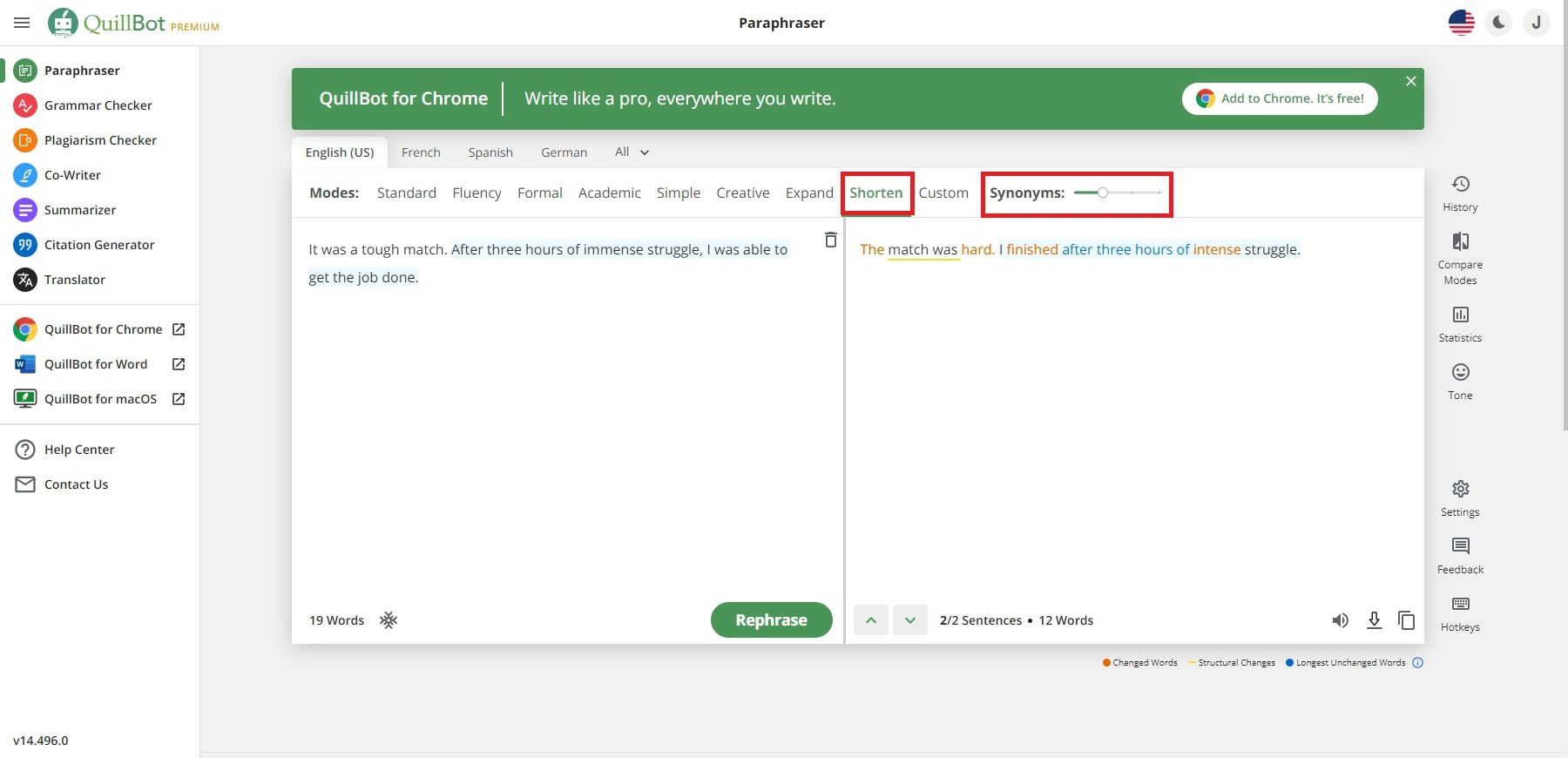
Paraphraser Statistics
The ‘Statistics’ feature offers insights into text complexity and readability. It aids writers in adjusting their style to the desired tone and audience. Premium subscribers unlock tonality analysis, which assesses reader perceptions to enhance persuasive writing.
I have used the same content as the previous one in the “Fluency” mode. It has generated the following statistics.
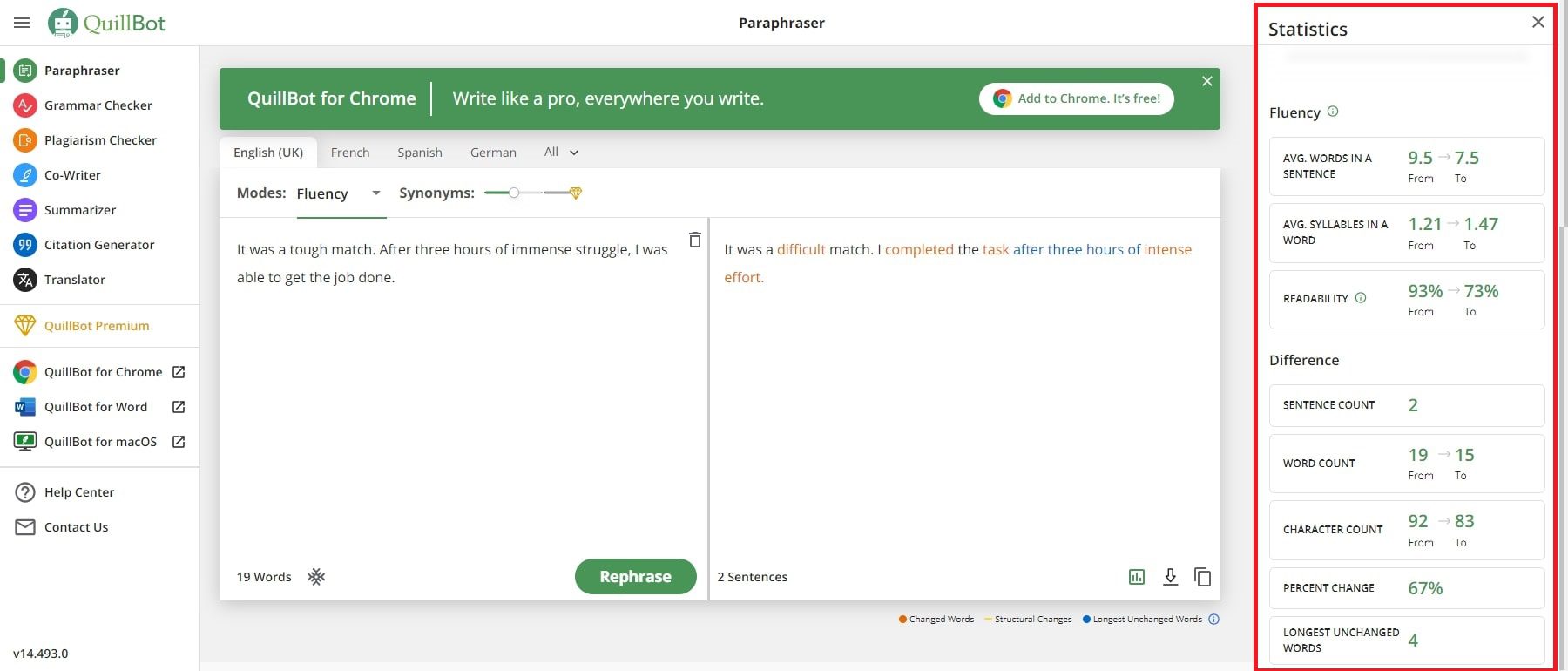
The Statistics of the generated content are based on the following aspects:
- Average words in a sentence
- Average Syllables in a word
- Readability
- Sentence Count
- Character Count
- Percent Change
- Longest Unchanged Words
Paraphraser Settings
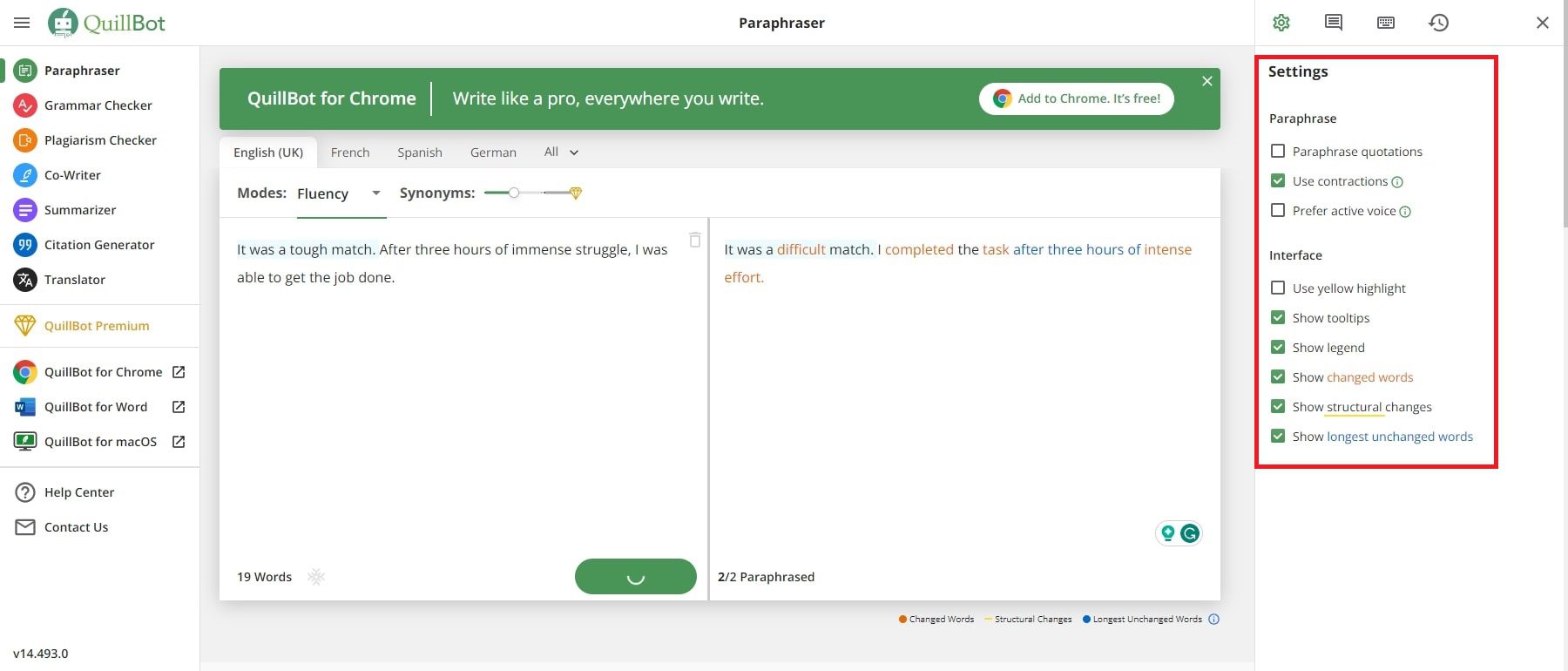
The “Settings” feature in the Paraphraser tool provides options to control how you want your content to be paraphrased and how you want the results to be displayed on the interface. In terms of paraphrasing the content, you choose the following:
- Paraphrase quotations
- Use contractions
- Prefer active voice
Under the Interface options, you can select the following:
- Use yellow highlight
- Show tooltips
- Show legend
- Show changed words
- Show structural changes
- Show the longest unchanged words
Overall, these settings do seem to give users more control and help them identify changes to their content much easier.
Paraphraser Compare Modes
Compare Modes is a valuable feature exclusively available to premium users, offering a comprehensive view of how a sentence is transformed across different modes within the platform. This feature enables users to evaluate and choose the most suitable rendition for their content by comparing various paraphrased versions. To access Compare Modes, locate and click on the dedicated icon in the settings bar on the right side of the page.
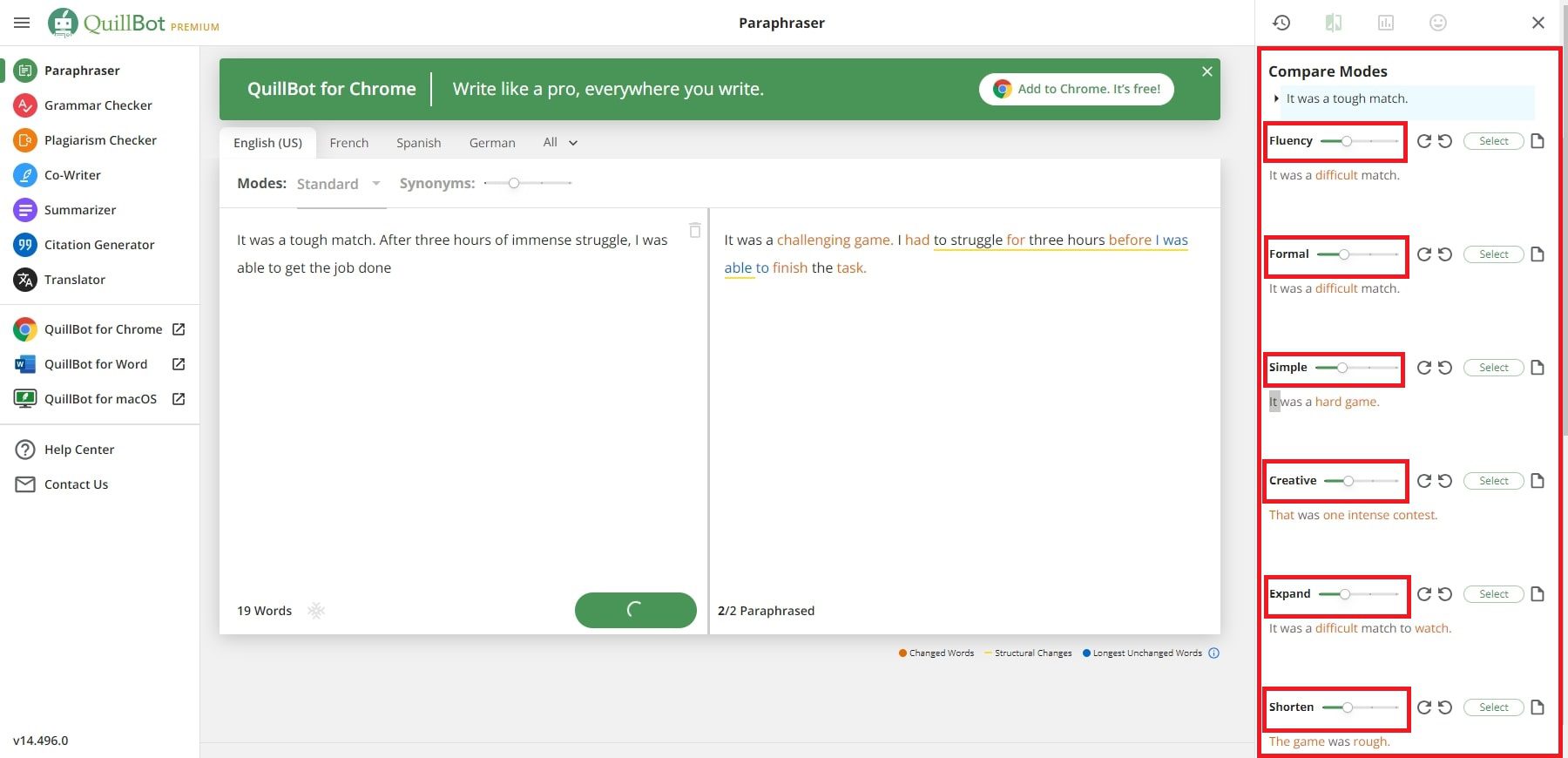
Once activated, Compare Modes opens a sidebar on the right-hand side of the screen, displaying the original sentence before paraphrasing and the results generated by all available modes simultaneously. The system defaults to the effect produced by the Mode in which the sentence was paraphrased. You can easily click the “Select” button next to the desired text to select your preferred sentence, seamlessly replacing the paraphrased sentence in your results. Additionally, you can further modify individual sentence results by clicking on circular arrow icons or making copies of them with a simple click on the copy icon. This powerful feature empowers users to fine-tune their content according to their specific needs and preferences, streamlining the content creation process.
Paraphraser History
By accessing the history feature, you can go through all the previous content you have modified. In my case, I checked my history, and it showed the last text paraphrased. It also shares the date and time when the content was modified.
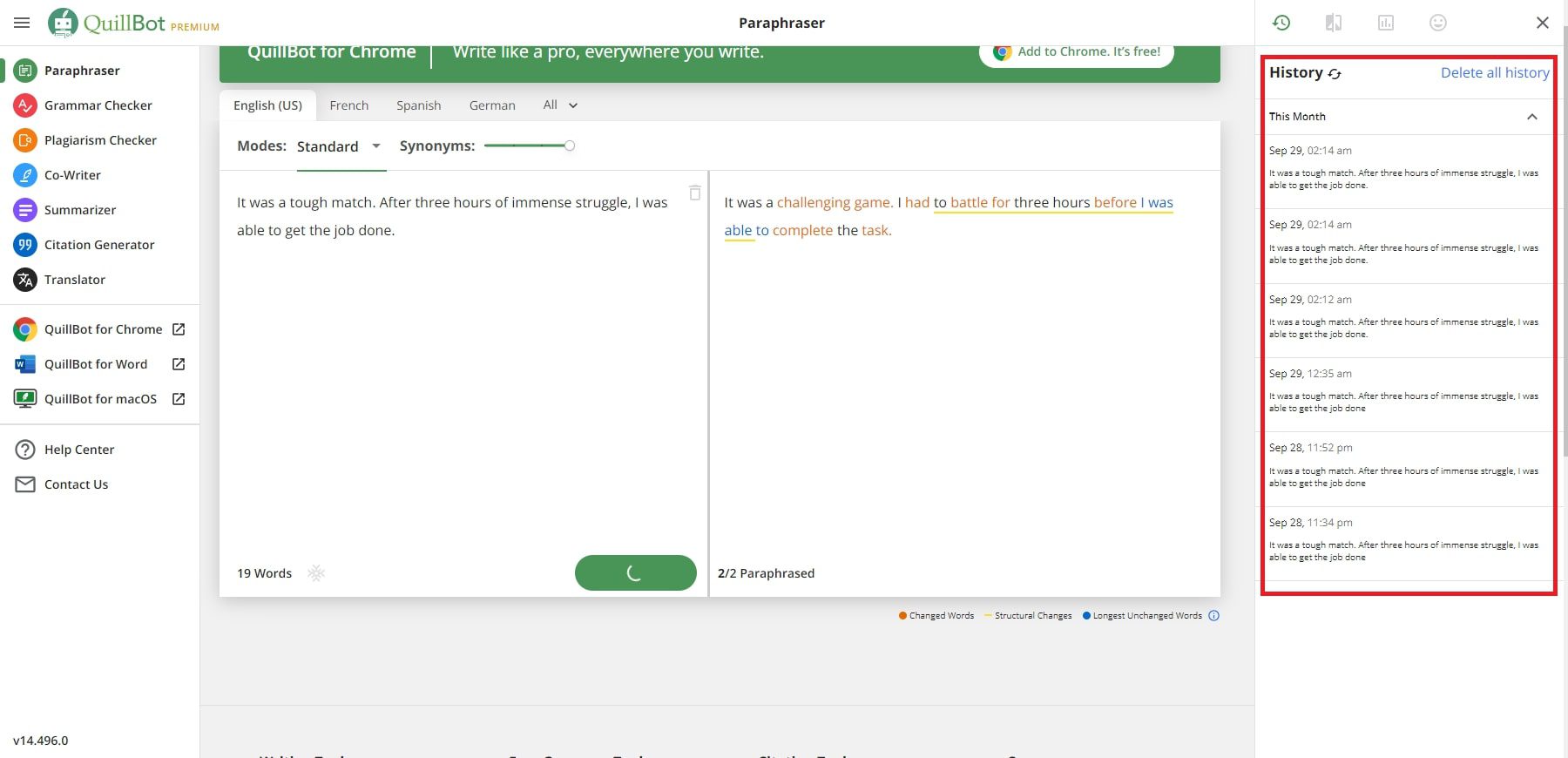
The “Tone” feature in QuillBot AI paraphraser allows users to control and tailor the emotional and stylistic tone of their paraphrased content. With this feature, users can choose from various preset tones, such as casual , unfriendly , wordy , complex , and unclear . It ensures that the paraphrased text aligns perfectly with the desired style and intent. Whether you need your content to sound professional and academic or friendly and conversational, the Tone feature empowers you to achieve the right mood for your writing.
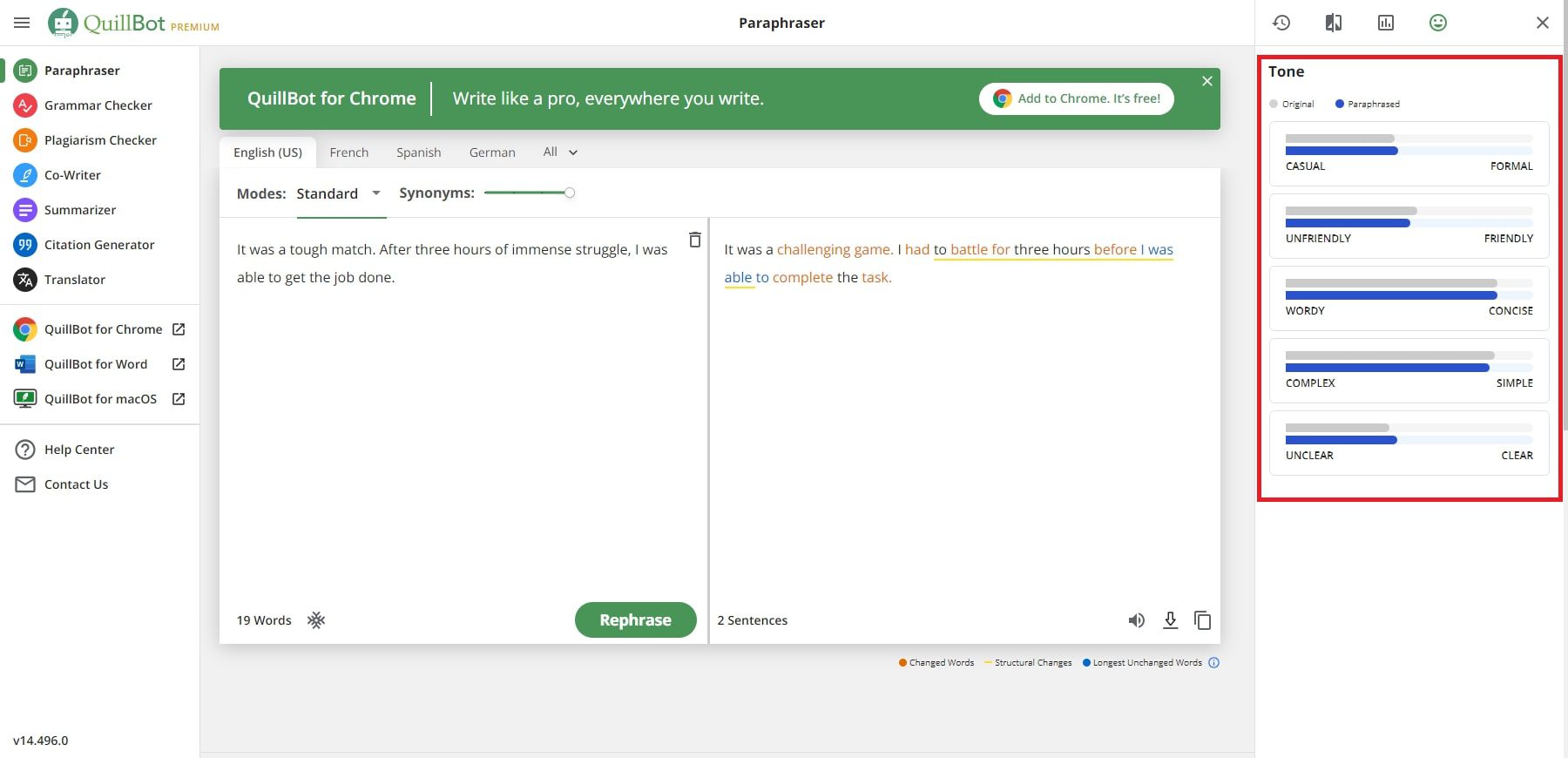
Paraphrasing for Different Languages
Quillbot AI supports 23 different languages for paraphrasing purposes. Not only does this make the tool more accessible, but it also comes in handy for making tweaks to the content generator by Quillbot’s translator tool.
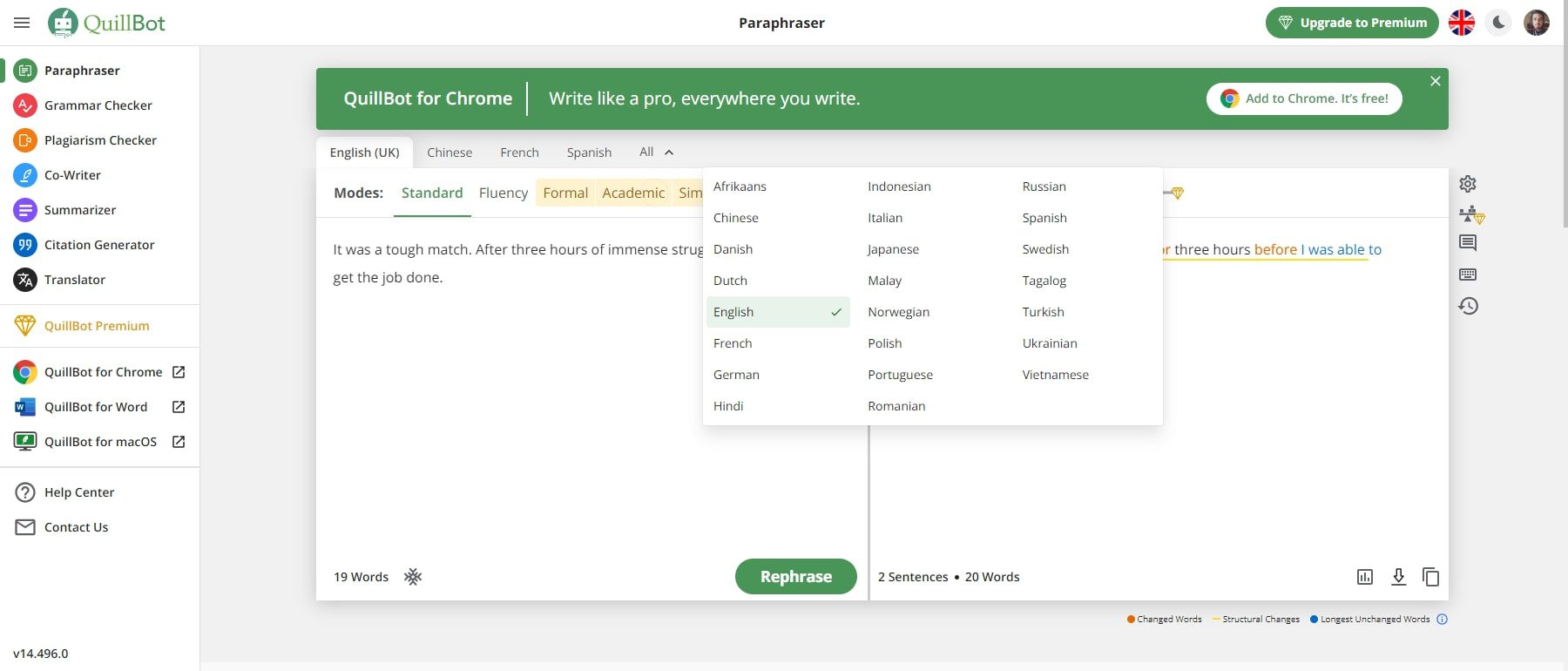
2. The Grammar Checker
Quillbot AI offers a user-friendly and free Grammar-checking feature that doesn’t require signing up. When you paste your text into Quillbot’s editor, it identifies and highlights grammatical errors, including punctuation and spelling. With a convenient Fix All Errors option, you can swiftly correct multiple issues simultaneously. This Grammar Checker enhances writing precision and consistency. It quickly pinpoints potential errors in red, simplifying the editing process. This real-time underlining and instant correction feature saves writers time and improves productivity.
For instance, here is an example sentence I added to the grammar checker text input area:
“ Manchester United signed Sofyan Amrabat on a season-long loan move from Fiorentina. The Morocco midfielder has been desperate to join Erik ten Hag’s team since getting linked to the Red Devils in June. However, Manchester United’s plans differed on Deadline Day as they wanted to sign Fulham’s Joao Palhinha instead. ”
After copy-pasting the text into the Grammar Check, it will detect all the potential errors within the content. By putting your cursor on the underlined words, it will show you the errors individually.
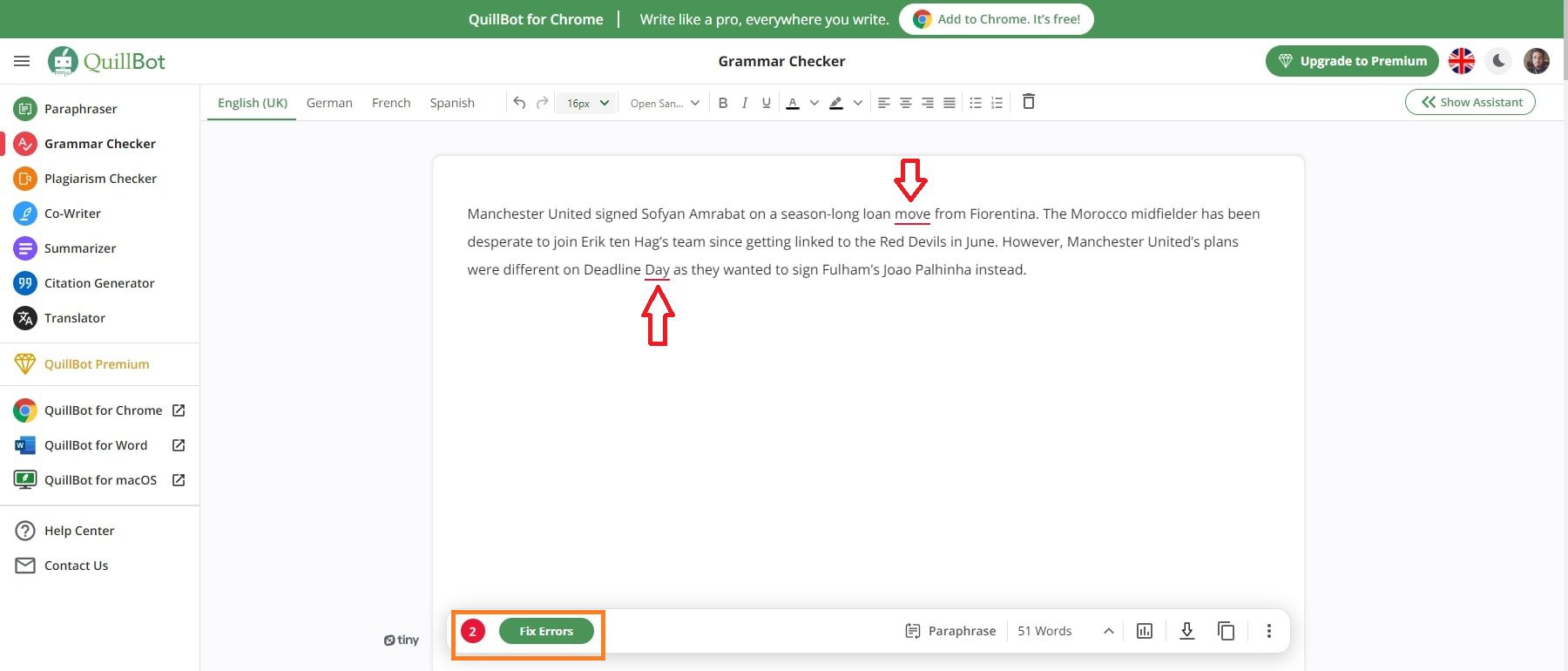
Once you remove all the errors, it will provide you with the correct grammatical content. It will generate the following content.
“ Manchester United signed Sofyan Amrabat on a season-long loan deal from Fiorentina. The Morocco midfielder has been desperate to join Erik ten Hag’s team since getting linked to the Red Devils in June. However, Manchester United’s plans were different on Deadline Day, as they wanted to sign Fulham’s Joao Palhinha instead. ”
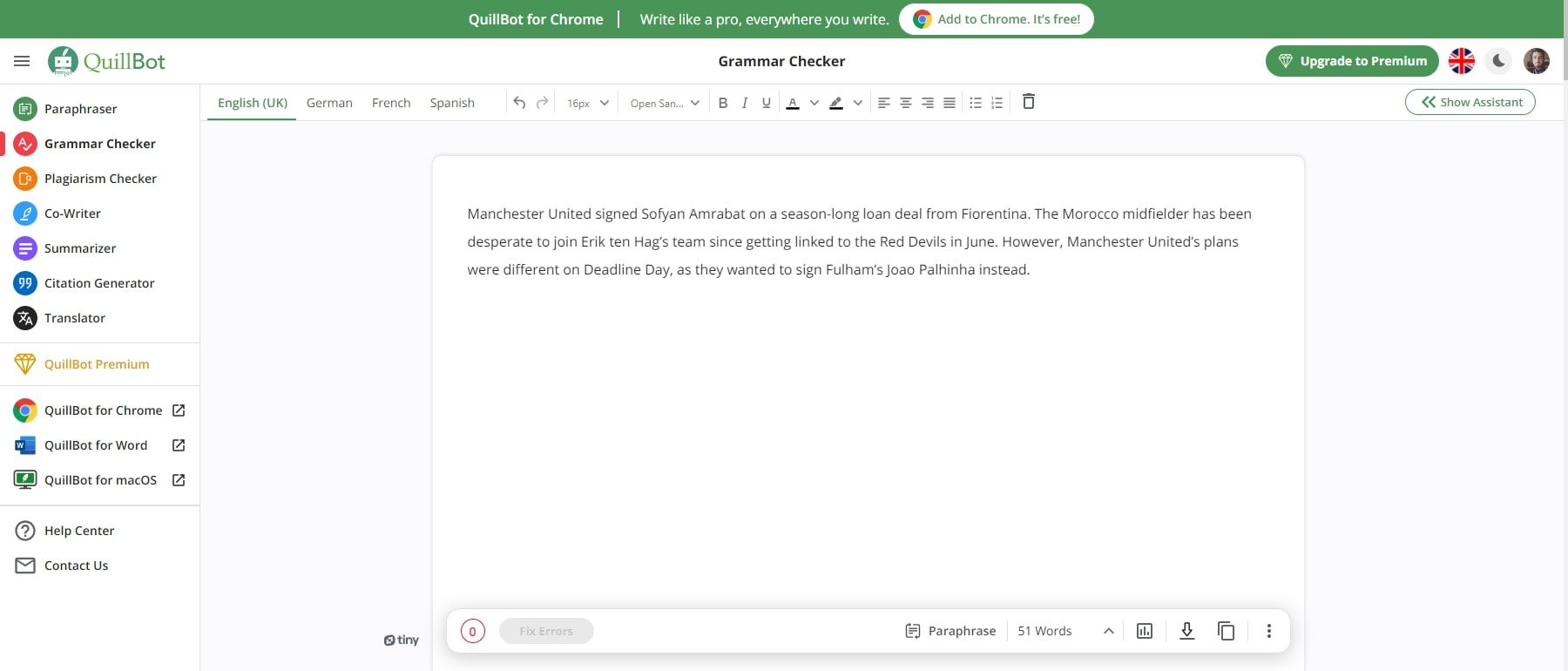
Furthermore, it seamlessly integrates with Quillbot’s Paraphrase tool, offering a comprehensive writing experience without needing an account. Its grammar-checking feature is valuable for writers seeking error-free, professional content.
3. Summarizer
Quillbot AI provides a Summarizer tool that condenses lengthy texts or articles into concise summaries, making it invaluable for students, researchers, and professionals.
Users can choose between Short and Long summarization options to control the level of detail. The Short summarization offers a brief overview, ideal for quickly grasping the central ideas or skimming through multiple articles. In contrast, the Long outline provides a more comprehensive summary, suitable for in-depth analysis or a deeper understanding of the text.
Quillbot AI’s Summarizer utilizes natural language processing to extract critical information while preserving the original context. It offers two summarization types: Key Sentences and Paragraph modes.
For instance, I added a block of content to the summarizer text input area. Using the Key Sentences feature, the tool has created five articulate points that summarize the content.
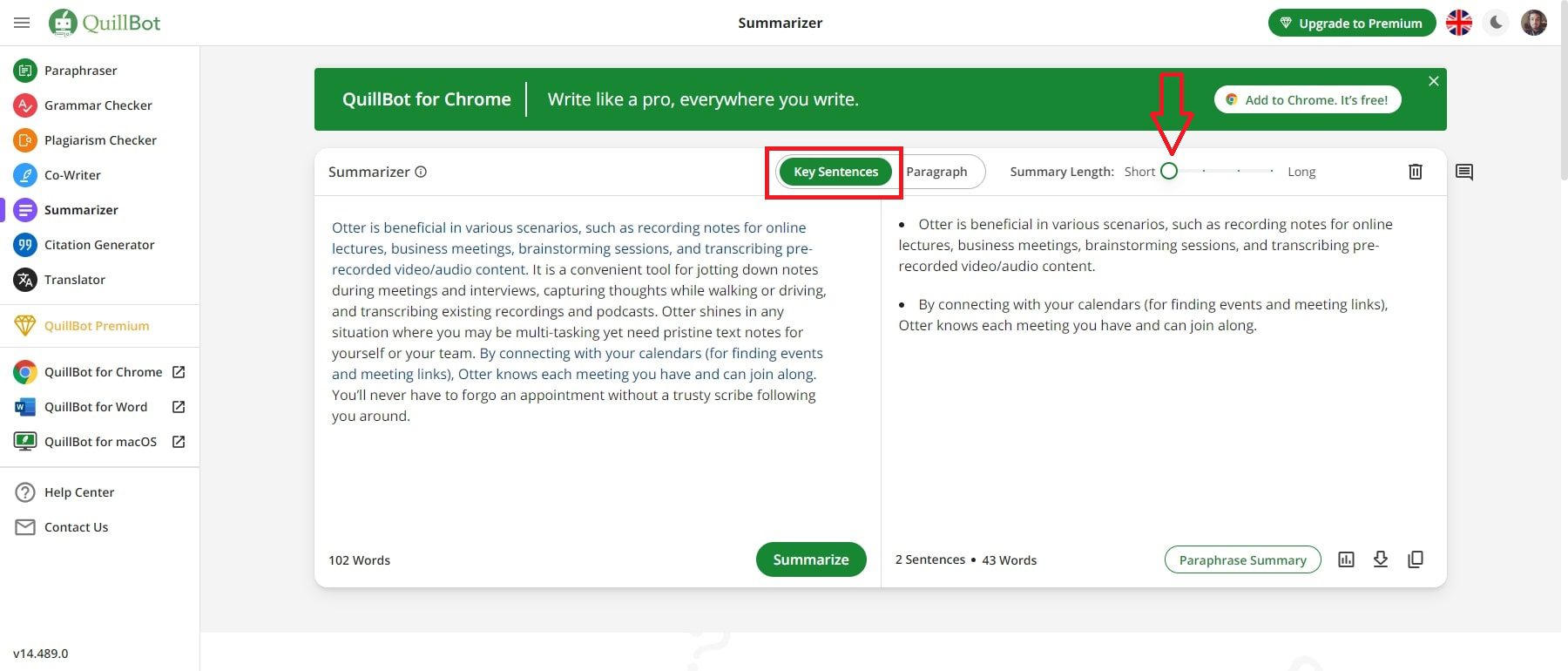
Changing the Summary Length can increase or decrease the depth of those points.
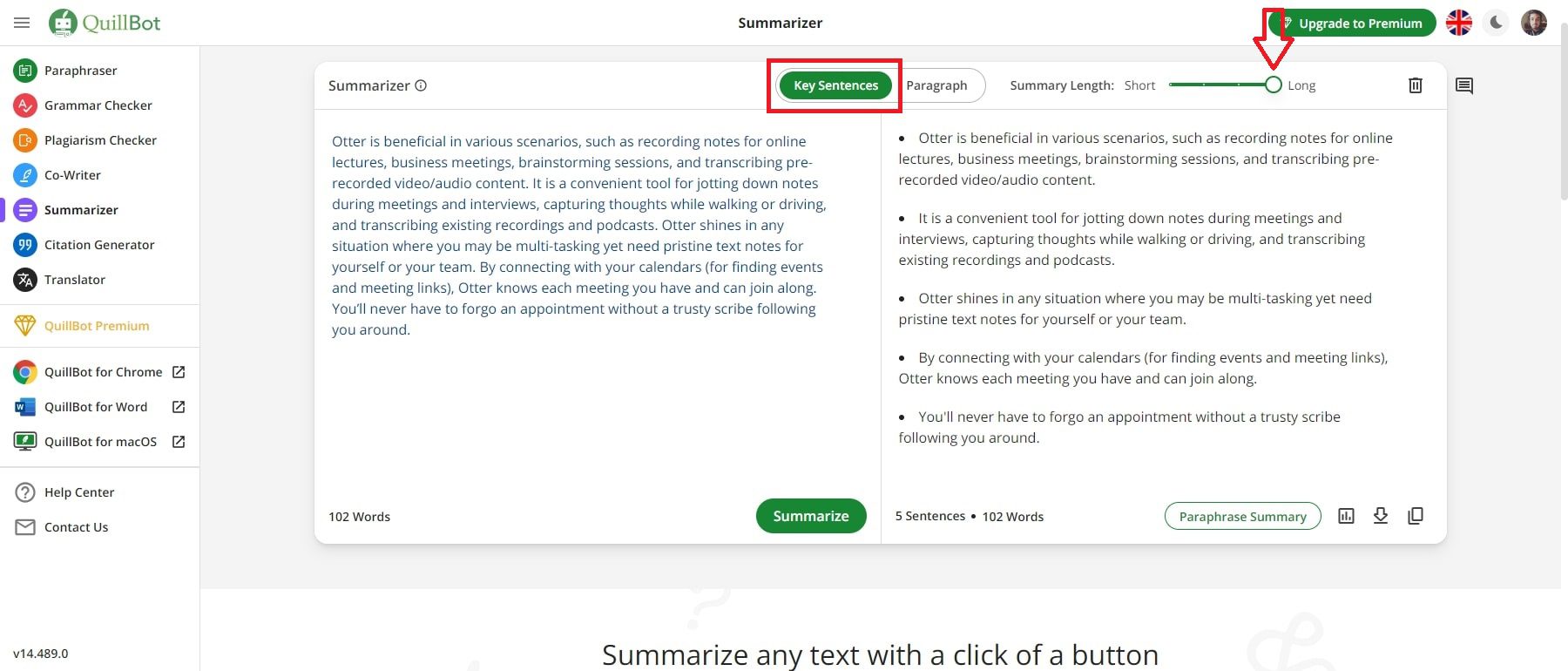
Selecting the Paragraph mode will provide a summary of the content in paragraph form.
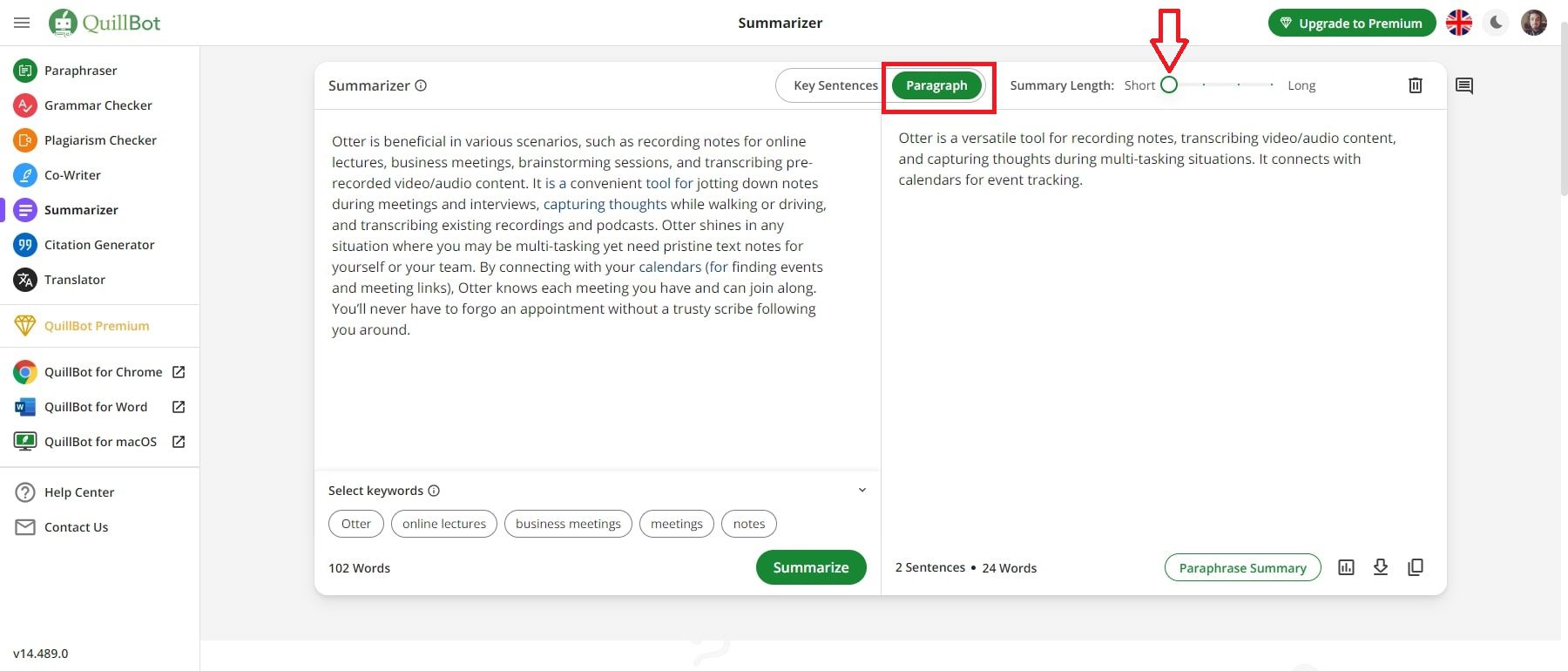
Like the Key Sentences mode, the length of the summary can be changed by adjusting the Summary Length .
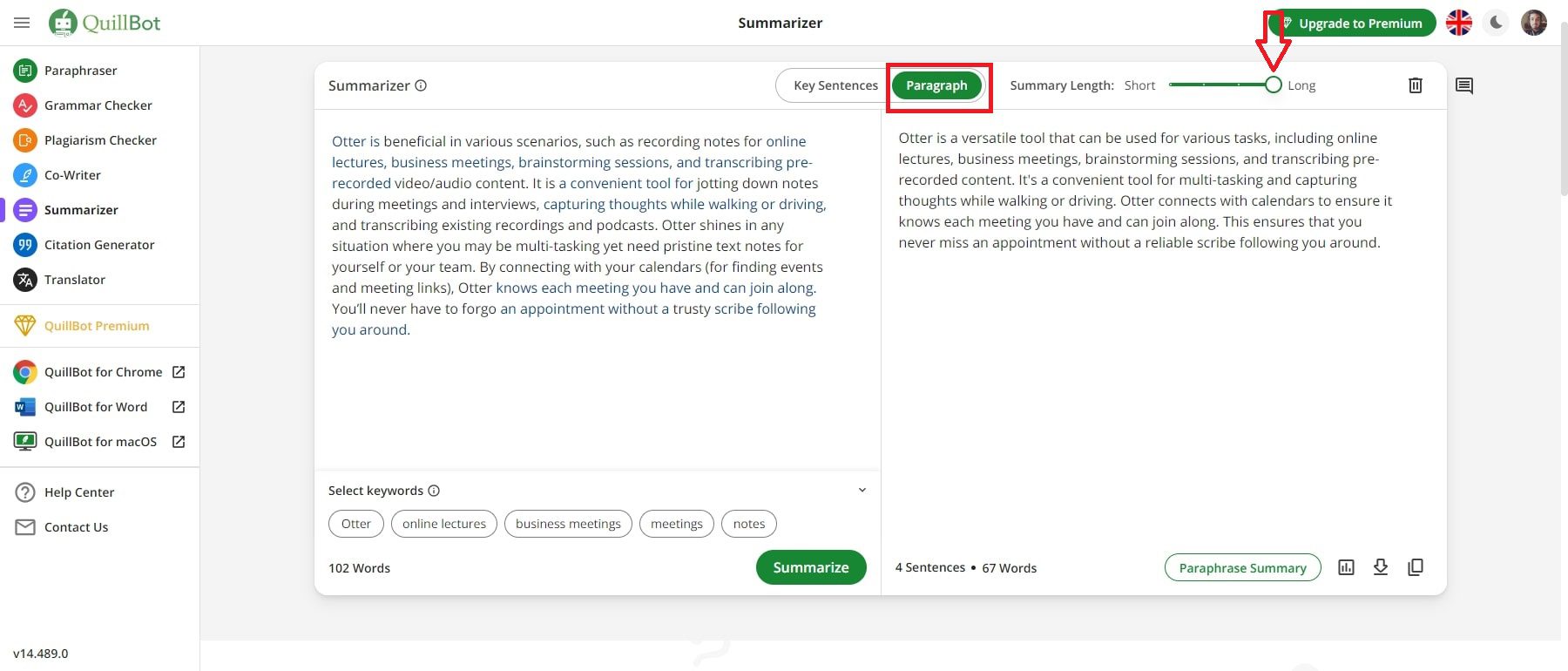
This feature streamlines research, study, and content review processes, enhancing productivity and comprehension for users across various fields.
4. Citation Generator
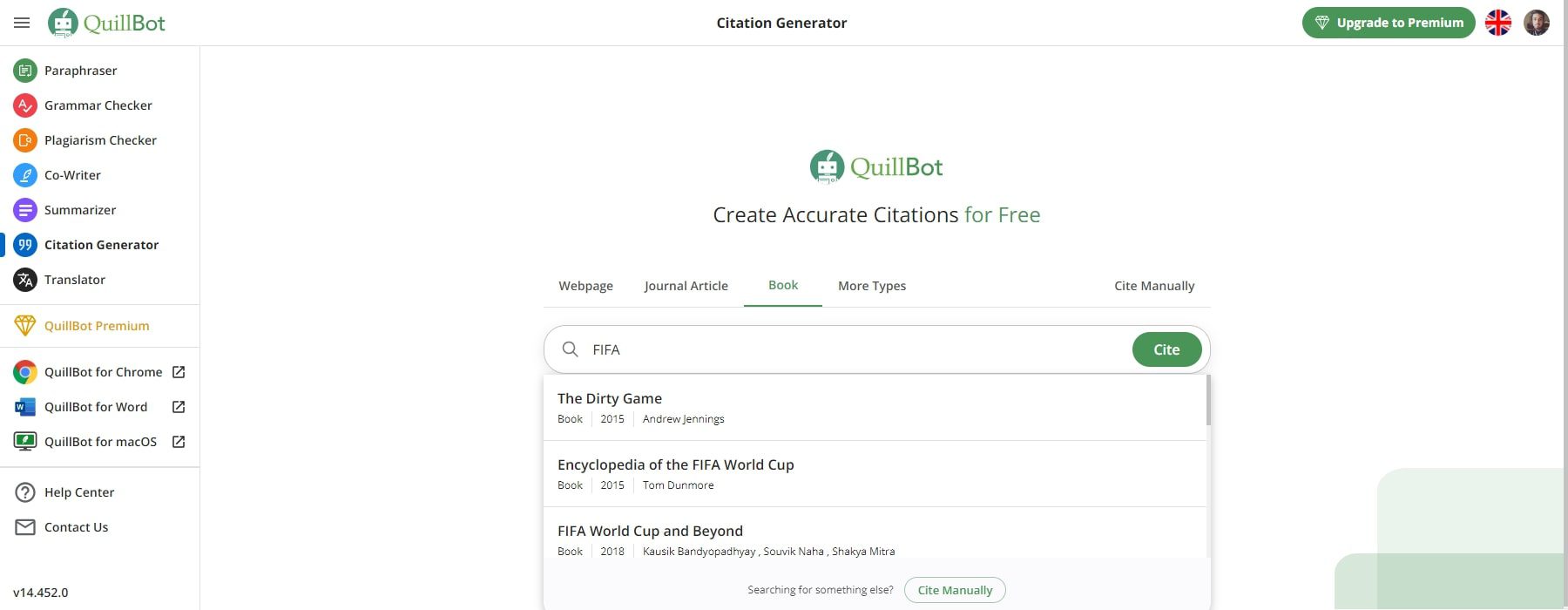
QuillBot’s Citation Generator is a valuable tool that simplifies the often complex process of citing sources in academic and professional writing. It allows users to choose from various citation styles and formats, ensuring compliance with specific guidelines and educational requirements. This feature dramatically reduces the potential headache associated with accurate source attribution.
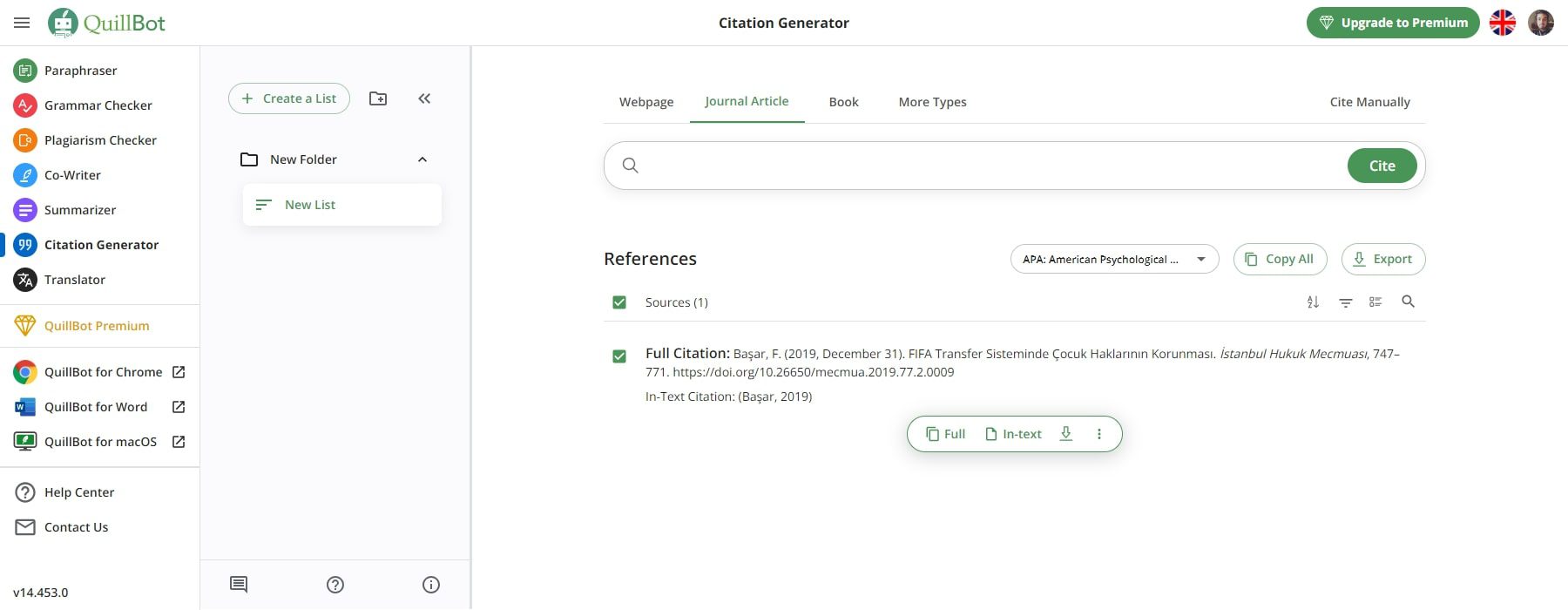
It supports common APA, MLA, and Chicago styles, covering reference types like books and websites. With an intuitive interface, it swiftly generates in-text and complete citations, labeled and exportable to Microsoft Word. By automating this process, QuillBot’s Citation Generator saves users time and ensures proper crediting of sources, benefiting those involved in research and academic writing projects.
5. QuillBot Plagiarism Checker
Quillbot AI provides a plagiarism checker, which is a premium feature. It eliminates the need for external tools to verify content originality. Premium users can paste their content into the checker, receiving results within minutes, indicating if the content is unique or plagiarized. Premium members can scan up to 20 pages per month with this tool, making it suitable for various types of content, including research papers.
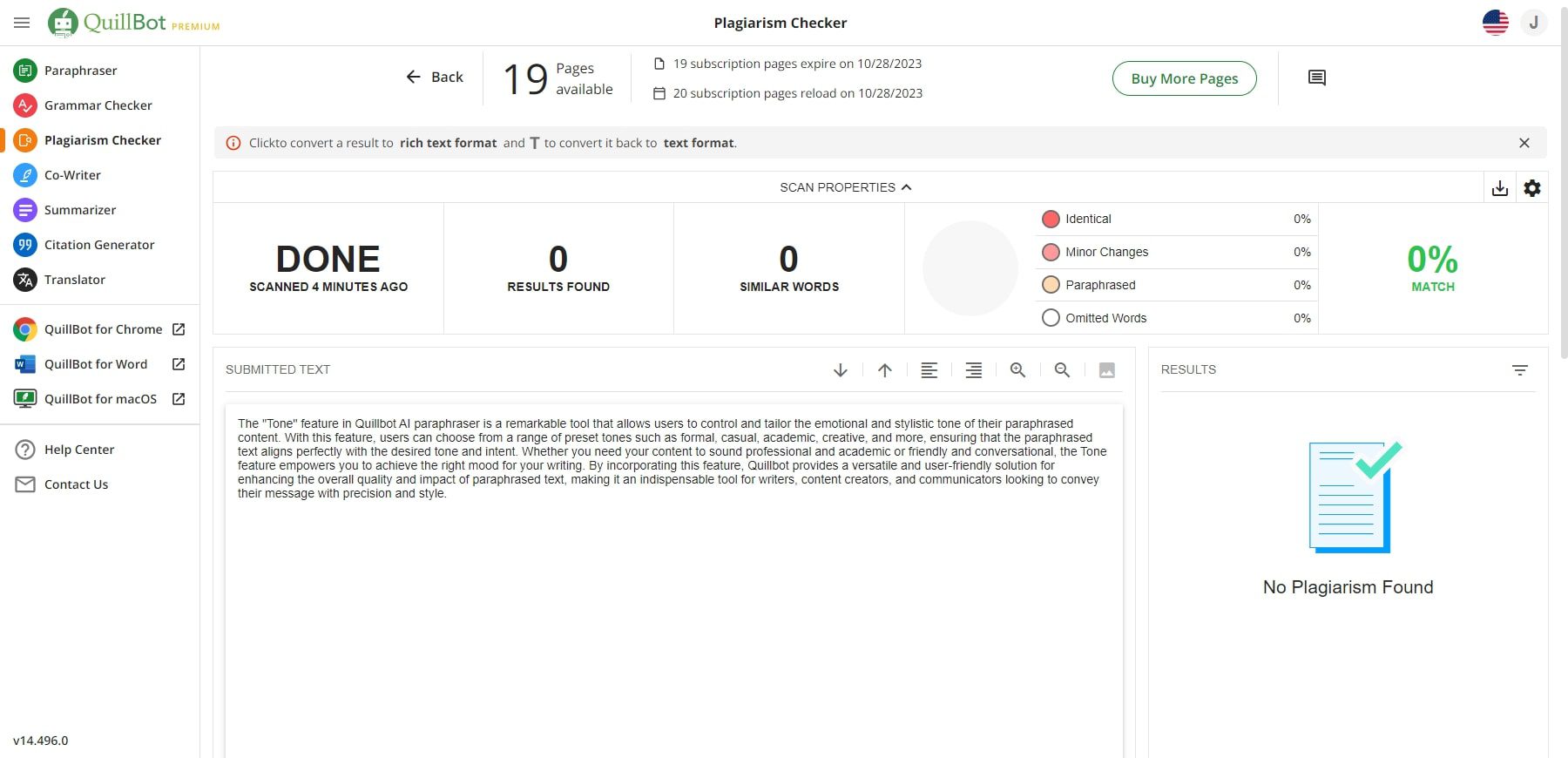
Its plagiarism checker stands out by accommodating research paper plagiarism checks, scanning up to 20 pages (approximately 5000 words) monthly. Consequently, it proves to be a valuable resource for essayists and academic writers, ensuring the integrity of their work.
Plagiarism detection is based on identical words , minor changes , paraphrased words , and omitted words .
6. The Translator
QuillBot AI provides its users with a Translation feature, allowing them to translate text into over 30 languages, making research and writing accessible across language barriers. It offers ad-free translation of up to 5,000 characters at once, includes integrated writing tools, and provides quick and accurate translations. The best part is that it’s free, enhancing convenience and accessibility for writers and researchers.
As a test, I added a block of content in the German language. The translator automatically detected it as German.
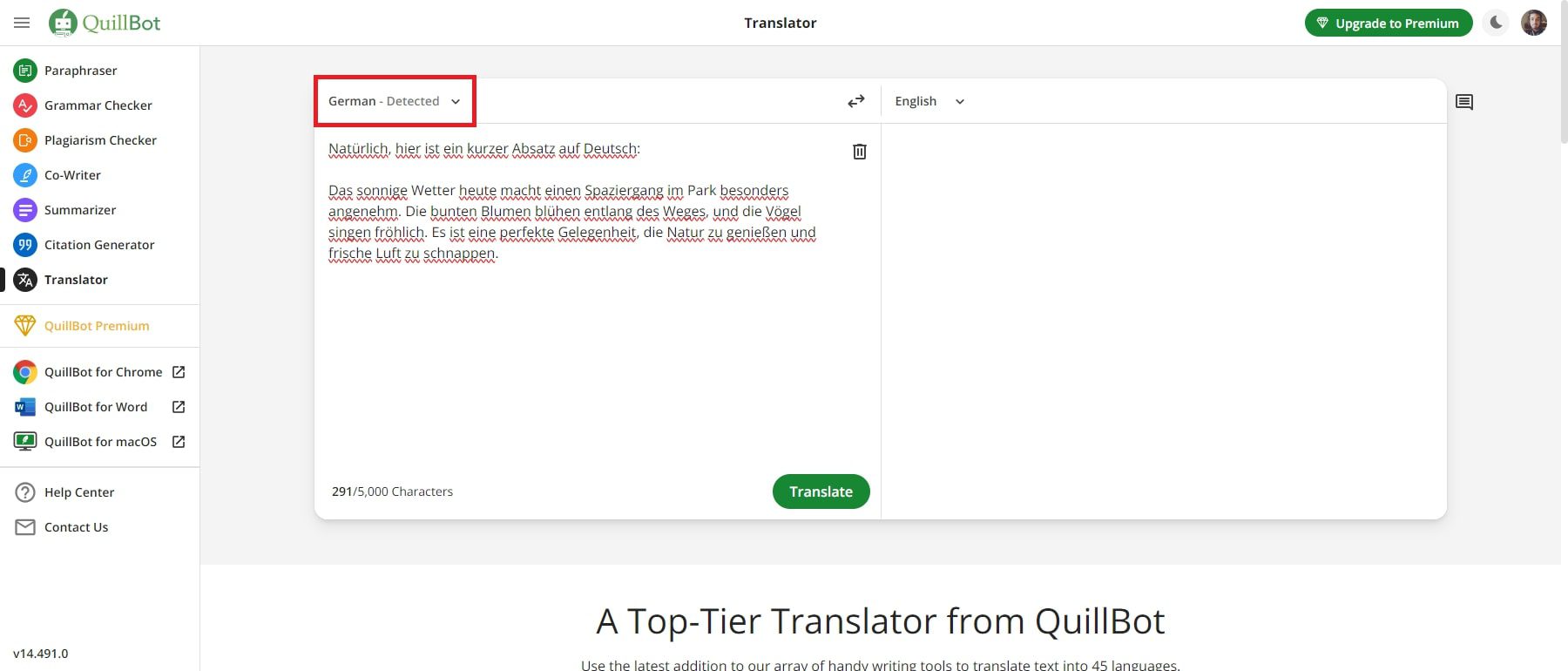
Then all you need to do is select the language you want it translated to on the right and click the Translate button.
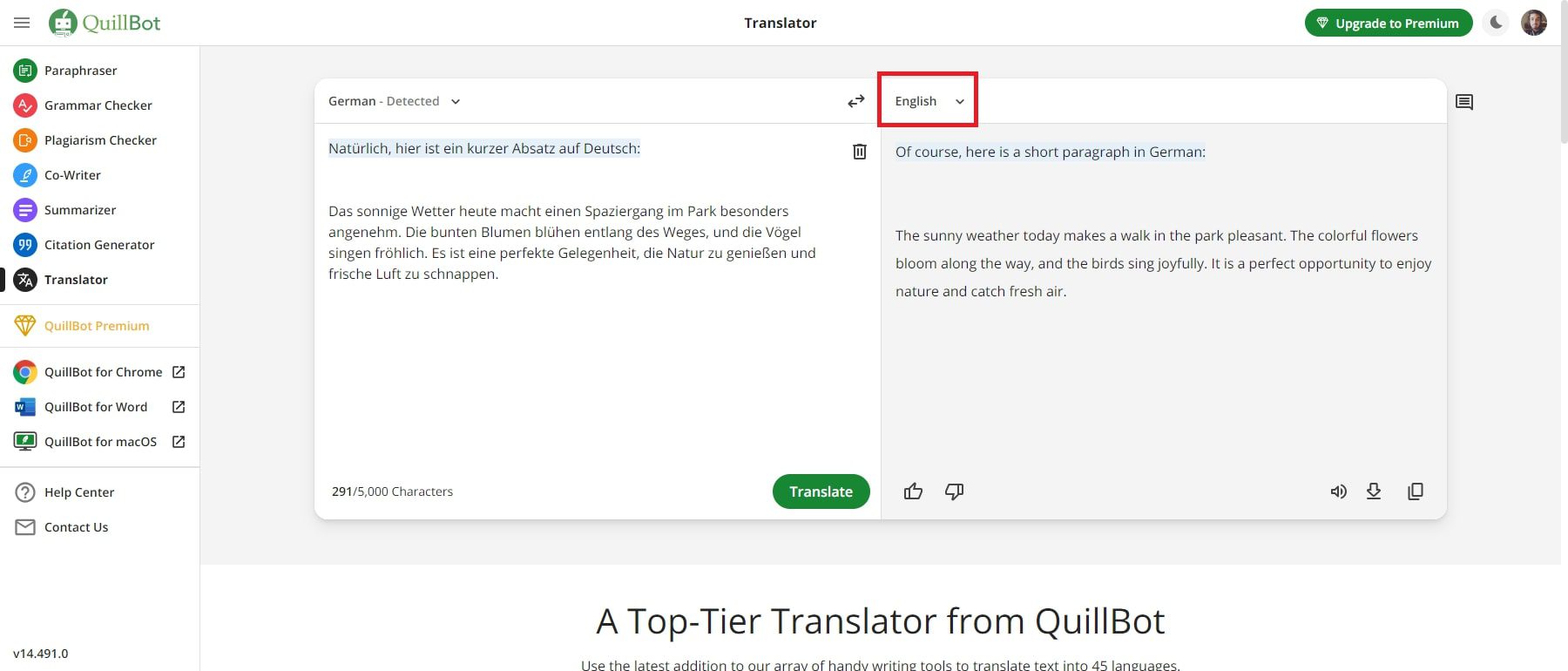
7. Quillbot Extensions
The tool offers three convenient extensions and applications to enhance your writing experience across different platforms.
QuillBot Chrome Extension
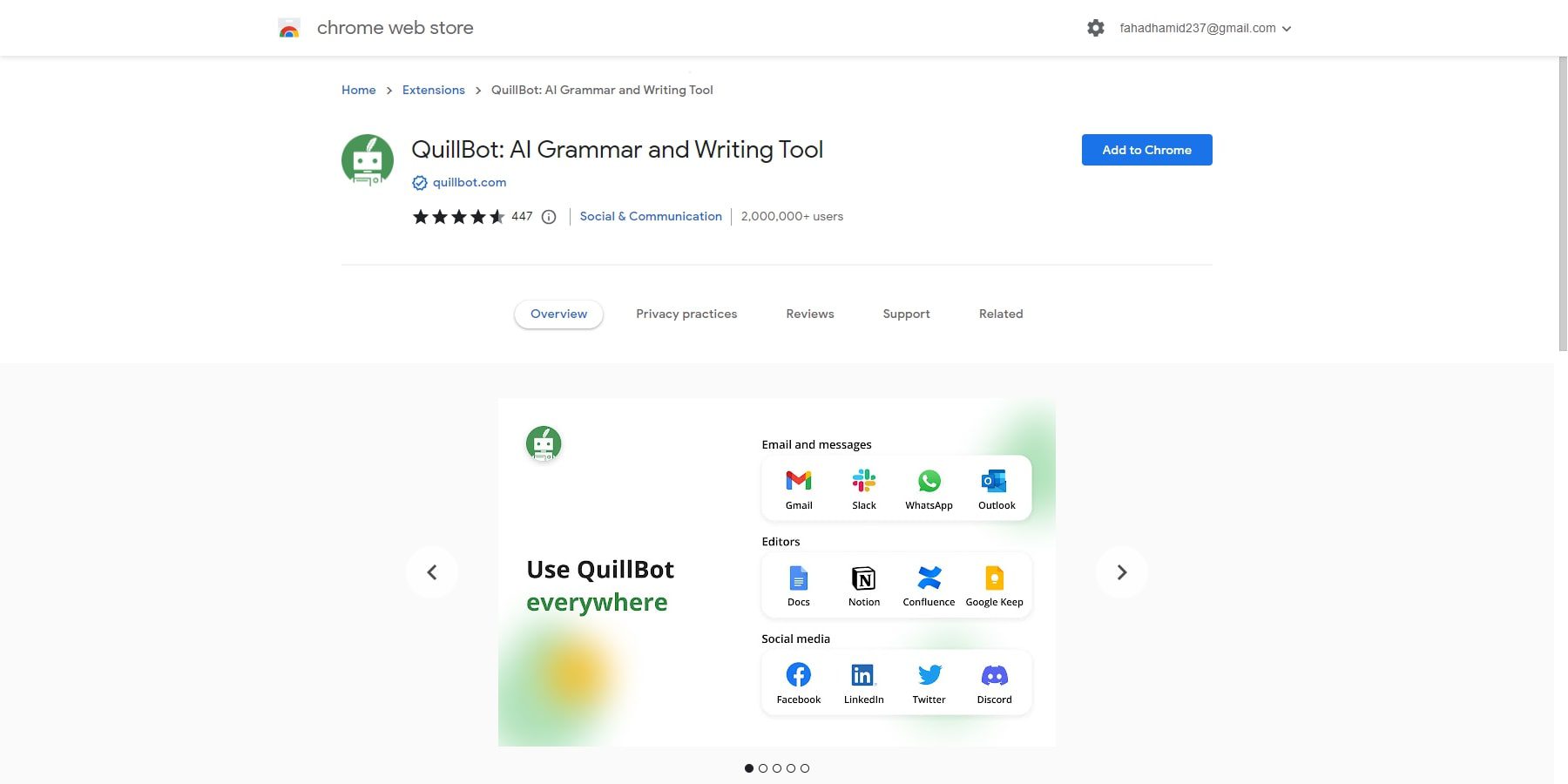
The QuillBot Google Chrome extension is a valuable tool for online writing. It seamlessly integrates with your web browsing, allowing you to check grammar, paraphrase, and summarize online documents (Google Docs), emails, and social media posts. Moreover, it ensures your writing is polished and error-free across the internet.
QuillBot for Word

If you’re working offline in Microsoft Word, this extension empowers you to access the full capabilities of QuillBot. It assists you in crafting high-quality documents, reports, and essays, ensuring your writing is clear and concise, even when you’re not connected to the internet.
QuillBot for macOS
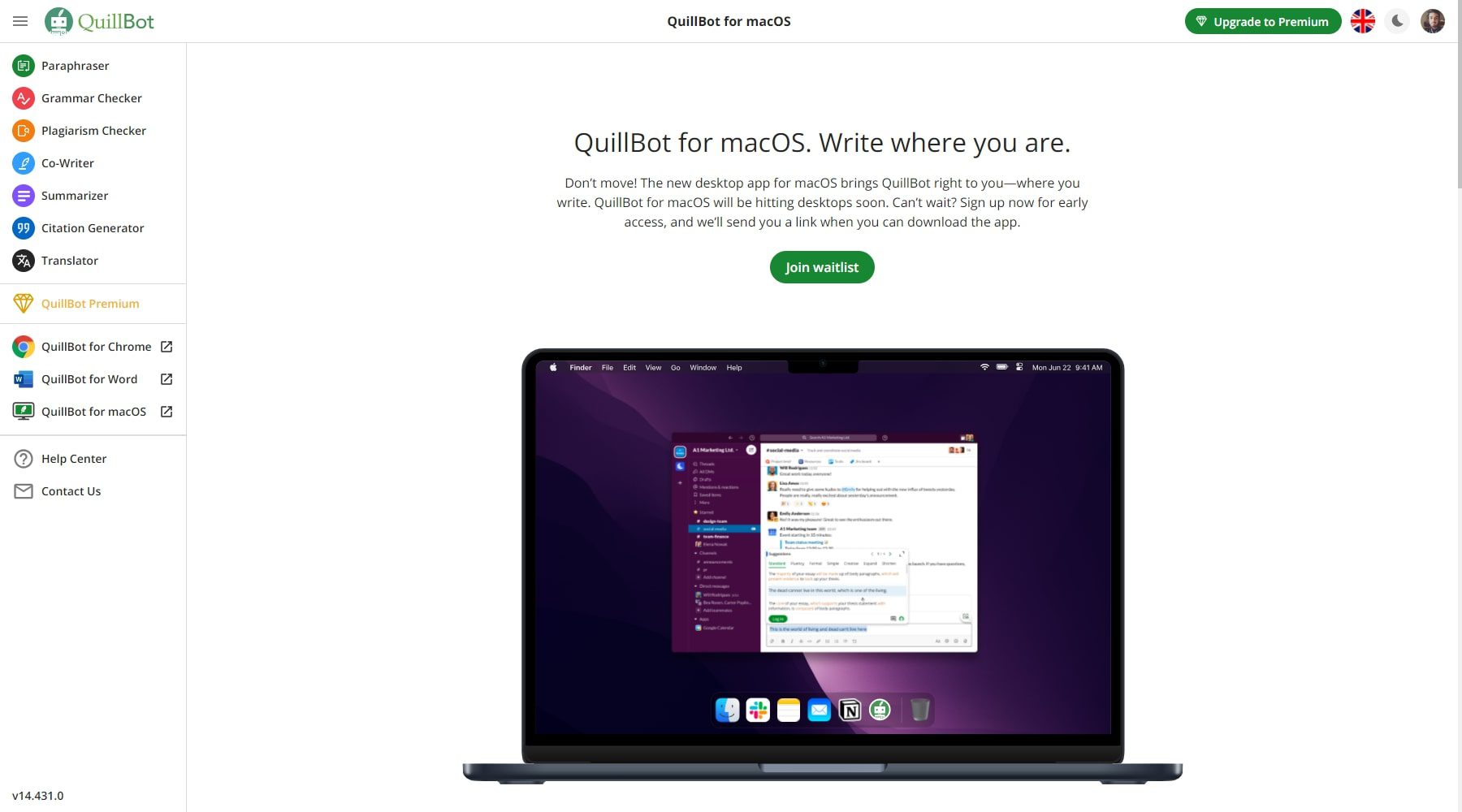
For Mac users, QuillBot offers a browser-free desktop application. This standalone tool simplifies the writing process, providing a smooth and efficient writing experience on your macOS device. Moreover, it’s perfect for those who prefer a dedicated desktop application for their writing needs.
QuillBot AI Pricing and Plans Review
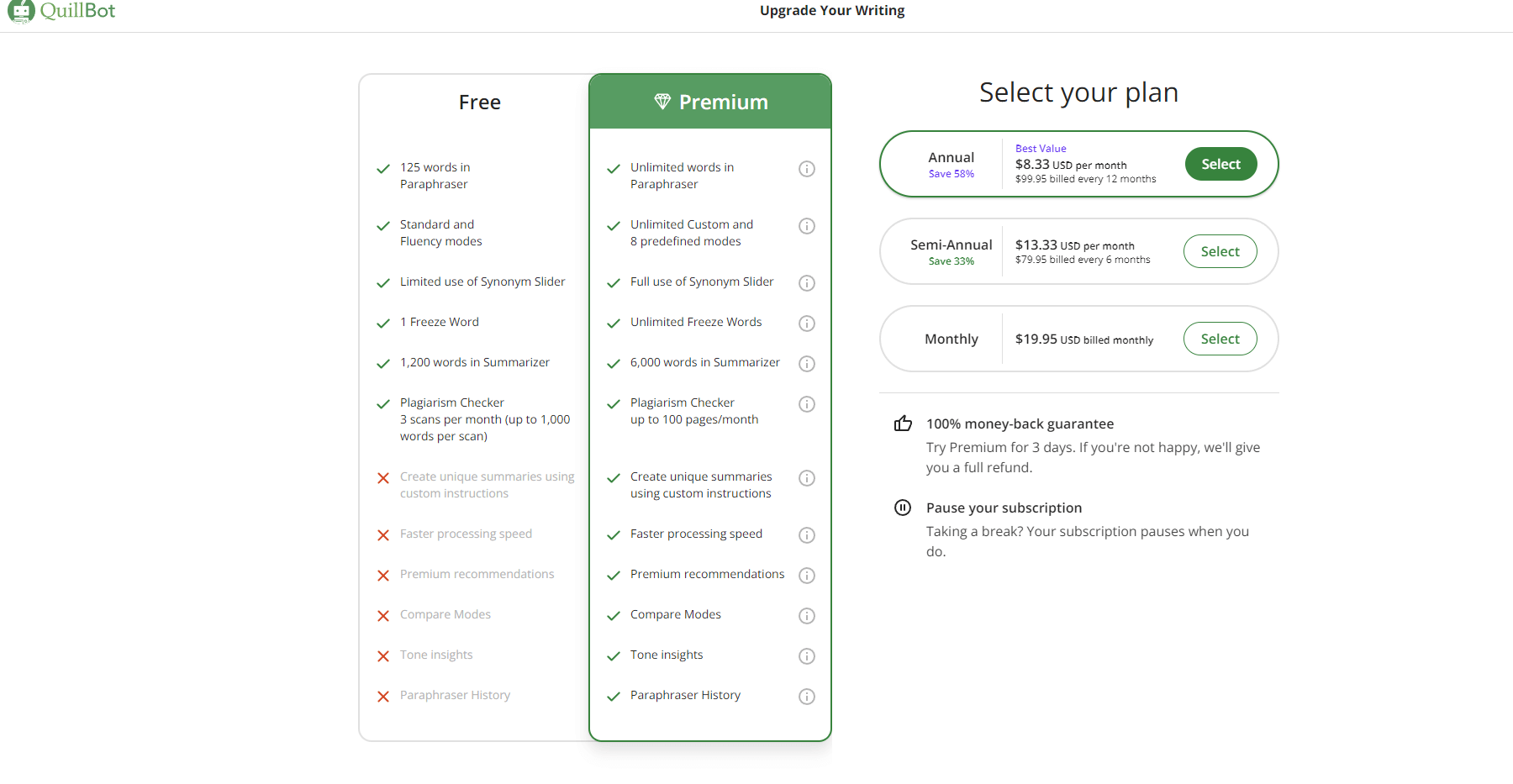
QuillBot AI provides three different pricing options to suit different needs and budgets.
The Basic (Free) Plan allows you to experiment with the tool before attaining its subscription. With it, you can paraphrase 125 words. It provides Standard and Fluency modes with limited use of the Synonym Slider. Moreover, you can summarize up to 1,200 words through the Summarizer mode.
The premium version of QuillBot AI allows unlimited words for the Parphraser, more writing style modes, and up to 6,000 words in the Summarizer. It also provides access to Plagiarism Checker, Paraphraser History, and Compare Modes.
You have the choice of three different payment plans for premium. The Annual Plan costs $8.33 monthly, with $99.95 billed every 12 months. The Semi-Annual Plan costs $13.33 monthly, with $79.95 billed every six months. The Monthly Plan costs $19.95 per month. By subscribing to either of these premium subscriptions, you can paraphrase unlimited words in Paraphraser. The Summarizer will allow you to summarize up to 6,000 words, and you can fully use the Synonym Slider.
Pros and Cons of QuillBot AI
As we delve deeper into our comprehensive review of QuillBot AI, it becomes imperative to assess the advantages and disadvantages of this sophisticated language processing tool. While this tool boasts various features and capabilities, no technology is without its strengths and weaknesses.
Pros of Using QuillBot AI
- A free plan is available, and there’s no need to sign up.
- There is a refund policy in place.
- Extensions for Microsoft Word, Google Chrome, and macOS are readily available.
- You can access a free Language Translator.
- The option to upgrade makes it very affordable to access additional features.
- An app for content summarization is available for free.
- Additionally, there is a free Grammar Checker app provided.
Cons of Using QuillBot AI
- Only two writing modes are available for free.
- OpenAI GPT AI writing is unavailable.
- There is no AI content detection feature.
- Manual intervention is usually required.
- Both free and paid plans have character limitations in place
How QuillBot Compares to Other Similar Tools
QuillBot AI offers valuable features for text enhancement, including effective paraphrasing and translation. Its free plan is a budget-friendly option, making it accessible to a broad audience. When compared to Grammarly , QuillBot outshines Grammarly’s ability to rephrase content. However, Quillbot’s grammar-checking capabilities fall short of Grammarly’s robust editing features.
Tools like Copy.ai and Rytr AI may offer more comprehensive solutions for advanced AI content generation than QuillBot. These alternatives excel in generating content from scratch, making them suitable for various writing needs.
Regarding accessibility, QuillBot stands out with extensions for Microsoft Word, Google Chrome, and macOS. This enhances its usability and integration into daily writing tasks. It also eliminates the language barrier, whereas Grammarly, Copy.ai, and Rytr AI primarily focus on English.
Ultimately, choosing these tools depends on your specific requirements and budget. QuillBot is a reliable option for text enhancement, while other tools may be better suited for advanced AI content generation and comprehensive grammar checking.
Should You Use QuillBot? (The Verdict)
QuillBot AI offers undeniable value as an AI writing assistant for various teams and individuals. Need an alternative version of your original article? QuillBot can generate a new and improved version swiftly. It is handy for optimizing blog posts and other content, outperforming many free and paid AI rewriter tools . Its ability to paraphrase content significantly reduces plagiarism risks for academic assignments and research papers. Although some detectors, like Originality.ai , may still recognize QuillBot paraphrased content in some cases. No AI content generator is 100% human. That said, thanks to its versatility and proficiency, QuillBot is a worthwhile asset for writers, students, and content creators.
Looking for more? Check out our list of top AI writing tools . And for all aspiring writers, check out these AI story generators . You can also explore more of the best overall AI tools you can use to boost your productivity in various ways .
Frequently Asked Questions (FAQs)
Here are some common questions that may help you decide if QuillBot is right for you.
What is QuillBot?
Can quillbot be detected, how much does quillbot premium cost, how can quillbot be used as a paraphrasing tool, how can quillbot be used as a summarizer.

Get Started With QuillBot AI!
Explore plans, pricing and features. Click here to get started. 👇
Explore plans, pricing and features here. 👇
By fahad hamid.
Fahad enjoys writing about a diverse range of topics, from business and marketing to design. Alongside this, he balances his love for tennis, showing skill both on the page and on the court.
Explore Divi, The Most Popular WordPress Theme In The World And The Ultimate Page Builder

Check Out These Related Posts
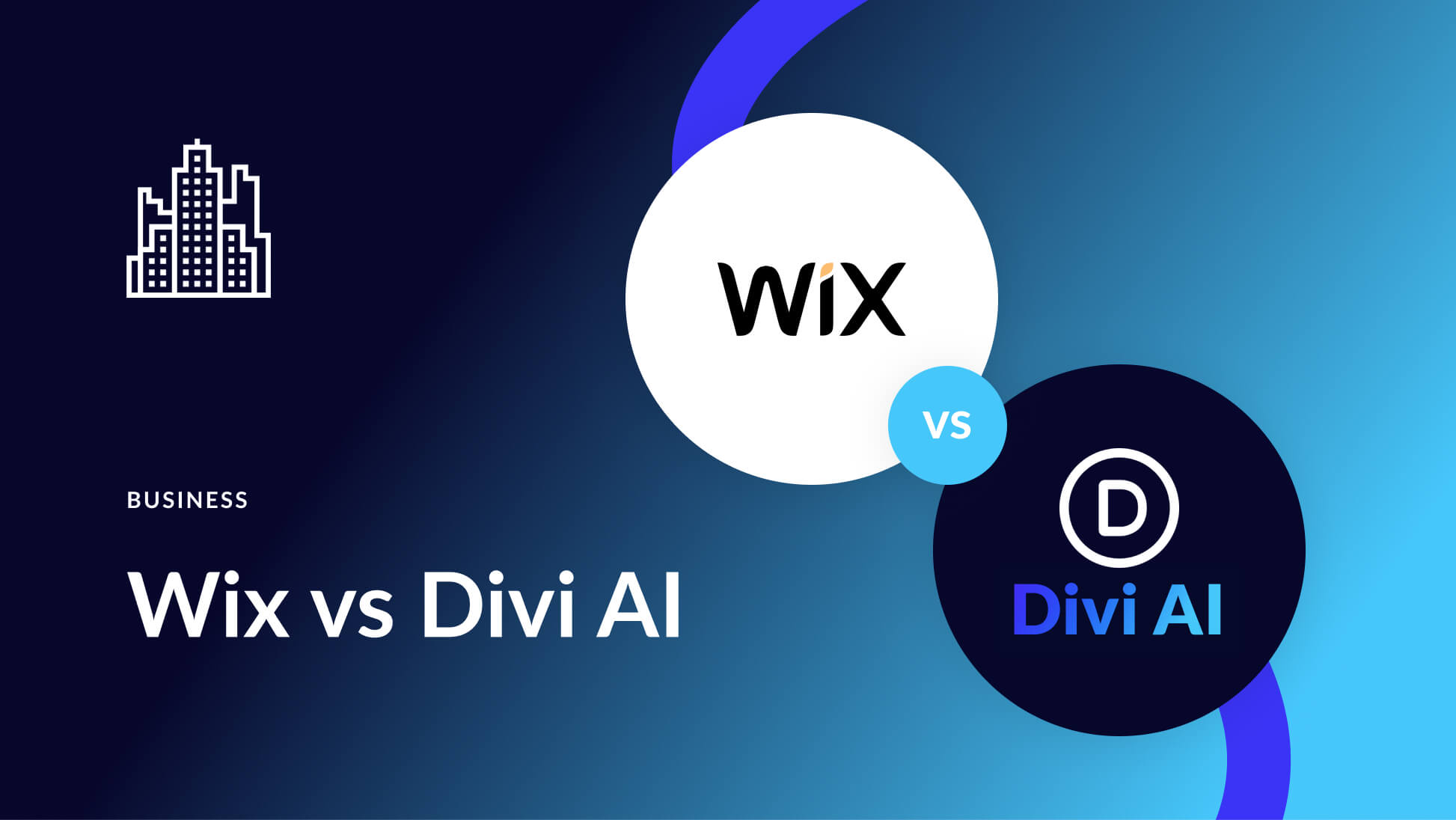
- Wix vs Divi AI: Which AI Website Builder to Choose in 2024?
Posted on June 5, 2024 in Business
Are you tired of AI website builders that don’t deliver? Are you looking for AI features that actually work? In this post, we will discuss two of the best and most popular AI site builders available: Wix (the AI website builder) and Divi (the AI-powered WordPress theme). Both can build...

How to Make a Small Business Website with WordPress in 2024
Updated on June 4, 2024 in Business
Building a brand new website for your business is an excellent step to creating a digital footprint. Modern websites do more than show information—they capture people into your sales funnel, drive sales, and can be effective assets for ongoing marketing. Luckily, WordPress offers flexibility,...

Shopify vs Etsy: Which One’s Better for eCommerce? (2024)
Posted on May 28, 2024 in Business
Have you ever dreamed of selling your crafts online? Two popular platforms, Shopify and Etsy, have the potential to turn those dreams into reality. But which one is right for you? Buckle up because we’re diving into Shopify vs. Etsy to see which fits your unique business goals! Let’s...
Where did you get that annual price? I would love to get it. When I visited the site the price was twice as much ($99.95) if I paid the full year in advance.
Hi, Carlos. The pricing must have changed since writing the post. I have updated the article. Thanks for bringing it to our attention.
Carlos – for me, it’s showing as: USD Annual Save 58% $4.17 USD per month $49.95 billed every 12 months
Leave A Reply Cancel reply
- Recent Posts
- Download a Free Spa Theme Builder Pack for Divi
- WordPress Pricing: How Much Does WordPress Cost? (2024)
- How to Get Started with WordPress (2024 Guide)
- Get a Free Psychology Layout Pack For Divi
- Divi Resources
- Theme Releases
- Tips & Tricks
974,872 Customers Are Already Building Amazing Websites With Divi. Join The Most Empowered WordPress Community On The Web
We offer a 30 Day Money Back Guarantee, so joining is Risk-Free!
Divi Features
- All Features Explore Divi
- Divi Modules
- Divi Layouts
- No-Code Builder
- Ecommerce Websites
- Theme Builder
- Marketing Platform
- Speed & Performance
- Premium Support
- Divi Marketplace
- Divi AI Brand New!
- Divi Hosting
- Extra Theme
- Bloom Plugin
- Monarch Plugin
- Plans & Pricing Get Divi Today
- Documentation
- Help Articles & FAQ
- 24/7 Support
- Developer Docs
- System Status
- Product Updates
- Best Plugins
- Best Hosting
- Divi Meetups
- Divi Facebook Group
- Divi Examples
- Divi Integrations
- Divi Reviews
- Community Forum
- Affiliate Program
- Terms of Service
- Privacy Policy
Copyright © 2024 Elegant Themes ®
- Original article
- Open access
- Published: 01 September 2023
Evaluating the efficacy of AI content detection tools in differentiating between human and AI-generated text
- Ahmed M. Elkhatat ORCID: orcid.org/0000-0003-0383-939X 1 ,
- Khaled Elsaid 2 &
- Saeed Almeer 3
International Journal for Educational Integrity volume 19 , Article number: 17 ( 2023 ) Cite this article
43k Accesses
27 Citations
80 Altmetric
Metrics details
The proliferation of artificial intelligence (AI)-generated content, particularly from models like ChatGPT, presents potential challenges to academic integrity and raises concerns about plagiarism. This study investigates the capabilities of various AI content detection tools in discerning human and AI-authored content. Fifteen paragraphs each from ChatGPT Models 3.5 and 4 on the topic of cooling towers in the engineering process and five human-witten control responses were generated for evaluation. AI content detection tools developed by OpenAI, Writer, Copyleaks, GPTZero, and CrossPlag were used to evaluate these paragraphs. Findings reveal that the AI detection tools were more accurate in identifying content generated by GPT 3.5 than GPT 4. However, when applied to human-written control responses, the tools exhibited inconsistencies, producing false positives and uncertain classifications. This study underscores the need for further development and refinement of AI content detection tools as AI-generated content becomes more sophisticated and harder to distinguish from human-written text.
Introduction
The instances of academic plagiarism have escalated in educational settings, as it has been identified in various student work, encompassing reports, assignments, projects, and beyond. Academic plagiarism can be defined as the act of employing ideas, content, or structures without providing sufficient attribution to the source (Fishman 2009 ). Students' plagiarism strategies differ, with the most egregious instances involving outright replication of source materials. Other approaches include partial rephrasing through modifications in grammatical structures, substituting words with their synonyms, and using online paraphrasing services to reword text (Elkhatat 2023 ; Meuschke & Gipp 2013 ; Sakamoto & Tsuda 2019 ). Academic plagiarism violates ethical principles and ranks among the most severe cases of misconduct, as it jeopardizes the acquisition and assessment of competencies. As a result, implementing strategies to reduce plagiarism is vital for preserving academic integrity and preventing such dishonest practices in students' future scholarly and professional endeavors (Alsallal et al. 2013 ; Elkhatat 2022 ; Foltýnek et al. 2020 ). Text-Matching Software Products (TMSPs) are powerful instruments that educational institutions utilize to detect specific sets of plagiarism, attributed to their sophisticated text-matching algorithms and extensive databases containing web pages, journal articles, periodicals, and other publications. Certain TMSPs also enhance their efficacy in identifying plagiarism by incorporating databases that index previously submitted student papers (Elkhatat et al. 2021 ).
Recently, Artificial Intelligence (AI)-driven ChatGPT has surfaced as a tool that aids students in creating tailored content based on prompts by employing natural language processing (NLP) techniques (Radford et al. 2018 ). The initial GPT model showcased the potential of combining unsupervised pre-training with supervised fine-tuning for a broad array of NLP tasks. Following this, OpenAI introduced ChatGPT (model 2), which enhanced the model's performance by enlarging the architecture and using a more comprehensive pre-training dataset (Radford et al. 2019 ). The subsequent launch of ChatGPT (models 3 and 3.5) represented a significant advancement in ChatGPT's development, as it exhibited exceptional proficiency in producing human-like text and attained top results on various NLP benchmark lines. This model's capacity to generate contextually appropriate and coherent text in response to user prompts made it suitable for release of ChatGPT, an AI-driven chatbot aimed at helping users produce text and participate in natural language dialogues(Brown et al. 2020 ; OpenAI 2022 ).
The recently unveiled ChatGPT (model 4) by OpenAI on March 14, 2023, is a significant milestone in NLP technology. With enhanced cybersecurity safety measures and superior response quality, it surpasses its predecessors in tackling complex challenges. ChatGPT (model 4) boasts a wealth of general knowledge and problem-solving skills, enabling it to manage demanding tasks with heightened precision. Moreover, its inventive and cooperative features aid in generating, editing, and iterating various creative and technical writing projects, such as song composition, screenplay development, and personal writing style adaptation. However, it is crucial to acknowledge that ChatGPT (model 4)'s knowledge is confined to the cutoff date of September 2021 (OpenAI 2023 ), although the recently embedded plugins allow it to access current website content.
This development presents potential risks concerning cheating and plagiarism, which may result in severe academic and legal ramifications (Foltýnek et al. 2019 ). These potentially elevated risks of cheating and plagiarism include but are not limited to the Ease of Access to Information with its extensive knowledge base and ability to generate coherent and contextually relevant responses. In addition, the Adaptation to Personal Writing Style allows for generating content that closely matches a student's writing, making it even more difficult for educators to identify whether a language model has generated the work(OpenAI 2023 ).
Academic misconduct in undergraduate education using ChatGPT has been widely studied (Crawford et al. 2023 ; King & chatGpt 2023 ; Lee 2023 ; Perkins 2023 ; Sullivan; et al. 2023 ). Despite the advantages of ChatGPT for supporting students in essay composition and other scholarly tasks, questions have been raised regarding the authenticity and suitability of the content generated by the chatbot for academic purposes (King & chatGpt 2023 ). Additionally, ChatGPT has been rightly criticized for generating incoherent or erroneous content (Gao et al. 2022 ; Qadir 2022 ), providing superficial information (Frye 2022 ), and having a restricted knowledge base due to its lack of internet access and dependence on data up until September 2021 (Williams 2022 ). Nonetheless, the repeatability (repeatedly generated responses within the same chatbot prompt) and reproducibility (repeatedly generated responses with a new chatbot prompt)of authenticity capabilities in GPT-3.5 and GPT-4 were examined by text-matching software, demonstrating that the generation of responses remains consistently elevated and coherent, predominantly proving challenging to detect by conventional text-matching tools (Elkhatat 2023 ).
Recently, Open AI classifier tools have become relied upon for distinguishing between human writing and AI-generated content, ensuring text authenticity across various applications. For instance, OpenAI, which developed ChatGPT, introduced an AI text classifier that assists users in determining whether an essay was authored by a human or generated by AI. This classifier categorizes documents into five levels based on the likelihood of being AI-generated: very unlikely, unlikely, unclear, possibly, and likely AI-generated. The OpenOpen AI classifier has been trained using a diverse range of human-written texts, although the training data does not encompass every type of human-written text. Furthermore, the developers' tests reveal that the classifier accurately identifies 26% of AI-written text (true positives) as "likely AI-generated" while incorrectly labeling 9% of the human-written text (false positives) as AI-generated (Kirchner et al. 2023 ). Hence, OpenAI advises users to treat the classifier's results as supplementary information rather than relying on them exclusively for determining AI-generated content (Kirchner et al. 2023 ). Other AI text classifier tools include Writer.com's AI content detector, which offers a limited application programming interface API-based solution for detecting AI-generated content and emphasizes its suitability for content marketing. Copyleaks, an AI content detection solution, claims a 99% accuracy rate and provides integration with many Learning Management Systems (LMS) and APIs. GPTZero, developed by Edward Tian, is an Open AI classifier tool targeting educational institutions to combat AI plagiarism by detecting AI-generated text in student assignments. Lastly, CrossPlag's AI content detector employs machine learning algorithms and natural language processing techniques to precisely predict a text's origin, drawing on patterns and characteristics identified from an extensive human and AI-generated content dataset.
The development and implementation of AI content detectors and classifier tools underscore the growing importance and need to differentiate between human-written and AI-generated content across various fields, such as education and content marketing. To date, no studies have comprehensively examined the abilities of these AI content detectors and classifiers to distinguish between human and AI-generated content. The present study aims to investigate the capabilities of several recently launched AI content detectors and classifier tools in discerning human-written and AI-generated content.
Methodology
The ChatGPT chatbot generated two 15-paragraph responses on "Application of Cooling Towers in the Engineering Process." The first set was generated using ChatGPT's Model 3.5, while the second set was created using Model 4. The initial prompt was to "write around 100 words on the application of cooling towers in the engineering process." Five human-written samples were incorporated as control samples to evaluate false positive responses by AI detectors, as detailed in Table 1 . These samples were chosen from the introduction sections of five distinct lab reports penned by undergraduate chemical engineering students. The reports were submitted and evaluated in 2018, a planned selection to ensure no interference from AI tools available at that time.
Five AI text content detectors, namely OpenAI, Writer, Copyleaks, GPTZero, and CrossPlag, were selected and evaluated for their ability to differentiate between human and AI-generated content. These AI detectors were selected based on extensive online research and valuable feedback from individual educators at the time of the study. It is important to note that this landscape is continually evolving, with new tools and websites expected to be launched shortly. Some tools, like the Turnitin AI detector, have already been introduced but are yet to be widely adopted or activated across educational institutions. In addition, the file must have at least 300 words of prose text in a long-form writing format (Turnitin 2023 ).
It is important to note that different AI content detection tools display their results in distinct representations, as summarized in Table 2 . To standardize the results across all detection tools, we normalized them according to the OpenAI theme. This normalization was based on the AI content percentage. Texts with less than 20% AI content were classified as "very unlikely AI-generated," those with 20–40% AI content were considered "unlikely AI-generated," those with 40–60% AI content were deemed "unclear if AI-generated," those with 60–80% AI content were labeled "possibly AI-generated." Those with over 80% AI content were categorized as "likely AI-generated." Statistical analysis and capabilities tests were conducted using Minitab (Minitab 2023 ).
The diagnostic accuracy of AI detector responses was classified into positive, negative, false positive, false negative, and uncertain based on the original content's nature (AI-generated or human-written). The AI detector responses were classified as positive if the original content was AI-generated and the detector output was "Likely AI-generated" or, more inclusively, "Possibly AI-generated." Negative responses arise when the original content is human-generated, and the detector output is "Very unlikely AI-generated" or, more inclusively, "Unlikely AI-generated." False positive responses occur when the original content is human-generated, and the detector output is "Likely AI-generated" or "Possibly AI-generated." In contrast, false negative responses emerge when the original content is AI-generated, and the detector output is "Very unlikely AI-generated" or "Unlikely AI-generated." Finally, uncertain responses are those where the detector output is "Unclear if it is AI-generated," regardless of whether the original content is AI-generated or human-generated. This classification scheme assumes that "Possibly AI-generated" and "Unlikely AI-generated" responses could be considered borderline cases, falling into either positive/negative or false positive/false negative categories based on the desired level of inclusivity or strictness in the classification process.
This study evaluated these five detectors, OpenAI, Writer, Copyleaks, GPTZero, and CrossPlag, focusing on their Specificity, Sensitivity, Positive Predictive Value (PPV), and Negative Predictive Value (NPV). These metrics are used in biostatistics and machine learning to evaluate the performance of binary classification tests. Sensitivity (True Positive Rate) is the proportion of actual positive cases which are correctly identified. In this context, sensitivity is defined as the proportion of AI-generated content correctly identified by the detectors out of all AI-generated content. It is calculated as the ratio of true positives (AI-generated content correctly identified) to the sum of true positives and false negatives (AI-generated content incorrectly identified as human-generated) (Nelson et al. 2001 ; Nhu et al. 2020 ).
On the other hand, Specificity (True Negative Rate) is the proportion of actual negative cases which are correctly identified. In this context, it refers to the proportion of human-generated content correctly identified by the detectors out of all actual human-generated content. It is computed as the ratio of true negatives (human-generated content correctly identified) to the sum of true negatives and false positives (human-generated content incorrectly identified as AI-generated) (Nelson et al. 2001 ; Nhu et al. 2020 ).
Predictive power, a vital determinant of the detectors' efficacy, is divided into positive predictive value (PPV) and negative predictive value (NPV). Positive Predictive Value (PPV) is the proportion of positive results in statistics and diagnostic tests that are actually positive results. In this context, it is the proportion of actual AI-generated content among all content identified as AI-generated by the detectors. It is calculated as the ratio of true positives to the sum of true and false positives. Conversely, Negative Predictive Value (NPV) is the proportion of negative results in statistics and diagnostic tests that are accurate negative results.in this context, it is the proportion of actual human-generated content among all content identified as human-generated by the detectors. It is calculated as the ratio of true negatives to the sum of true and false negatives (Nelson et al. 2001 ; Nhu et al. 2020 ). These metrics provide a robust framework for evaluating the performance of AI text content detectors; collectively, they can be called "Classification Performance Metrics" or "Binary Classification Metrics."
Table 3 outlines the outcomes of AI content detection tools implemented on 15 paragraphs generated by ChatGPT Model 3.5, 15 more from ChatGPT Model 4, and five control paragraphs penned by humans. It is important to emphasize that, as stated in the methodology section and detailed in Table 2 , different AI content detection tools display their results in distinct representations. For instance, GPTZERO classifies the content into two groups: AI-Generated or Human-Generated content. In contrast, the OpenOpen AI classifier divides the content into a quintuple classification system: Likely AI-Generated, Possibly AI-Generated, Unclear if it is AI-Generated, Unlikely AI-Generated, and Very Unlikely AI-Generated. Notably, both GPTZERO and the OpenOpen AI classifier do not disclose the specific proportions of AI or human contribution within the content. In contrast, other AI detectors provide percentages detailing the AI or human contribution in the submitted text. Therefore, to standardize the responses from all AI detectors, the percentage data were normalized to fit the five-tier classification system of the OpenOpen AI classifier, where each category represents a 20% increment. The table also includes the exact percentage representation of AI contribution within each category for enhanced clarity and specificity.
Table 4 , on the other hand, demonstrates the diagnostic accuracy of these AI detection tools in differentiating between AI-generated and human-written content. The results for GPT 3.5-generated content indicate a high degree of consistency among the tools. The AI-generated content was often correctly identified as "Likely AI-Generated." However, there were a few instances where the tools provided an uncertain or false-negative classification. GPT 3.5_7 and GPT 3.5_14 received "Very unlikely AI-Generated" ratings from GPTZERO, while WRITER classified GPT 3.5_9 and GPT 3.5_14 as "Unclear if AI-Generated." Despite these discrepancies, most GPT 3.5-generated content was correctly identified as AI-generated by all tools.
The performance of the tools on GPT 4-generated content was notably less consistent. While some AI-generated content was correctly identified, there were several false negatives and uncertain classifications. For example, GPT 4_1, GPT 4_3, and GPT 4_4 received "Very unlikely AI-Generated" ratings from WRITER, CROSSPLAG, and GPTZERO. Furthermore, GPT 4_13 was classified as "Very unlikely AI-Generated" by WRITER and CROSSPLAG, while GPTZERO labeled it as "Unclear if it is AI-Generated." Overall, the tools struggled more with accurately identifying GPT 4-generated content than GPT 3.5-generated content.
When analyzing the control responses, it is evident that the tools' performance was not entirely reliable. While some human-written content was correctly classified as "Very unlikely AI-Generated" or "Unlikely AI-Generated," there were false positives and uncertain classifications. For example, WRITER ranked Human 1 and 2 as "Likely AI-Generated," while GPTZERO provided a "Likely AI-Generated" classification for Human 2. Additionally, Human 5 received an "Uncertain" classification from WRITER.
In order to effectively illustrate the distribution of discrete variables, the Tally Individual Variables function in Minitab was employed. This method facilitated the visualization of varying categories or outcomes' frequencies, thereby providing valuable insights into the inherent patterns within the dataset. To further enhance comprehension, the outcomes of the Tally analysis were depicted using bar charts, as demonstrated in Figs. 1 , 2 , 3 , 4 , 5 and 6 . Moreover, the classification performance metrics of these five AI text content are demonstrated in Fig. 7 , indicating a varied performance across different metrics. Looking at the GPT 3.5 results, the OpenAI Classifier displayed the highest sensitivity, with a score of 100%, implying that it correctly identified all AI-generated content. However, its specificity and NPV were the lowest, at 0%, indicating a limitation in correctly identifying human-generated content and giving pessimistic predictions when it was genuinely human-generated. GPTZero exhibited a balanced performance, with a sensitivity of 93% and specificity of 80%, while Writer and Copyleaks struggled with sensitivity. The results for GPT 4 were generally lower, with Copyleaks having the highest sensitivity, 93%, and CrossPlag maintaining 100% specificity. The OpenAI Classifier demonstrated substantial sensitivity and NPV but no specificity.

The responses of five AI text content detectors for GPT-3.5 generated contents
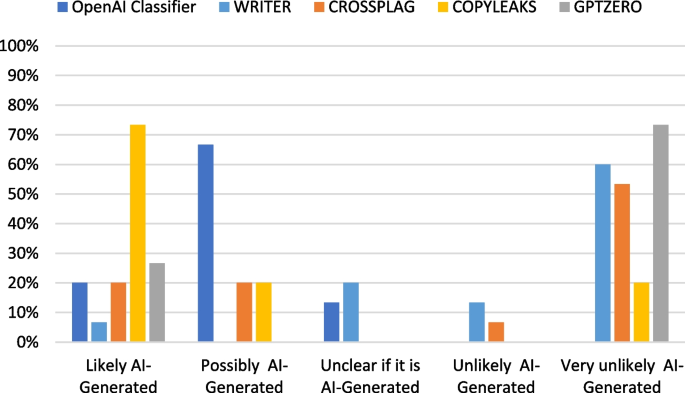
The diagnostic accuracy of the AI text content detectors' responses for GPT-3.5 generated contents
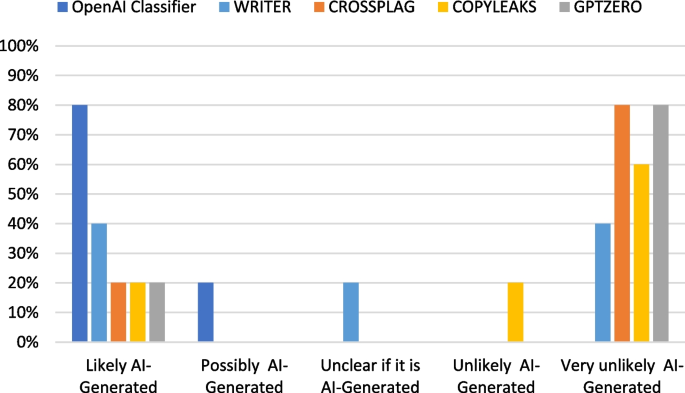
The responses of five AI text content detectors for GPT-4 generated contents
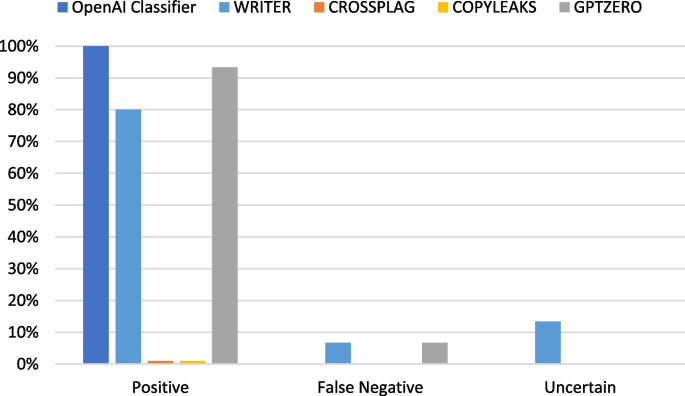
The diagnostic accuracy of the AI text content detectors' responses for GPT-4 generated contents
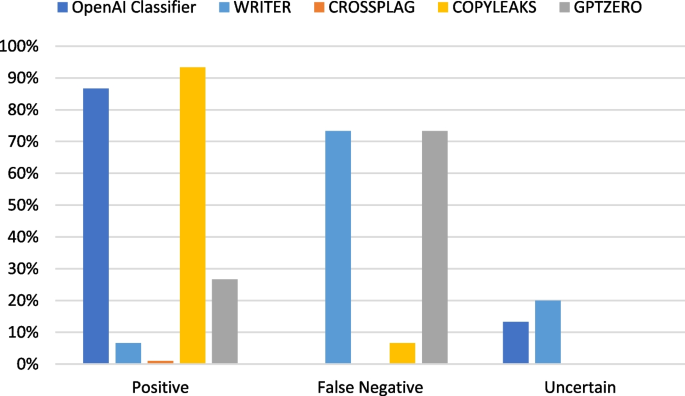
The responses of five AI text content detectors for human-written contents
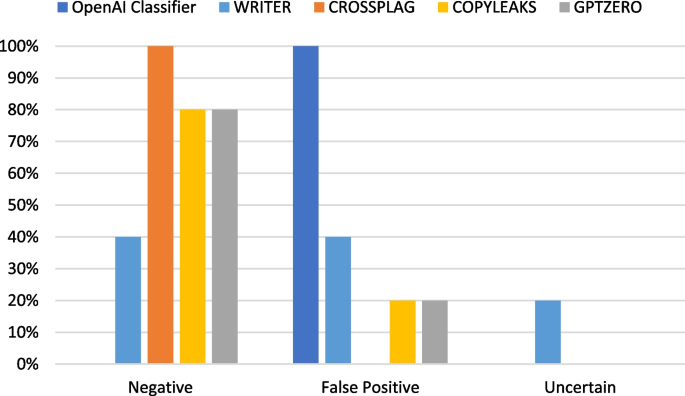
The diagnostic accuracy of the AI text content detectors' responses for the human-written contents
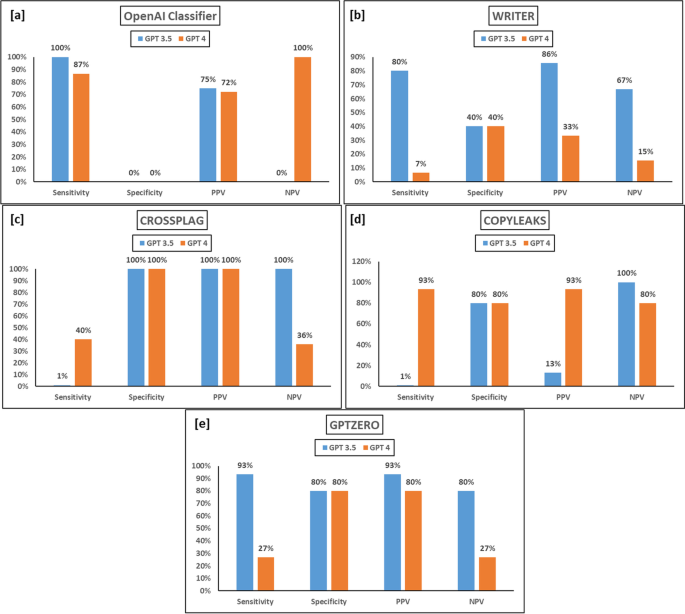
The Classification Performance Metrics of (a) OpenAI Classifier, (b) WRITER, (c) CROSSPLAG, (d) COPYLEAKS, and (e) GPTZERO
The analysis focuses on the performance of five AI text content detectors developed by OpenAI, Writer, Copyleaks, GPTZero, and CrossPlag corporations. These tools were utilized to evaluate the generated content and determine the effectiveness of each detector in correctly identifying and categorizing the text as either AI-generated or human-written. The results indicate a variance in the performance of these tools across GPT 3.5, GPT 4, and human-generated content. While the tools were generally more successful in identifying GPT 3.5-generated content, they struggled with GPT 4-generated content and exhibited inconsistencies when analyzing human-written control responses. The varying degrees of performance across these AI text content detectors highlight the complexities and challenges associated with differentiating between human and AI-generated content.
The OpenAI Classifier's high sensitivity but low specificity in both GPT versions suggest that it is efficient at identifying AI-generated content but might struggle to identify human-generated content accurately. CrossPlag's high specificity indicates its ability to identify human-generated content correctly but struggles to identify AI-generated content, especially in the GPT 4 version. These findings raise questions about its effectiveness in the rapidly advancing AI landscape.
The differences between the GPT 3.5 and GPT 4 results underline the evolving challenge of AI-generated content detection, suggesting that detector performance can significantly vary depending on the AI model's sophistication. These findings have significant implications for plagiarism detection, highlighting the need for ongoing advancements in detection tools to keep pace with evolving AI text generation capabilities.
Notably, the study's findings underscore the need for a nuanced understanding of the capabilities and limitations of these technologies. While this study indicates that AI-detection tools can distinguish between human and AI-generated content to a certain extent, their performance is inconsistent and varies depending on the sophistication of the AI model used to generate the content. This inconsistency raises concerns about the reliability of these tools, especially in high-stakes contexts such as academic integrity investigations. Therefore, while AI-detection tools may serve as a helpful aid in identifying AI-generated content, they should not be used as the sole determinant in academic integrity cases. Instead, a more holistic approach that includes manual review and consideration of contextual factors should be adopted. This approach would ensure a fairer evaluation process and mitigate the ethical concerns of using AI detection tools.
It is important to emphasize that the advent of AI and other digital technologies necessitates rethinking traditional assessment methods. Rather than resorting solely to methods less vulnerable to AI cheating, educational institutions should also consider leveraging these technologies to enhance learning and assessment. For instance, AI could provide personalized feedback, facilitate peer review, or even create more complex and realistic assessment tasks that are difficult to cheat. In addition, it is essential to note that academic integrity is not just about preventing cheating but also about fostering a culture of honesty and responsibility. This involves educating students about the importance of academic integrity and the consequences of academic misconduct and providing them with the necessary skills and resources to avoid plagiarism and other forms of cheating.
The limitations of this study, such as the tools used, the statistics included, and the disciplinary specificity against which these tools are evaluated, need to be acknowledged. It should be noted that the tools analyzed in this study were only those developed by OpenAI, Writer, Copyleaks, GPTZero, and CrossPlag corporations. These AI detectors were selected based on extensive online research and valuable feedback from individual educators at the time of the study. It is important to note that this landscape is continually evolving, with new tools and websites expected to be launched shortly. Some tools, like the Turnitin AI detector, have already been introduced but are yet to be widely adopted or activated across educational institutions. In addition, the file must have at least 300 words of prose text in a long-form writing format. Moreover, the content used for testing the tools was generated by ChatGPT Models 3.5 and 4 and included only five human-written control responses. The sample size and nature of content could affect the findings, as the performance of these tools might differ when applied to other AI models or a more extensive, more diverse set of human-written content.
It is essential to mention that this study was conducted at a specific time. Therefore, the performance of the tools might have evolved, and they might perform differently on different versions of AI models that have been released after this study was conducted. Future research should explore techniques to increase both sensitivity and specificity simultaneously for more accurate content detection, considering the rapidly evolving nature of AI content generation.
The present study sought to evaluate the performance of AI text content detectors, including OpenAI, Writer, Copyleaks, GPTZero, and CrossPlag. The results of this study indicate considerable variability in the tools' ability to correctly identify and categorize text as either AI-generated or human-written, with a general trend showing a better performance when identifying GPT 3.5-generated content compared to GPT 4-generated content or human-written content. Notably, the varying performance underscores the intricacies involved in distinguishing between AI and human-generated text and the challenges that arise with advancements in AI text generation capabilities.
The study highlighted significant performance differences between the AI detectors, with OpenAI showing high sensitivity but low specificity in detecting AI-generated content. In contrast, CrossPlag showed high specificity but struggled with AI-generated content, particularly from GPT 4. This suggests that the effectiveness of these tools may be limited in the fast-paced world of AI evolution. Furthermore, the discrepancy in detecting GPT 3.5 and GPT 4 content emphasizes the growing challenge in AI-generated content detection and the implications for plagiarism detection. The findings necessitate improvements in detection tools to keep up with sophisticated AI text generation models.
Notably, while AI detection tools can provide some insights, their inconsistent performance and dependence on the sophistication of the AI models necessitate a more holistic approach for academic integrity cases, combining AI tools with manual review and contextual considerations. The findings also call for reassessing traditional educational methods in the face of AI and digital technologies, suggesting a shift towards AI-enhanced learning and assessment while fostering an environment of academic honesty and responsibility. The study acknowledges limitations related to the selected AI detectors, the nature of content used for testing, and the study's timing. Therefore, future research should consider expanding the selection of detectors, increasing the variety and size of the testing content, and regularly evaluating the detectors' performance over time to keep pace with the rapidly evolving AI landscape. Future research should also focus on improving sensitivity and specificity simultaneously for more accurate content detection.
In conclusion, as AI text generation evolves, so must the tools designed to detect it. This necessitates continuous development and regular evaluation to ensure their efficacy and reliability. Furthermore, a balanced approach involving AI tools and traditional methods best upholds academic integrity in an ever-evolving digital landscape.
Availability of data and materials
All data and materials are available.
Abbreviations
Artificial Intelligence
Learning Management Systems
Natural Language Processing
Negative Predictive Value
Positive Predictive Value
Text-Matching Software Product
Alsallal M, Iqbal R, Amin S, James A (2013) Intrinsic Plagiarism Detection Using Latent Semantic Indexing and Stylometry. 2013 Sixth International Conference on Developments in eSystems Engineering
Google Scholar
Brown T, Mann B, Ryder N, Subbiah M, Kaplan JD, Dhariwal P, Neelakantan A, Shyam P, Sastry G, Askell A (2020) Language models are few-shot learners. Adv Neural Inf Process Syst 33:1877–1901
Crawford J, Cowling M, Allen KA (2023) Leadership is needed for ethical ChatGPT: Character, assessment, and learning using artificial intelligence (AI). J Univ Teach Learning Pract 20(3). https://doi.org/10.53761/1.20.3.02
Elkhatat AM (2023) Evaluating the Efficacy of AI Detectors: A Comparative Analysis of Tools for Discriminating Human-Generated and AI-Generated Texts. Int J Educ Integr. https://doi.org/10.1007/s40979-023-00137-0
Article Google Scholar
Elkhatat AM, Elsaid K, Almeer S (2021) Some students plagiarism tricks, and tips for effective check. Int J Educ Integrity 17(1). https://doi.org/10.1007/s40979-021-00082-w
Elkhatat AM (2022) Practical randomly selected question exam design to address replicated and sequential questions in online examinations. Int J Educ Integrity 18(1). https://doi.org/10.1007/s40979-022-00103-2
Fishman T (2009) “We know it when we see it” is not good enough: toward a standard definition of plagiarism that transcends theft, fraud, and copyright 4th Asia Pacific Conference on Educational Integrity, University of Wollongong NSW Australia
Foltýnek T, Meuschke N, Gipp B (2019) Academic Plagiarism Detection. ACM Comput Surv 52(6):1–42. https://doi.org/10.1145/3345317
Foltýnek T, Meuschke N, Gipp B (2020) Academic Plagiarism Detection. ACM Comput Surv 52(6):1–42. https://doi.org/10.1145/3345317
Frye BL (2022) Should Using an AI Text Generator to Produce Academic Writing Be Plagiarism? Fordham Intellectual Property, Media & Entertainment Law Journal. https://ssrn.com/abstract=4292283
Gao CA, Howard FM, Markov NS, Dyer EC, Ramesh S, Luo Y, Pearson AT (2022) Comparing scientific abstracts generated by ChatGPT to original abstracts using an artificial intelligence output detector, plagiarism detector, and blinded human reviewers. https://doi.org/10.1101/2022.12.23.521610
King MR, chatGpt (2023) A Conversation on Artificial Intelligence, Chatbots, and Plagiarism in Higher Education. Cell Mol Bioeng 16(1):1–2. https://doi.org/10.1007/s12195-022-00754-8
Kirchner JH, Ahmad L, Aaronson S, Leike J (2023) New AI classifier for indicating AI-written text. OpenAI. Retrieved 16 April from https://openai.com/blog/new-ai-classifier-for-indicating-ai-written-text
Lee H (2023) The rise of ChatGPT: Exploring its potential in medical education. Anat Sci Educ. https://doi.org/10.1002/ase.2270
Meuschke N, Gipp B (2013) State-of-the-art in detecting academic plagiarism. Int J Educ Integrity 9(1). https://doi.org/10.21913/IJEI.v9i1.847
Minitab (2023). https://www.minitab.com/en-us/
Nelson EC, Hanna GL, Hudziak JJ, Botteron KN, Heath AC, Todd RD (2001) Obsessive-compulsive scale of the child behavior checklist: specificity, sensitivity, and predictive power. Pediatrics 108(1):E14. https://doi.org/10.1542/peds.108.1.e14
Nhu VH, Mohammadi A, Shahabi H, Ahmad BB, Al-Ansari N, Shirzadi A, Clague JJ, Jaafari A, Chen W, Nguyen H (2020) Landslide Susceptibility Mapping Using Machine Learning Algorithms and Remote Sensing Data in a Tropical Environment. Int J Environ Res Public Health, 17(14). https://doi.org/10.3390/ijerph17144933
OpenAI (2022) Introducing ChatGPT. Retrieved March 21 from https://openai.com/blog/chatgpt/
OpenAI (2023) GPT-4 is OpenAI's most advanced system, producing safer and more useful responses. Retrieved March 22 from https://openai.com/product/gpt-4
Perkins M (2023) Academic integrity considerations of AI Large Language Models in the post-pandemic era: ChatGPT and beyond. J Univ Teach Learning Pract 20(2). https://doi.org/10.53761/1.20.02.07
Qadir J (2022) Engineering Education in the Era of ChatGPT: Promise and Pitfalls of Generative AI for Education. TechRxiv. Preprint. https://doi.org/10.36227/techrxiv.21789434.v1
Radford A, Wu J, Child R, Luan D, Amodei D, Sutskever I (2019) Language models are unsupervised multitask learners. OpenAI Blog 1(8):9
Radford A, Narasimhan K, Salimans T, Sutskever I (2018) Improving language understanding by generative pre-training
Sakamoto D, Tsuda K (2019) A Detection Method for Plagiarism Reports of Students. Procedia Computer Science 159:1329–1338. https://doi.org/10.1016/j.procs.2019.09.303
Sullivan M, Kelly A, Mclaughlan P (2023) ChatGPT in higher education: Considerations for academic integrity and student learning. J Appl Learning Teach 6(1). https://doi.org/10.37074/jalt.2023.6.1.17
Turnitin (2023) AI Writing Detection Frequently Asked Questions. Retrieved 21 June from https://www.turnitin.com/products/features/ai-writing-detection/faq
Williams C (2022) Hype, or the future of learning and teaching? 3 Limits to AI's ability to write student essays. The University of Kent's Academic Repository, Blog post. https://kar.kent.ac.uk/99505/
Download references
Acknowledgements
The publication of this article was funded by the Qatar National Library.
Author information
Authors and affiliations.
Department of Chemical Engineering, Qatar University, P.O. 2713, Doha, Qatar
Ahmed M. Elkhatat
Chemical Engineering Program, Texas A&M University at Qatar, P.O. 23874, Doha, Qatar
Khaled Elsaid
Department of Chemistry and Earth Sciences, Qatar University, P.O. 2713, Doha, Qatar
Saeed Almeer
You can also search for this author in PubMed Google Scholar
Contributions
Ahmed M. Elkhatat: Conceptionizaion, Conducting the experiments discussing the results, Writing the first draft. Khaled Elsaid: Validating the concepts, contributing to the discussion, and writing the second Draft. Saeed Almeer: project administration and supervision, proofreading, improving, and writing the final version.
Corresponding author
Correspondence to Ahmed M. Elkhatat .
Ethics declarations
Competing interests.
The authors declare that they have no conflict of interest.
Additional information
Publisher’s note.
Springer Nature remains neutral with regard to jurisdictional claims in published maps and institutional affiliations.
Rights and permissions
Open Access This article is licensed under a Creative Commons Attribution 4.0 International License, which permits use, sharing, adaptation, distribution and reproduction in any medium or format, as long as you give appropriate credit to the original author(s) and the source, provide a link to the Creative Commons licence, and indicate if changes were made. The images or other third party material in this article are included in the article's Creative Commons licence, unless indicated otherwise in a credit line to the material. If material is not included in the article's Creative Commons licence and your intended use is not permitted by statutory regulation or exceeds the permitted use, you will need to obtain permission directly from the copyright holder. To view a copy of this licence, visit http://creativecommons.org/licenses/by/4.0/ . The Creative Commons Public Domain Dedication waiver ( http://creativecommons.org/publicdomain/zero/1.0/ ) applies to the data made available in this article, unless otherwise stated in a credit line to the data.
Reprints and permissions
About this article
Cite this article.
Elkhatat, A.M., Elsaid, K. & Almeer, S. Evaluating the efficacy of AI content detection tools in differentiating between human and AI-generated text. Int J Educ Integr 19 , 17 (2023). https://doi.org/10.1007/s40979-023-00140-5
Download citation
Received : 30 April 2023
Accepted : 30 June 2023
Published : 01 September 2023
DOI : https://doi.org/10.1007/s40979-023-00140-5
Share this article
Anyone you share the following link with will be able to read this content:
Sorry, a shareable link is not currently available for this article.
Provided by the Springer Nature SharedIt content-sharing initiative
- AI-generated content
- Academic integrity
- AI content detection tools
International Journal for Educational Integrity
ISSN: 1833-2595
- Submission enquiries: Access here and click Contact Us
- General enquiries: [email protected]
- AI firms mustn’t govern themselves, say ex-members of OpenAI’s board
For humanity’s sake, regulation is needed to tame market forces, argue Helen Toner and Tasha McCauley

C AN PRIVATE companies pushing forward the frontier of a revolutionary new technology be expected to operate in the interests of both their shareholders and the wider world? When we were recruited to the board of OpenAI—Tasha in 2018 and Helen in 2021—we were cautiously optimistic that the company’s innovative approach to self-governance could offer a blueprint for responsible AI development. But based on our experience, we believe that self-governance cannot reliably withstand the pressure of profit incentives. With AI ’s enormous potential for both positive and negative impact, it’s not sufficient to assume that such incentives will always be aligned with the public good. For the rise of AI to benefit everyone, governments must begin building effective regulatory frameworks now.
If any company could have successfully governed itself while safely and ethically developing advanced AI systems, it would have been OpenAI . The organisation was originally established as a non-profit with a laudable mission: to ensure that AGI , or artificial general intelligence— AI systems that are generally smarter than humans—would benefit “all of humanity”. Later, a for-profit subsidiary was created to raise the necessary capital, but the non-profit stayed in charge. The stated purpose of this unusual structure was to protect the company’s ability to stick to its original mission, and the board’s mandate was to uphold that mission. It was unprecedented, but it seemed worth trying. Unfortunately it didn’t work.
Last November, in an effort to salvage this self-regulatory structure, the OpenAI board dismissed its CEO , Sam Altman. The board’s ability to uphold the company’s mission had become increasingly constrained due to long-standing patterns of behaviour exhibited by Mr Altman, which, among other things, we believe undermined the board’s oversight of key decisions and internal safety protocols. Multiple senior leaders had privately shared grave concerns with the board, saying they believed that Mr Altman cultivated “a toxic culture of lying” and engaged in “behaviour [that] can be characterised as psychological abuse”. According to OpenAI, an internal investigation found that the board had “acted within its broad discretion” to dismiss Mr Altman, but also concluded that his conduct did not “mandate removal”. OpenAI relayed few specifics justifying this conclusion, and it did not make the investigation report available to employees, the press or the public.
The question of whether such behaviour should generally “mandate removal” of a CEO is a discussion for another time. But in OpenAI’s specific case, given the board’s duty to provide independent oversight and protect the company’s public-interest mission, we stand by the board’s action to dismiss Mr Altman. We also feel that developments since he returned to the company—including his reinstatement to the board and the departure of senior safety-focused talent—bode ill for the OpenAI experiment in self-governance.
Our particular story offers the broader lesson that society must not let the roll-out of AI be controlled solely by private tech companies. Certainly, there are numerous genuine efforts in the private sector to guide the development of this technology responsibly, and we applaud those efforts. But even with the best of intentions, without external oversight, this kind of self-regulation will end up unenforceable, especially under the pressure of immense profit incentives. Governments must play an active role.
And yet, in recent months, a rising chorus of voices—from Washington lawmakers to Silicon Valley investors—has advocated minimal government regulation of AI . Often, they draw parallels with the laissez-faire approach to the internet in the 1990s and the economic growth it spurred. However, this analogy is misleading.
Inside AI companies, and throughout the larger community of researchers and engineers in the field, the high stakes—and large risks—of developing increasingly advanced AI are widely acknowledged. In Mr Altman’s own words, “Successfully transitioning to a world with superintelligence is perhaps the most important—and hopeful, and scary—project in human history.” The level of concern expressed by many top AI scientists about the technology they themselves are building is well documented and very different from the optimistic attitudes of the programmers and network engineers who developed the early internet.
It is also far from clear that light-touch regulation of the internet has been an unalloyed good for society. Certainly, many successful tech businesses—and their investors—have benefited enormously from the lack of constraints on commerce online. It is less obvious that societies have struck the right balance when it comes to regulating to curb misinformation and disinformation on social media, child exploitation and human trafficking, and a growing youth mental-health crisis.
Goods, infrastructure and society are improved by regulation. It’s because of regulation that cars have seat belts and airbags, that we don’t worry about contaminated milk and that buildings are constructed to be accessible to all. Judicious regulation could ensure the benefits of AI are realised responsibly and more broadly. A good place to start would be policies that give governments more visibility into how the cutting edge of AI is progressing, such as transparency requirements and incident-tracking.
Of course, there are pitfalls to regulation, and these must be managed. Poorly designed regulation can place a disproportionate burden on smaller companies, stifling competition and innovation. It is crucial that policymakers act independently of leading AI companies when developing new rules. They must be vigilant against loopholes, regulatory “moats” that shield early movers from competition, and the potential for regulatory capture. Indeed, Mr Altman’s own calls for AI regulation must be understood in the context of these pitfalls as having potentially self-serving ends. An appropriate regulatory framework will require agile adjustments, keeping pace with the world’s expanding grasp of AI ’s capabilities.
Ultimately, we believe in AI ’s potential to boost human productivity and well-being in ways never before seen. But the path to that better future is not without peril. OpenAI was founded as a bold experiment to develop increasingly capable AI while prioritising the public good over profits. Our experience is that even with every advantage, self-governance mechanisms like those employed by OpenAI will not suffice. It is, therefore, essential that the public sector be closely involved in the development of the technology. Now is the time for governmental bodies around the world to assert themselves. Only through a healthy balance of market forces and prudent regulation can we reliably ensure that AI ’s evolution truly benefits all of humanity. ■
Helen Toner and Tasha McCauley were on OpenAI’s board from 2021 to 2023 and from 2018 to 2023, respectively.
Read a response to this article by Bret Taylor, the chair of Open AI’ s board, and Larry Summers, a board member.
Explore more
By invitation june 1st 2024.
- OpenAI board members respond to a warning by former members

From the June 1st 2024 edition
Discover stories from this section and more in the list of contents
More from By Invitation

American business should not empower a criminal, says Reid Hoffman
No rational CEO would want a capricious strongman in the White House, argues the entrepreneur

A whack-a-mole approach to big tech won’t do, says Europe’s antitrust chief
Margrethe Vestager insists that openness need not come at the expense of security

Yuval Noah Harari on how to prevent a new age of imperialism
Non-Western powers have a stake in bringing peace to Ukraine, argues the historian

IMAGES
VIDEO
COMMENTS
AI Detector for ChatGPT, GPT4, Gemini, and more. Scribbr's AI and ChatGPT Detector confidently detects texts generated by the most popular tools, like ChatGPT, Gemini, and Copilot. Our advanced AI checker tool can detect GPT2, GPT3, and GPT3.5 with high accuracy, while the detection of GPT4 is supported on an experimental basis.
WriteHuman's analysis begins with scanning your text, where the AI detector examines language patterns and sentence structures. It then compares these elements against characteristics typical of AI-generated and human-written texts, looking for indicators of AI authorship. The final step is a concise score, pinpointing the aspects that suggest ...
Free AI Detector. Detect content from AI writing tools like ChatGPT, GPT-4, and Google Gemini. Feedback. ... Use our AI writing detector to identify the percentage of content that is AI-generated to help you update your blog post to include more of your own original content. Research papers. Everything you write for school or work should come ...
We should care about AI-generated content because, in a decade, it will be an everyday reality. Even more so, it is a hot-button issue now. For now, GPT 3 can't replace human writers. However, AI essay detection has already become an issue for teachers. AI in Essay Writing You can try asking ChatGPT to write an essay for you.
Results. Our models can detect text written by any closed or open-source AI model, including GPT-4, Chat-GPT, Claude AI, Gemini, Microsoft Copilot, LLaMa, Grok, and Mistral. isgen boasts an accuracy of 96.4% on a benchmark where the most used AI Detector tool in the market has an accuracy of 81.22%. Our AI Detection tool provides a false positive ratio of nearly 0%, so you can safely rely on ...
GPTZero is the leading AI detector for checking whether a document was written by a large language model such as ChatGPT. GPTZero detects AI on sentence, paragraph, and document level. Our model was trained on a large, diverse corpus of human-written and AI-generated text, with a focus on English prose.
There are various ways researchers have tried to detect AI-generated text. One common method is to use software to analyze different features of the text—for example, how fluently it reads, how ...
Edward Tian, a 22-year-old computer science student at Princeton, created an app that detects essays written by the impressive AI-powered language model known as ChatGPT. Tian, a computer science ...
The tool detected all GPT-3.5 and GPT-4 texts with 100% accuracy and did not incorrectly label any human-written text as AI-generated. It performed better than most tools when used to detect mixed AI and human-written text or text that had been modified using a paraphrasing tool (it detected 50% of these types of texts correctly).
Turnitin's AI detector capabilities. Rapidly innovating to uphold academic integrity. Identify when AI writing tools such as ChatGPT have been used in students' submissions. AI writing detection is available to Turnitin Feedback Studio, Turnitin Similarity and Originality Check customers when licensing Turnitin Originality with their ...
AI Detector The only enterprise solution designed to verify whether content was written by a person or AI.; Plagiarism Detector Instantly detect direct plagiarism, paraphrased content, similar text, and verify originality.; Codeleaks The only solution that detects AI-generated code, plagiarized and modified source code, and provides essential licensing details.
2. Writer AI Content Detector. Writer makes an AI writing tool, so it was naturally inclined to create the Writer AI Content Detector. The tool is not robust, but it is direct. You paste a URL or ...
The vast majority of search engines penalize content if they recognize it as AI-generated. Use our AI text checker to verify that you're posting only human-written content and to detect if your writers used any AI tools in the process. Academic writing. Find out if your essays or theses include any signs of AI content tools usage.
Now, a student at Princeton University has created a new tool to combat this form of plagiarism: an app that aims to determine whether text was written by a human or AI. Twenty-two-year-old Edward ...
Revised on September 6, 2023. AI detectors (also called AI writing detectors or AI content detectors) are tools designed to detect when a text was partially or entirely generated by artificial intelligence (AI) tools such as ChatGPT. AI detectors may be used to detect when a piece of writing is likely to have been generated by AI.
The premier AI detector and AI humanizer, WriteHuman empowers you to take control of your AI privacy. By removing AI detection from popular platforms like Turnitin, ZeroGPT, Writer, and many others, you can confidently submit your content without triggering any alarms. Embrace a new era of seamless content creation. Humanize AI Text.
ChatGPT is a buzzy new AI technology that can write research papers or poems that come out sounding like a real person did the work. You can even train this bot to write the way you do. Some ...
AI content detector. Use our free AI detector to check up to 5,000 words, and decide if you want to make adjustments before you publish. Read the disclaimer first.. AI content detection is only available in the Writer app as an API.Find out more in our help center article.
Three AI text detectors - Turnitin, Originality, and Copyleaks, - have very high accuracy with all three sets of documents examined for this study: GPT-3.5 papers, GPT-4 papers, and human-generated papers. Of the top three detectors identified in this investigation, Turnitin achieved very high accuracy in all five previous evaluations.
As educators worry about a chatbot that can generate text, a student at Princeton created a tool to gauge if writing was produced by a person. By Susan Svrluga. January 12, 2023 at 7:00 a.m. EST ...
Scribbr's AI and ChatGPT Detector confidently detects texts generated by the most popular tools, like ChatGPT, Gemini, and Copilot. GPT2, GPT3, and GPT3.5 are detected with high accuracy, while the detection of GPT4 is supported on an experimental basis. Note that no AI Detector can provide complete accuracy ( see our research ).
GPTZero can detect if text was written by AI or a human. Kilito Chan/Getty Images. A Princeton student built an app that aims to tell if essays were written by AIs like ChatGPT. The app analyzes ...
Turnitin's AI writing detection capability is designed to help educators identify text that might be prepared by a generative AI tool. ... text contained in long-form writing means individual sentences contained in paragraphs that make up a longer piece of written work, such as an essay, a dissertation, or an article, etc. The model does not ...
Turnitin recently announced that in the year since it debuted its AI detection tool, about 3 percent of papers it reviewed were at least 80 percent AI-generated. ... When I asked it why it is bad to accuse students of using AI to write papers, the chatbot answered: "Accusing students of using AI without proper evidence or understanding can be ...
The AI detection process starts when you submit your text in the given box. As your text gets here, the process begins with analyzing the data contained in it. This tool uses NLP to analyze data that further assist in the detection of AI-written text. Comparing Languages. After that, the AI checker utilizes machine learning techniques to make a ...
Shared Confidence With Clients - Originality.ai is the most accurate AI detector and you can easily share (via a link) the results of an AI content detection scan. More Time Writing and Less Time Arguing - All of the features of Originality.ai are geared to ensuring there is trust (accurate AI content detection, report sharing, visualize the ...
A new AI-writing detector from Turnitin — whose software is already used by 2.1 million teachers to spot plagiarism — flagged the end of her essay as likely being generated by ChatGPT.
Yes. There is a chance that QuillBot-generated content can be detected as AI. There are several AI Content Detectors available for this purpose. Plagiarism and AI detectors like Originality.AI and Turnitin have developed innovative AI to identify content that QuillBot or similar AI writing tools have altered. These detectors have been trained extensively to recognize AI paraphrased content ...
The proliferation of artificial intelligence (AI)-generated content, particularly from models like ChatGPT, presents potential challenges to academic integrity and raises concerns about plagiarism. This study investigates the capabilities of various AI content detection tools in discerning human and AI-authored content. Fifteen paragraphs each from ChatGPT Models 3.5 and 4 on the topic of ...
Inside AI companies, and throughout the larger community of researchers and engineers in the field, the high stakes—and large risks—of developing increasingly advanced AI are widely ...